|
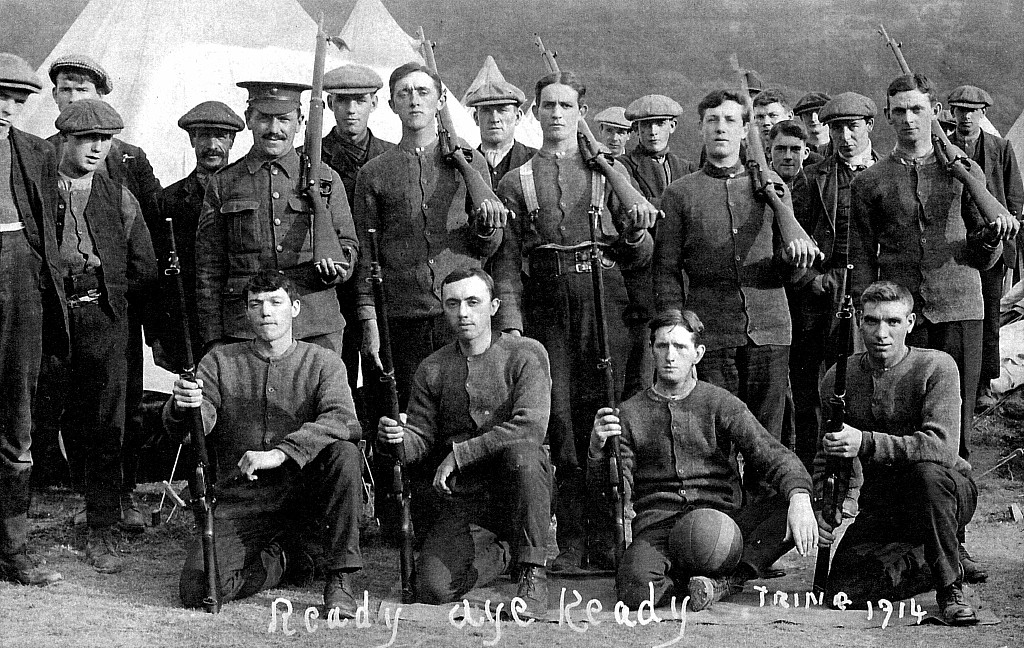
|
HAYWARD TO PRATT
WALTER HAYWARD
Private, 6th Australian Machine Gun Company, service number 462.
Born at St Leonards, Bucks. Son of Sarah and the late Charles
Hayward of 3 Henry Street, Tring.
Killed in action on the 4th May 1917 aged 22.
No known grave. Commemorated on the Villers-Bretonneux
Memorial, France.
Panel number, Roll of Honour, Australian War Memorial, 118.
Few personal details about Walter Hayward survive. He was born at St.
Leonards, Bucks., and was a Baptist by religion. At some stage
in his life he emigrated to Australia where he later enlisted in the
Australian Expeditionary Force (AIF) and returned with them,
briefly, to
England.
To transport the AIF to their various destinations, a fleet of transport ships was
leased by the Australian government. His Majesty’s Australian
Transport Ship (HMAT) A38, on which Private Haward sailed,
was owned by the China Mutual Steam Navigation Company of London and
in peacetime traded under the name Ulysses.
On the 25th
October 1916 Private Hayward’s unit embarked at Melbourne
(Victoria). The embarkation list shows his civilian occupation as labourer
and his address as c/o D.
McLennan, Mumbannar, via Heywood, Victoria.
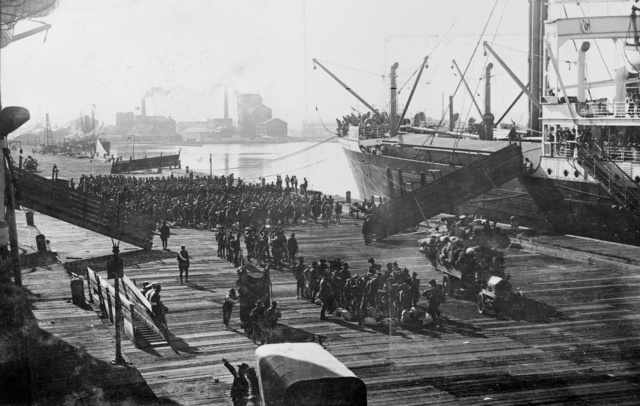
Australian troops embarking on the Ulysses.
The Ulysses departed that day for Durban, South Africa, which
she reached on the 13th November; Cape Town on the 19th November;
Freetown, Sierra Leone, on the 14th December; and Plymouth on the
28th December. On landing at Plymouth the unit entrained for Tidworth, which they reached later that day.
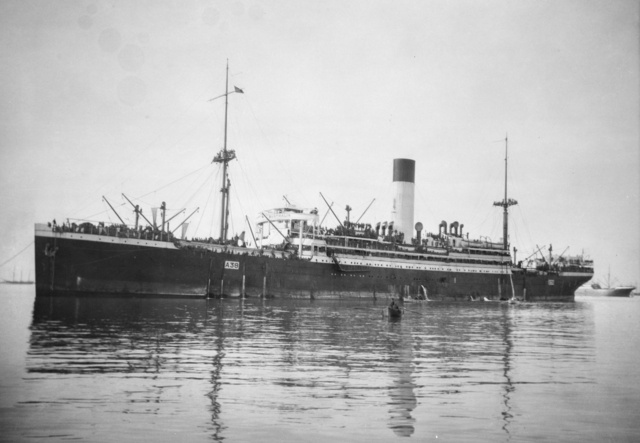
HMAT A38, Ulysses.
Five infantry divisions
[Note] of the AIF saw action in France and Belgium. Commencing in April 1916,
for the next two and a half years they participated in most of the
major battles on the Western Front, [Note] earning a formidable reputation.
The 6th Australian Machine Gun Company, to which Private
Hayward was attached, was formed in February 1916 as part of the
6th Australian Brigade. This consisted of four infantry
battalions — the 21st, 22nd, 23rd and 24th Battalion — all of which
were raised in Victoria. After being sent to Egypt in June
1915 with the 2nd Division, the
brigade then went to Gallipoli in September. However, as the
last Allied offensive had come to an end the previous month, from
then until December 1915 when the Anzacs were evacuated from the
peninsula, the brigade was not involved in any significant
engagements.
In 1916, the
6th Australian Brigade was transferred to the Western Front, [Note] where it
took part in trench fighting for the remainder of the war.
During this time it was involved in a number of major battles
including the Battle of Pozières (23rd July–3rd September 1916), the Battle of Mouquet Farm
(23rd July–3rd September 1916) – the latter two being Somme
actions – and
the Battles of Bullecourt (April and May 1917). It was also involved in beating back
the tide of the German Spring Offensive (21st March–18th
July 1918) [Note] before taking part
in the final campaign of the war, the Hundred Days
Offensive (8th August–11th November). [Note]
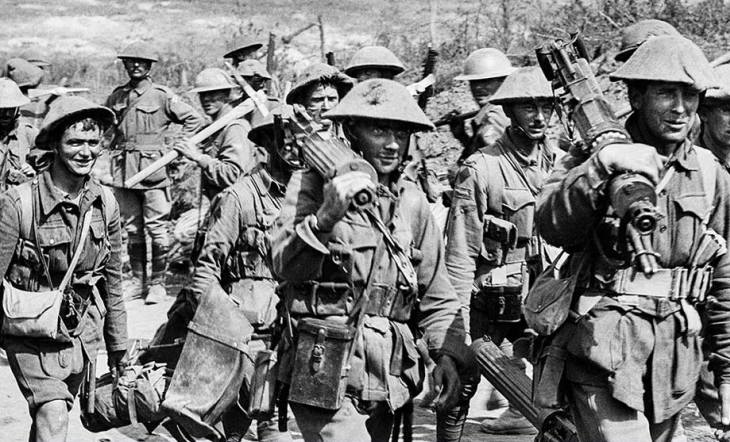
Above: 2nd Australian Division machine
gunners near Pozières, 1916.
Below: Members of an Australian Machine Gun
Company, 1917.
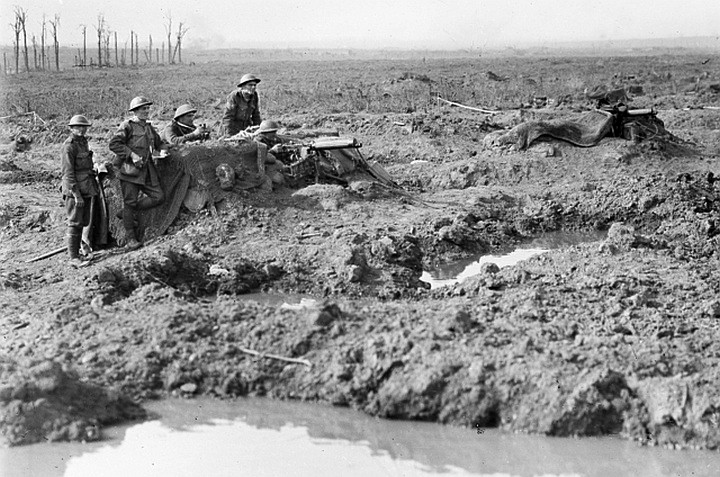
Judging by the date of Private Hayward’s death and the location of
his unit at that time, it seems likely that he was killed during the
fighting for control of Bullecourt, one of several heavily fortified
villages in northern France that in 1917 had been incorporated into
the defences of the Hindenburg Line. [Note]
Two battles for Bullecourt were fought. The first attack was
launched on the 11th April 1917 by the 4th Australian and 62nd
British Divisions. The attack was hastily planned and mounted,
and was a disaster. The two brigades of the 4th
Australian Division that carried out the attack (the 4th and 12th)
suffered over 3,300 casualties while 1,170 Australians were taken
prisoner, the largest number captured in a single engagement during
the war.
A further attack was mounted on the 3rd May by the Australian 2nd
Division (5th and 6th Brigades) and the British 62nd
Division. The Australians succeeded in penetrating the German
line, but met determined opposition. Renewed efforts on the
7th May succeeded in linking British and Australian forces.
The Germans then mounted a series of ferocious and costly
counter-attacks, which eventually failed, and on the 15th May they
withdrew from the remnants of the village.
Although the locality was of little or no strategic importance, the
actions were nevertheless extremely costly to the AIF, their
casualties totalling 7,482 from three Australian Divisions.
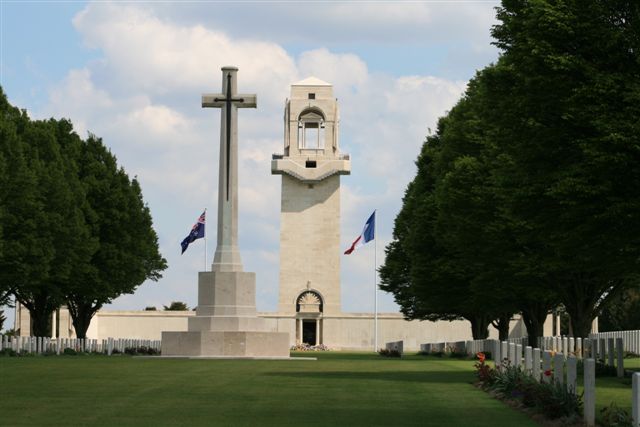
The Villers-Bretonneux Memorial is the Australian National Memorial
erected to commemorate all Australian soldiers who fought in France
and Belgium during the First World War, to their dead, and
especially to name those of the dead whose graves are not known.
The Australian servicemen named in this register died in the
battlefields of the Somme, Arras, the German advance of 1918 and the
Advance to Victory. The memorial stands within Villers-Bretonneux
Military Cemetery, which was made after the Armistice when graves
were brought in from other burial grounds in the area and from the
battlefields.
Of the 10,982 names displayed at the unveiling of the
Villers-Bretonneux Memorial the burial places of many have since
been identified and this continues to this day; 6 of these being
among the significant discovery of 250 burials which culminated in
the first new Commission cemetery in 50 years being dedicated in
July 2010 as Fromelles (Pheasant Wood) Cemetery. All these
discoveries are now commemorated by individual headstones in the
cemeteries where their remains lie and their details recorded in the
relevant cemetery registers; their names will be removed from this
memorial in due course.
――――♦――――
HERBERT HAZZARD
Private, 1st Oxfordshire and Bucks Light Infantry, service no. 3027.
Son of Selina Hazzard of 1 Miswell Lane, Tring.
Enlisted at Aylesbury. Killed in action on the 1st April 1916
aged 21.
Buried in Hebuterne Military Cemetery, France, grave ref. I. A. 17.
On the 30th March 1915, the 1st Battalion (Territorial Force) Ox and
Bucks Light Infantry mobilised for war and landed at Boulogne.
In May the formation became the 145th Brigade of the 48th (South
Midland) Division. They spent the greater part of this period
in trenches at Hébuterne − a village 15 kilometres north of Albert
(Somme) and 20 kilometres south-west of Arras − losing a few
officers and men and having a somewhat arduous time, but without
being seriously engaged with the enemy.
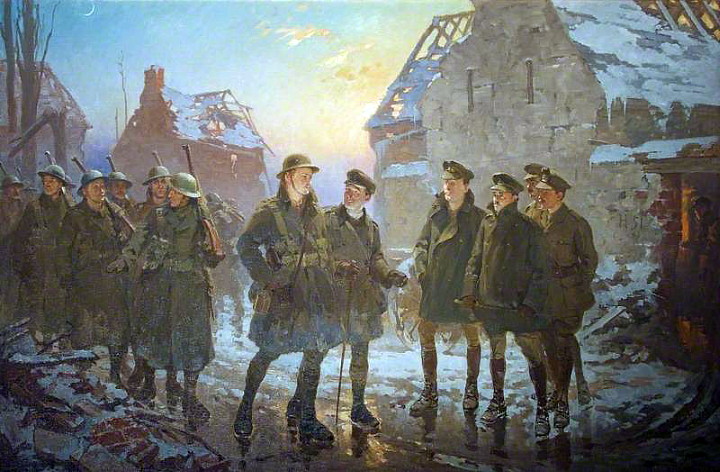
A Relieved Platoon of 1/5th Battalion,
Gloucestershire Regiment, at Hébuterne, France, c.1916.
Courtesy of the Cheltenham Trust and Cheltenham Borough Council.
Towards the middle of January 1916 the Battalion moved to take over
other trenches. These lay more to the S.E. of Hébuterne in
very much lower ground than their previous sector, and they found
them in a serious state of decay and rapidly falling in everywhere.
The result was that every man had to do his utmost with the spade to
bring about substantial improvement, and it was not long before a
marked change was achieved. However, efforts to keep open the
communication trenches were very difficult, for even in good weather
the results achieved were in not proportionate to the amount of
effort expended. Furthermore, the enemy artillery became ever
more active and their shooting was exceptionally good. This
accounted for a number of casualties.
During this period the enemy undertook several raids, but without
managing to enter the battalion’s trenches. These raids were
preceded by heavy bombardments, in which the trenches suffered
considerably, the more so when minenwerfers [Note]
were employed in large numbers, as their shells made the most
gigantic craters that completely obliterated all traces of dugouts
and trench. At the beginning of April 1916 the battalion was
relieved and took over trenches that, while in better condition,
were by no means good.
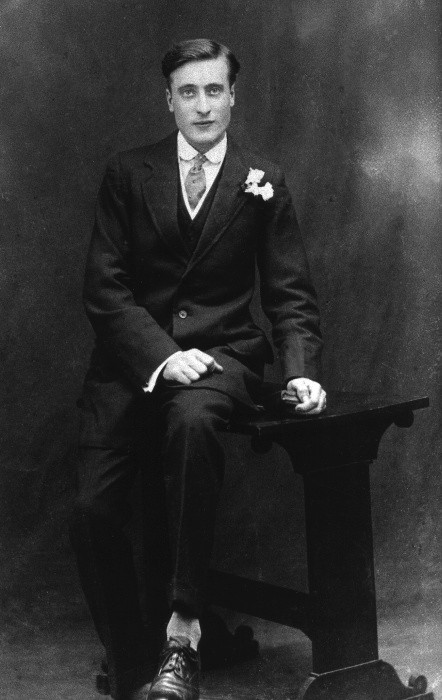
Herbert Hazzard (1895-1916)
As the weather began to improve, patrols were sent out more
frequently and brisk fighting in “No Man’s Land” resulted.
This from the regimental history:
“On Sunday 26th March 1916, the Battalion
moves in to ‘J’ section trenches at Hébuterne. On the night of
1st April a patrol of Bucks men encountered an enemy patrol of some
fifty soldiers in no mans land. In the ensuing skirmish L/CPL Colbrook , Privates Hazzard and Webb were killed. The bodies
of Webb and Hazzard lay for sometime between the enemy and our
positions. When darkness fell, L/CPL Jennings and six men
recovered the bodies but alas, Private Coleman was killed. Our
patrol was led by Captains Combs and Aitkin who remarked that the
men killed were regularly used for such patrols, because of their
expertise and bravery on such operations.
All of the soldiers mentioned in the Regimental Report, lie buried
next to each other in the cemetery which is situated on the edge of
the village next to a farm.”
During the war, 5,878 officers and men of the Oxfordshire and
Buckinghamshire Light Infantry lost
their lives. This from the Bucks Herald:
“The Great War. Another Tring Man
Killed in Action. − Tring’s Roll of Honour grows apace. Private
Herbert Hazzard, of Chapel Street, Tring, enlisted in the 1st Bucks
Territorials in November 1914, and has been in France twelve months.
Before joining the army Herbert Hazzard was working for Messrs
Honour and Son as a machinist. Last Thursday evening his
parents received intimation that their son had fallen in action.
Private Hazzard was well known in the town, where he was much liked,
being a young man of steady character and amiable disposition.
The circumstances attending his death are related in the following
letter to his father from the commanding officer of Private
Hazzard’s company.
‘2nd April 1916.
Dear Sir,− It is with very great regret and sorrow that I have to
write to you to acquaint you with the fact that your son, Private H.
Hazzard, of my company was killed in action last night. He was
out on patrol with a number of his comrades and two officers.
Our patrol met a large number of the enemy outnumbering us by more
than two to one. A fight ensued in which your son threw his
bombs with great effect. I am grieved to say that he was
killed instantly, by being struck on his head with a piece of bomb.
Your son was one of the best fellows in the world, and was
absolutely fearless, and always cheery. It was not the first
time by any means that your son had distinguished himself on patrol.
He received special commendation from the General commanding the
Division for his work during a patrol fight about a month ago.
Please accept my most sincere sympathy and the sympathy of all his
comrades, both officers and men, in your sad loss. I have lost
one of my best men in your son and I feel his loss most keenly.
Yours truly
L. W. Crouch, Captain.’” [Note]
Herbert Hazzard was born in Tring.
In the 1911 Census, he is recorded living with his parents Fred
(aged 53, a bricklayers’ labourer) and Selina at 18 Chapel Street,
Tring. His occupation is given
as “working in machine shop.”
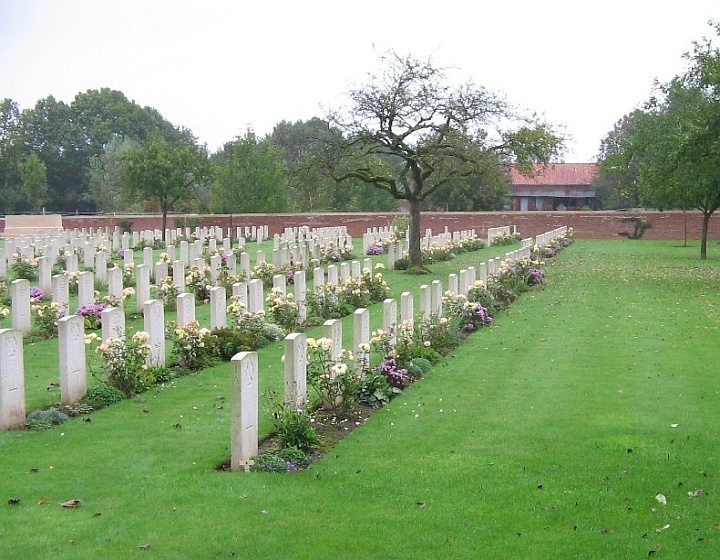
Herbert Hazzard is buried at the Hébuterne Military Cemetery.
The village of
Hébuterne gave its name to a severe action fought by the French on
the 10th-13th June 1915, in the “Second Battle of Artois”. It
was taken over by British troops from the French in the same summer,
and it remained subject to shell fire during the Battles of the
Somme. It was again the scene of fighting in March 1918, when
the New Zealand Division held up the advancing enemy, and during the
following summer it was partly in German hands.
There are now over 750, 1914-18 war casualties commemorated in this
site. Of these, nearly 50 are unidentified and special memorials are
erected to 17 soldiers from the United Kingdom, known or believed to
be buried among them.
――――♦――――
JOHN RUSSELL HEDGES
Private, 1st/5th Battalion Bedfordshire Regiment, service no.
201230.
Son of Elizabeth Hedges of 7 Parsonage Place, Tring.
Died of pneumonia (possibly of malaria [Note]) in the Lebanon on the 16th
November 1918 aged 26.
Buried in Beirut War Cemetery, Lebanon, grave ref. 312.
The long-established Bedfordshire Regiment was greatly expanded
during the First World War, elements of which were engaged on both
the Western Front [Note] and in the Middle East.
In January 1915, the 1st/5th Battalion was re-designated as part of the
162nd
(East Midland) Brigade in the 54th (East Anglian) Division. On
the 26th July the battalion set sail for Egypt. After a brief
stop-over they reached Gallipoli where the battalion served between
the 10th August and 4th December. In December, the pitifully
small number that remained were moved back to Egypt where, between
January and March 1916, the battalion were rebuilt. They then
undertook a year-long posting as guards to the Suez Canal.
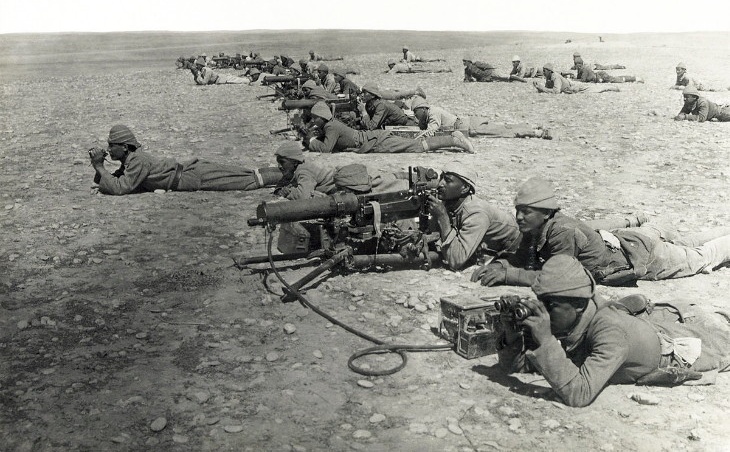
|
A Turkish machine gun
company during the 2nd Battle of Gaza (17th-19th April
1917). The 54th (East Anglian) Division took part in
this British defeat in which at 6,444 men, the British
casualty figure was three times that of the Turks. |
In March 1917, the battalion advanced to Gaza with the British and
Commonwealth forces where they took part in all of the actions both
there and in those that followed during the advance through
Palestine. [Note] By the time of the Armistice they were stationed at
Beirut, having spent the entire campaign in that theatre of war.
Soldiers in this theatre of war suffered considerably from diseases,
with the battalion losing considerably more men to that cause than
to enemy fire. This from the War Diary [Note] for
the 31st October 1918:
“Beirut 0746 Battn. moved with Bde. Group through BEIRUT. Bde.
halted outside town & prepared for a Ceremonial march through.
1030 Bde. Group less wheeled & camel transport marched through
BEIRUT. When in the SQUARE Corps Commander with other General
officers British & French took the salute. Troops were
received by populace with enthusiasm. Bde. bivouaced one mile E
of town. Troops allowed into town until 1900. Official
Wire received Re. Armistice between TURKEY and the ALLIES.
During the month an epidemic of fever has been experienced malarial
cases being numerous.”
During November alone the War Diary records 10
deaths from malaria. Although the Diary attributes
Private Hedges’ death to pneumonia, there can be striking clinical
similarities between it and malaria, which − presumably based on
correspondence received by Mrs. Hedges from the Regiment − is the
cause of death reported in the Bucks Herald.
From the
Regimental War Diary for November 1918:
16 Nov 1918 Physical training 0800-0830.
Working parties engaged on stables. A & B Coys amalgamated to
form Y Coy. C & D coys to form Z Coy. Half holiday in
afternoon.
[Private 201230 J. R. HEDGES died of
Pneumonia at 1/2nd East Anglian Field Ambulance, Beirut].
17 Nov 1918 Bde. Church Parade 0900. Pte. Hedges buried
at MAR TATLAR at 1300 with Military Honours.
From the Bucks Herald, 14th November 1918:
“ROLL OF HONOUR.
− News has been received of the death of . . . . Pte. John Russell
Hedges, son of Mrs. Robert hedges, Parsonage Place, is reported to
have died of Malaria in Egypt on Nov. 16, at the age of 25 years.”
From the Tring Parish Magazine:
“News has been received of the death,
through pneumonia of John Russell Hedges, in a field ambulance in
Palestine, on November 16th 1918. He joined up in January 1915
and was attached to the Bedfordshire regiment. After a years
training in England, he went to Egypt, and served all through the
campaign in Palestine. His Chaplain, writing to his mother,
says: ‘we laid your son to rest at Martatlar near Essafa, on a
gentle slope overlooking the sea and his funeral (with Military
Honours) was a most impressing one.
His death made a great impression among his fellows. He was
liked very much for his quiet and gentle manners. The times
have been strenuous of late, and he was a hard and uncomplaining
worker, and we are glad we can keep the memory of your son’s
devotion, and the inspiration of his sacrifice.’”
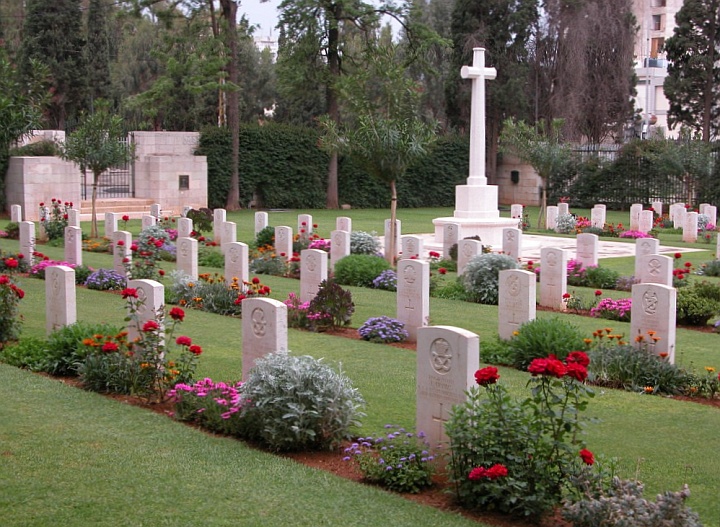
Beirut War Cemetery
Lebanon was taken from the Turks in 1918 by Commonwealth forces with
small French and Arab detachments. Beirut was occupied by the
7th (Meerut) Division on 8 October 1918 when French warships were
already in the harbour, and the 32nd and 15th Combined Clearing
Hospitals were sent to the town. There are 628 First World War
Commonwealth burials and commemorations at the cemetery.
――――♦――――
SIDNEY WALTER HEDGES
Lance Corporal, 6th Northamptonshire Regiment. Enlisted at
Watford, service no. 28398.
Born in Tring. Son of the late Thomas, and of Susanna
Elizabeth Hedges of 55 Western Road.
Died of wounds on the 16th April 1918 aged 21.
Buried in Rosieres Communal Cemetery Extension, France, grave ref. II.A.9.
The Northamptonshire Regiment was a British line infantry regiment
that existed from 1881 until 1960. In the years
that followed, amalgamations with other regiments took place in
which it was absorbed
into the present Royal Anglian Regiment.
6th (Service) Battalion, [Note]
Northamptonshire Regiment was raised at Northampton in August 1914
as part of Kitchener’s Second New Army [Note]
and joined 18th (Eastern) Division as army troops. They
moved to Colchester for training and in November (transferring to
the 54th Brigade in the same Division) before moving to
Salisbury Plain in May 1915 for final training. On the 26th
July 1915 it landed in France where the division concentrated near Flesselles. |
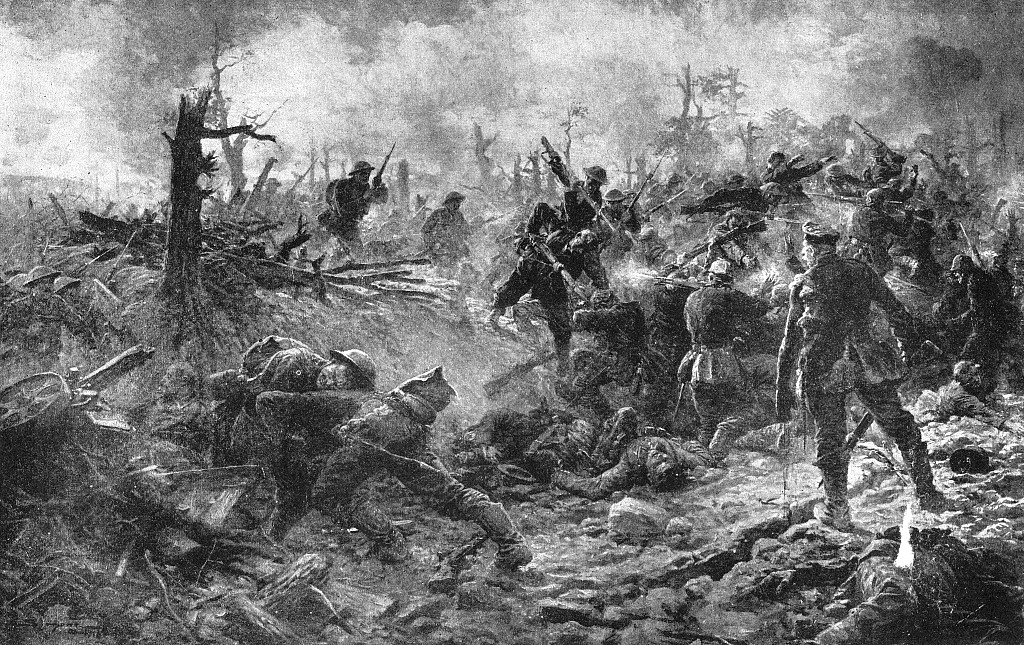
Artist’s impression of savage hand-to-hand fighting
in Delville Wood.
|
In 1916 the battalion was in action on the Somme in the Battle of Albert
capturing their objectives near Montauban, the Battle of Bazentin
Ridge including the capture of Trônes
Wood, the Battle of Delville Wood, the Battle ofThiepval Ridge, the
Battle of the Ancre Heights playing a part in the capture of the
Schwaben Redoubt and Regina Trench and the Battle of the Ancre.
In 1917 they took pait in the Operations on the Ancre including
Miraumont and the capture of Irles, the fought during The German
retreat to the Hindenburg Line [Note] and in the Third Battle of the Scarpe
before moving to Flanders. They were in action in the Battle of Pilkem Ridge,
the Battle of Langemarck and the First and Second
Battles of Passchendaele.
In 1918 they saw action during the Battle of St Quentin, the Battle
of the Avre, the actions of Villers-Brettoneux, the Battle of Amiens
and the Battle of Albert where the Division captured the Tara and Usna hills near La Boisselle and once again captured Trônes
Wood. They fought in the Second Battle of Bapaume, [Note] the Battle of Epehy,
the Battle of the St Quentin Canal, the Battle ofthe Selle
and the Battle of the Sambre. At the Armistice the battalion was in
XIII Corps Reserve near Le Cateau and demobilisation began on the
10th of December 1918.

British troops captured during the
Spring Offensive, March 1918.
During the early stage of the 1918 German Spring Offensive, [Note]
the 6th battalion formed part of the 5th Army (Lieut. General
Gough), but following the Battle of St Quentin (21st–23rd March)
it was moved to the 4th Army (General Sir Henry Rawlinson)
with which it was engaged in the Battle of the Avre (4th-5th April).
Private hedges is reported to have been killed during the Spring
Offensive (see Parish Magazine obit below), but as the date
on which he was wounded is unknown, it is unclear in which action he
was involved at the time. It might have been in either of the
two actions referred to, although he may have been wounded and
captured on some other occasion between the start of the Offensive
(21st March) and his date of his death (16th April).
From the Tring Parish Magazine:
“Sidney Walter Hedges, L/CPL, 6th Northants
Regt joined the army in October 1916 and went to Halton Camp for
three months training. He then immediately proceeded to France
where he remained until his death. He was, apparently,
severely wounded during the German offensive of the spring and was
taken prisoner by the enemy. He died in a German Field Reserve
Hospital on April 16th and was buried in a cemetery reserved for
prisoners.
He leaves behind him a pleasant memory in Tring, and has died, as we
are sure he would have wished to die. gallantly, doing his duty to
his king and country.”
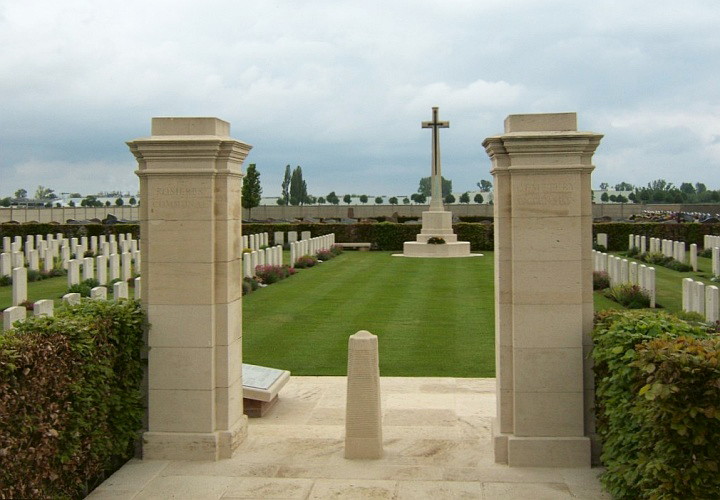
Rosieres Communal Cemetery Extension
Rosieres was the scene of heavy fighting between the French Sixth
Army and the German First Army at the end of August, 1914. It
came within the British lines in February 1917. With the
advance to the Hindenburg Line in the spring of 1917, Rosieres
became part of the back area; but in the German Offensive of 1918 it
was reached by the enemy on the 26th March. In the Battle of
Rosieres on the 27th it was defended by the 8th Division and
the 16th Brigade, Royal Horse Artillery, [Note] but these troops had to be
withdrawn during the night. After a stubborn defence the
village was retaken by the 2nd Canadian Division with Tanks on the
9th August. There are now over 400, 1914-18 war casualties
commemorated in this site of which over one-third are unidentified.
――――♦――――
JOSEPH HORN
Private, 2nd Middlesex Regiment, service no. 29517.
Born in Tring. Husband of Elizabeth Horn of 81 Brook Street,
Tring.
Enlisted at Bedford on the 30th May; killed in action on the 17th
November 1916, aged 31.
Buried in Guillemont Road Cemetery, Guillemont, France, grave ref.
I. F. 2.
The Middlesex Regiment (Duke of Cambridge’s Own) was a line infantry
regiment of the British Army in existence from 1881 until 1966.
It was formed on the 1st July 1881 with two regular, two militia and
four volunteer battalions.
On the 4th August 1914, the 2nd Battalion, which had been stationed
at Malta, returned to England. It then landed at Le Havre in
November as part of the 23rd Brigade,
8th Division, [Note] to provide badly-needed reinforcement to the B.E.F. [Note].
The 8th Division had been formed at the outbreak of war by combining
battalions returning from outposts in the British Empire,
Major-General Francis Davies taking command. The division
moved to France in November, following the First Battle of Ypres, and
fought on the Western Front [Note] for the remainder of the war.
During this time the 2nd Battalion Middlesex Regiment was engaged in
the following actions:
1915; The Battle of Neuve Chapelle, The Battle of Aubers, The action
of Bois Grenier;
1916; The Battle of Albert (the first phase of the Battles of the
Somme 1916), operations near Le Transloy;
1917; The German retreat to the Hindenburg Line, [Note] Third Battles of
Ypres (The Battle of Pilkem and The Battle of Langemarck, The Battle
of the Menin Road);
1918; The Battle of St Quentin, The actions at the Somme crossings,
The Battle of Rosieres, The actions at Villers-Bretonnex, The Battle
of the Aisne, The Battle of the Scarpe and the Final Advance in
Artois including the capture of Douai. They ended war (11th
November) at Douvrain in Belgium, N.W. of Mons.
During the Somme Offensive, the 2nd Middlesex Regiment served with
the 23rd Brigade, 8th Division. The battalion
had arrived on the Somme front in 1915 and spent many months there in
the lead up to the battle. On 1st July 1916 they took part in
the attack at Mash Valley near Ovillers (during The Battle of
Albert, 1st–13th July) suffering more than 650 casualties on that
day.
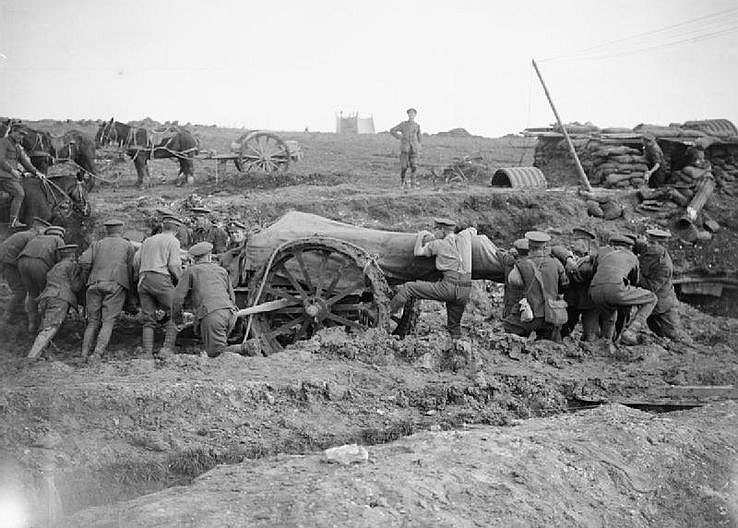
Moving a 60-pdr field gun into position
during the Battle of Le Transloy, October 1916.
This from the Parish Magazine:
“Joseph Horn was killed alongside five
others, by a shell which burst in his dug-out. He joined the
Army on 30th May 1916 and had been in France since September 1917.”
In October 1916, the battalion returned to the Somme and took part
in operations near Le Transloy, losing more than 230 casualties in
bitter hand to hand fighting at Zenith Trench. This action,
which was the 4th Army’s last offensive in the Battle of the Somme,
ended in the middle of October after which the 2nd Battalion appears
not to have
played a part in any significant actions for the remainder of 1916.
Thus it seems reasonable to assume that Private Horn was killed during intermittent
periods of artillery fire. |
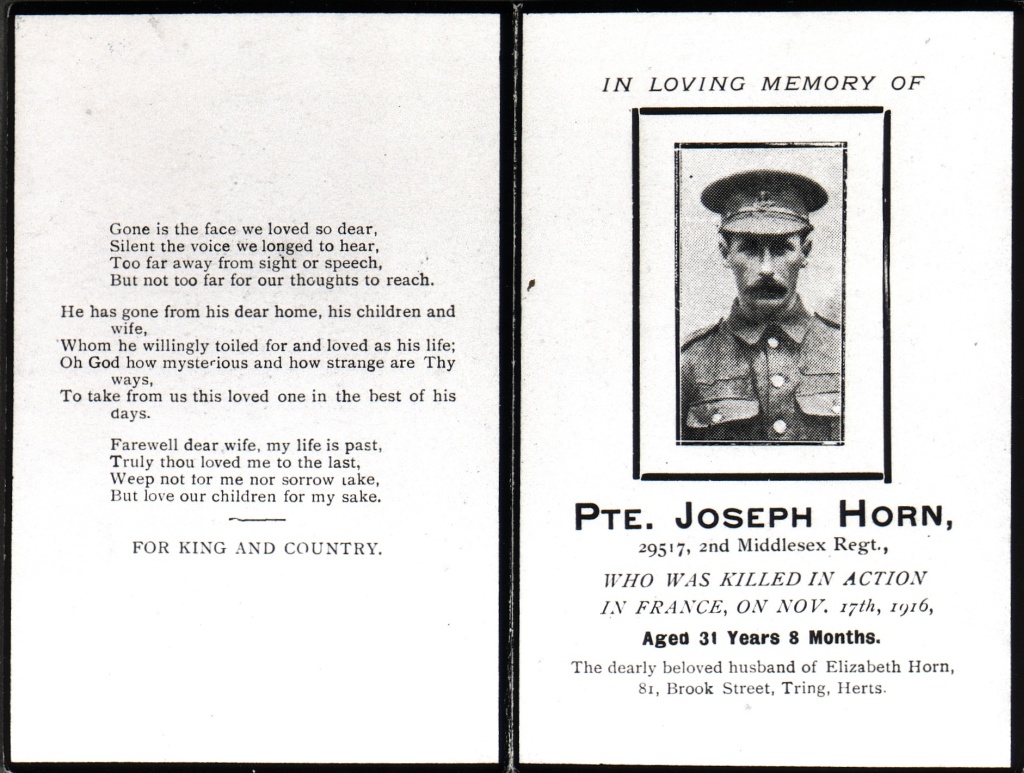
Joseph married Elizabeth Hart (aged 24) of 37 Akeman Street,
daughter of Frederick Hart (labourer), on the 7th January 1909.
Joseph (aged 23), the son of James Horn, a boot-maker, who was then
living at 80 Brook Street, gave his profession as “carman”
(this being a driver of horse-drawn vehicles for transporting
goods).
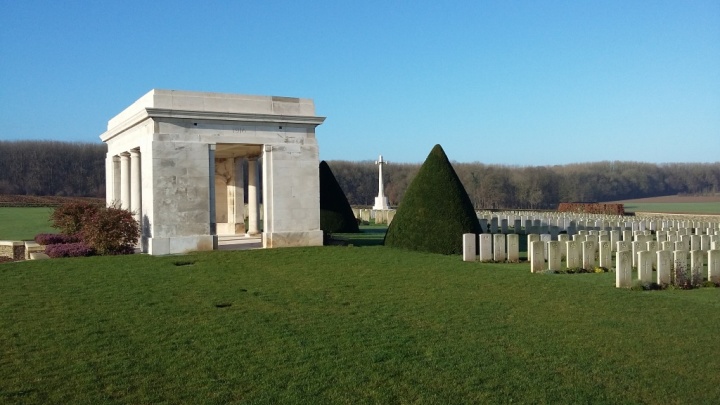
Guillemont was an important point in the German defences at the
beginning of the Battle of the Somme in July 1916. It was
taken by the 2nd Royal Scots Fusiliers on the 30th July but the
battalion was obliged to fall back, and it was again entered for a
short time by the 55th (West Lancashire) Division on the 8th August.
On the 18th August, the village was reached by the 2nd Division, and
on the 3rd September (in the Battle of Guillemont) it was captured
and cleared by the 20th (Light) and part of the 16th (Irish)
Divisions. It was lost in March 1918 during the German
advance, but retaken on the 29th August by the 18th and 38th (Welsh)
Divisions.
The cemetery was begun by fighting units (mainly of the Guards
Division) and field ambulances after the Battle of Guillemont, and
was closed in March 1917, when it contained 121 burials. It
was greatly expanded after the Armistice when graves (almost all of
July-September 1916) were brought in from the battlefields
immediately surrounding the village and certain smaller cemeteries.
Guillemont Road Cemetery now contains 2,263 Commonwealth burials and
commemorations of the First World War, 1,523 of which are
unidentified, but there are special memorials to eight casualties
known or believed to be buried among them.
――――♦――――
CHARLES FREDERICK HOWLETT
Private, 8th Lincolnshire Regiment, service no. 41722.
Son of Frederick Charles and Emma of
Western Road, Tring.
Enlisted at Aylesbury, formerly with the RASC.
Killed in action on the 4th October 1917 aged 22.
No known grave. Commemorated on the Tyne Cot Memorial,
Belgium,
panel
35 to 37 and 162 to 162A.
The 8th Lincolnshire Regiment was established on the 15th September
1914 as part of K3. [Note] At the
outbreak of war all the battalion commanders had been in retirement
− of the 21st Division, to which the 8th Lincolns were attached,
only 14 officers had any previous experience in the Regular army.
The 8th Lincolns formed part of the 63rd Brigade,
21st Division in XI Corps. [Note]
The Battalion trained at Grimsby during August and at Halton Park
near Tring in November. During the winter of 1914 they moved
into billets at Leighton Buzzard, but in the following spring
returned to Halton Park Camp where they commenced rifle practice. |

Training at Halton Camp.
|
On the 10th September 1915 the battalion landed at Boulogne, its
compliment being 28 officers, 2 personnel, and 993 Other Ranks.
Having stayed in the Watten area for a week, the battalion set off
for the front and The Battle of Loos. In this, their first
action, lack of battlefield experience quickly showed resulting in
many unnecessary casualties − following the action 22 of their 24
officers and 471 other ranks were dead, wounded or missing.
The battalion was then taken out of the line and into billets to
receive replacements and for training, periods of work on trench
defences, periodical tours of the trenches and working parties.
July 1st 1916 marked the beginning of The Battle of the Somme.
The 8th Battalion attacked at Fricourt, their casualties being
Officers − 4 dead, 1 missing, 7 wounded; Other ranks - 30 dead, 12
missing, 197 wounded.
On the 8th July the battalion was transferred to the
110th
Brigade, 37th Division. Their next in action was in
the Battle of Ancre (13th-20th November) in which casualties were 3
officers and 172 other ranks.
During 1917 the battalion was in action during The German retreat to
the Hindenburg Line, [Note] The Arras
Offensive (The First & Second Battles of the Scarpe and The Battle
of Arleux), the The Third Battles of Ypres (The Battle of Pilkem
Ridge, The Battle of the Menin Road Ridge, The Battle of Polygon
Wood, The Battle of Broodseinde, The Battle of Poelcapelle, The
First Battle of Passchendaele) and The Cambrai Operations.
Judging by the date when Private Howlett was posted missing and the
8th Battalion’s involvement in fighting in October 1917, it appears
likely that he was killed in action during The Battle of Broodseinde.
This action was fought on the 4th October near Ypres in
Flanders. The attack aimed to complete the capture of the
Gheluvelt Plateau by the occupation of Broodseinde Ridge and
Gravenstafel Spur, the objective being to protect the southern flank
of the British line and permit attacks on Passchendaele Ridge to the
north-east. Using new ‘bite and hold’ tactics the capture of
the ridges was a great success, General Plumer (C-in-C 2nd Army)
calling the attack “. . . . the greatest victory since the Marne”
while the German Official History referred to “. . . . the black
day of October 4”. 2nd Army casualties for the week ending
the 4th October were 12,256.
Their War Diary records that on the 1st October the
Battalion was in the Front line (Battalion H.Q. at Het Papotje Farm)
and on the 4th October they attacked Jute Cotts, Bury
Cotts etc. Casualties were 8 officers, 181 other
ranks. The following extract from the Battalion History
describes the action in which, judging by the date on which Private Howlett
was posted missing and the 8th Battalion’s involvement in fighting
at that time, it seems likely that he fell:
THE HISTORY
of the
LINCOLNSHIRE REGIMENT
1914-1918
Compiled from War Diaries, Despatches,
Officers’ Notes and Other Sources
Edited by
MAJOR-GENERAL C. R. SIMPSON, C.B.
COLONEL OF THE REGIMENT
The Battle of Broodseinde: 4th October
“During the evening of the 3rd of October the fine weather broke: a
heavy gale and rain blew up from the south-west. Under such
adverse conditions arrangements were made for the next battle.
The attack took place at 6 a.m. on the 4th of October, and was
directed against the main line of the ridge east of Zonnebeke.
The front of the principal attack extended from the Menin road to
the Ypres-Staden railway — a distance of about seven miles.
Only a short advance, with the object of capturing certain strong
points was to take place south of the Menin road.
Two battalions of the Regiment — the 1st and 8th Lincolnshire — took
part in the Battle of Broodseinde, the former attacking the
enemy near the south-western corner of the Polygon Wood, the latter
south of the Menin road.
The 8th Lincolnshire was the left attacking battalion of the 63rd
Brigade (37th Division): the 8th Somerset was on its right.
The brigade had been but a short while in the line, having relieved
the 118th Brigade on the night of the 27th/28th of September.
The position taken over was supposed to be the line of a road
running north and south through Jute Cotts (a farmhouse south
of Tower Hamlets), but the actual line was found to be about one
hundred and fifty yards west of the road and in places even more.
And even this road had been obliterated by shell-fire. No
movement was possible during the day and reconnaissance was
extremely difficult. Even runners as soon as they left
Battalion Headquarters were sniped. However, after offensive
operations had been ordered, some sort of a reconnaissance was
carried out and the road was then found to be the German outpost
line, with strong points behind it.
The Somerset and Lincolnshire formed up under the greatest
difficulties, and at 6 a.m. attacked the enemy. But from the
time they left their assembly positions both battalions came under
murderous machine-gun fire.
The only comment made by the 8th Lincolnshire in their Battalion
Diary is ‘Attack unsuccessful,’ while the 63rd Brigade narrative has
the following: ‘On the left the 8th Lincolnshire advanced and, after
going about one hundred yards, came under fire of several
machine-guns which swept the slope. Two of these appeared to
be between the road and Joist Trench and another at Berry Cotts.
These guns inflicted very heavy casualties on the leading companies.
The enemy, about one hundred strong, were occupying the trench about
fifty yards east of the Jute Cotts road and were reinforced from
Joist Trench. The enemy also made local counter-attacks, but
it was entirely due to the machine-gun fire that the attack was held
up here. Owing to the whole plateau being swept by these
machine-guns and also by the machine-guns from the south, it was
decided that the attack could not get over the ground and, owing to
casualties, the original line was occupied.’
On the 5th the Lincolnshire advanced their posts north of Jute Cotts
to within fifty yards of the German line, and on this line they were
relieved on the 6th of October, returning to Little Kemmel.
The Brigade Diary gives one hundred and eighty-four as the total
casualties suffered during the operations: Captain R. G. Cordiner,
Lieutenant A. F. Forge and 2nd Lieutenants R. H. Westbury, W. R.
Gibson and F. H. J. Robilliard were killed and 2nd Lieutenants E. H.
Dukes and H. E. K. Neen wounded.”
This from the Parish Magazine:
“Charles Frederick Howlett, Lincolnshire Regiment who has been
missing since 4th October 1917, is now presumed killed on that date. He was engaged alongside his battalion in the fighting about Polygon
Wood. He was last seen by his Corporal, going over the top, and has
not been seen since. Also, there is nobody left who could tell what
happened to him subsequently.”
Charles, the eldest child (he had two sisters and seven brothers) of
Frederick and Emma Howlett, was born in Aylesbury in 1895. He
sang in the Tring Parish Church Choir for some nine years and was
confirmed as a chorister. In October 1915 he joined the Royal Army Service Corps in his trade as a baker.
In January 1917 he was transferred to the
Infantry and was sent to France in the following May, where he joined the 8th
(Service) [Note] Bn.
Lincolnshire Regiment.
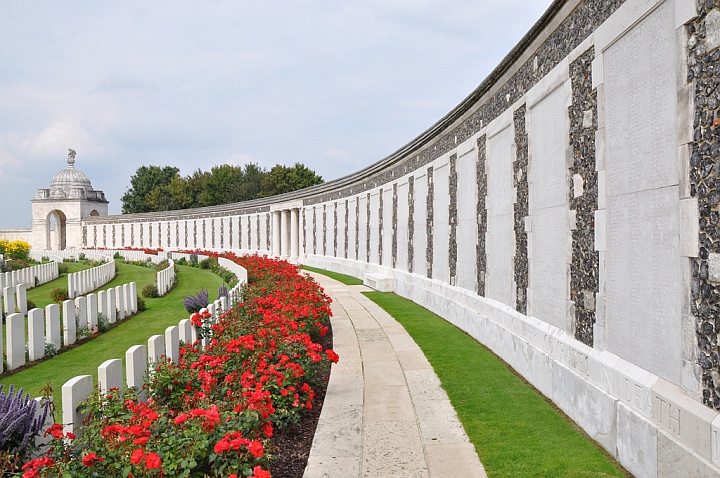
The Tyne Cot Memorial is one of four memorials to the missing in
Belgian Flanders which cover the area known as the Ypres Salient.
Broadly speaking, the Salient stretched from Langemarck in the north
to the northern edge in Ploegsteert Wood in the south, but it varied
in area and shape throughout the war.
There was little more significant activity on this front until 1917,
when in the Third Battle of Ypres an offensive was mounted by
Commonwealth forces to divert German attention from a weakened
French front further south. The initial attempt in June to
dislodge the Germans from the Messines Ridge was a complete success,
but the main assault north-eastward, which began at the end of July,
quickly became a dogged struggle against determined opposition and
the rapidly deteriorating weather. The campaign finally came
to a close in November with the capture of Passchendaele.
The Tyne Cot Memorial now bears the names of almost 35,000 officers
and men whose graves are not known.
――――♦――――
HENRY JANES
Corporal 1st Royal Marine Light Infantry, service no. PO/17361.
Son of Job and Ruth Janes of 33 Kimberley Terrace, Wingrave Road,
New Mill.
Killed in action on the 17th February 1917 aged 23 years.
Buried at Queens Cemetery, Bucquay, France, grave ref II M 10.
|
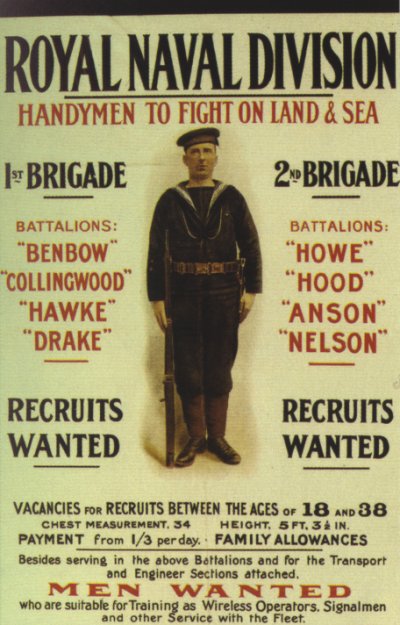 |
|
Recruiting poster for the
Royal Naval Division, c.1914/1915. |
At the outbreak of the war the
Royal Naval Division was formed from Royal Navy
and Royal Marine reservists and volunteers − some 20-30,000 men − who were not needed for
service at sea. This was sufficient to form two Naval Brigades
and a Brigade of Marines for operations on land.
The Division fought at Antwerp in 1914 and at Gallipoli in 1915.
In 1916, following many losses among the original naval volunteers,
the Royal Naval Division was transferred to the British Army as the
63rd (Royal
Naval) Division, under which title it fought on the Western Front
[Note] for
the remainder of the war. During this time the 63rd took part,
during 1916, in the Battle of the Ancre
(13th–18th November); in 1917, in the Actions of Miraumont (17th–18th
February); Battle of Arras (9th April–16th May); Second Battle of
Passchendaele (26th October–10th November); Action of Welsh Ridge
(30th December); and, in 1918, in the Battle of St. Quentin (First Battle of Bapaume) (24th–25th March)
[Note]; Battle of Albert (21st–23rd August);
Hundred Days Offensive (8th August–11th November) [Note].
Judging from the date of Corporal Janes’s death (17th February 1917)
and the location of his unit at the time, it appears likely that he
was killed during The Actions of Miraumont (17th–18th
February, 1917).
The 63rd (Royal Naval) Division had two battalions of Royal Marine
Light Infantry, the 1st (1RMLI) and 2nd, both of which formed
part of the 188th Brigade. Due to the serious casualties it
suffered at the Battle of Ancre in November 1916, 1RMLI was
withdrawn from the front line to be rebuilt as a fighting unit.
Although the Battle of the Somme officially ended on the 18th
November 1916, the slaughter continued in the New Year as the higher
command demanded that the line be advanced. In early 1917, the
5th Army planned a series of attacks to improve its positions, the
first of which was carried out on the 17th February. The main attack
south of the Ancre [Note] was to be
carried out by the 99th Brigade (2nd Division) and 53rd and 54th
Brigades (18th Division). 6th Brigade (2nd Division) was to
attack in support on the right, while 63rd (Royal Naval) Division on
the left was to advance north of the Ancre. Success would give
the British command of the approaches to Pyrs and Miraumont, and
observation over the upper Ancre Valley. The attack was
officially named The Actions of Miraumont.
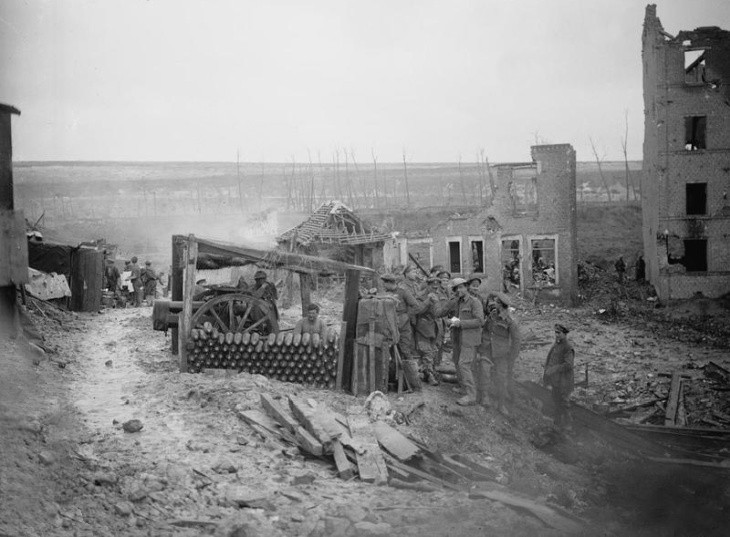
Royal Field Artillery [Note]
howitzer
emplacement at Miraumont-le-Grand, 1917.
The 63rd (Royal Naval) Division objective was to capture 700 yards
of the road north from Baillescourt Farm towards Puisieux, to gain
observation over Miraumont and to form a defensive flank on the left
back to the existing front line. On the evening of 16th
February, 1RMLI assembled for the attack, but based on
intelligence they had received, at 0500 the Germans brought down an
artillery barrage on the 1RMLI assembly area resulting in the
battalion suffering more than 50% casualties before their attack even
began. Despite this setback, the surviving Marines began their
advance at 0545 under the cover of a British artillery barrage under
the cover of a British artillery barrage. In the confusion of
battle and with the difficultly in navigating, the two left hand
companies veered towards the right, by pure chance avoiding intact
barbed wire. Thus, the sector they attacked had no wire at
all, and
by 1100 1RMLI had achieved their objectives. Their starting
strength was around 500; at the end of
the day’s fighting only 100 personnel were fit for duty, most of the
casualties having resulted from the initial German artillery
bombardment. Few men were killed in the assault itself in
which they encountered little opposition.
Corporal Janes was killed in action of the 17th February 1917.
This from his battalion’s War Diary for that period.
The Battalion was then in the RIVER TRENCH SECTOR, North of Grandcourt
(a commune in the Somme department in northern France):
“14.2.17: The 1st Royal Marines relieved the 10th Royal Dublin
Fusiliers in the RIVER TRENCH SECTOR, N of Grandcourt. B & D
Companies Hd. Qrs. in Pusieux Trench. Battalion Hd. Qrs. PUSIEUX
ROAD. Capt. Nouse to 2nd Field Ambulance (Influenza).
Casualties 2 killed - 1 offr (2nd Lt. Lee) and 9 Other Ranks
wounded.
15.2.17: Relief completed 3.0am. Casualties 6 killed - 3
missing - 9 wounded.
16.2.17: Battalion Hd. Qrs. moved forward to PUSIEUX TRENCH.
Battalion lined up for attack at 10.0pm. Objective SUNKEN ROAD
- L32C 91 to RCa26 including two strong points, that on the right
being known as the PIMPLE. Posts had to be established 50
yards beyond the Road.
Howe Battalion to attack on our right
- 2nd R.M. Battalion held ARTILLERY ALLEY and protected left flank.
ANSON Battalion held position R2d75 - R3c37 - R3c63. The
following officers were with the Battalion in the attack.
Lieut. Col. F. J. W Cartwright, D.S.O., Major H. Ozanne (wounded),
Major F. H. B. Wellesley, West Riding Regiment (wounded),
Captain E. J. Huskisson, Captain J. Pearson, Lieut. H. W. R. Hall,
Lieut A. C. Donne (wounded), Lieut. L. W. Robinson
(killed), 2nd Lieut. A. A. Okell (killed), 2nd Lieut. F.
Savage (killed), 2nd Lieut. E. Sanderson (wounded),
2nd Lieut. C. R. Burton (killed), 2nd Lieut. C. L. Rugg
(severely wounded), Lieut. E. G. Coulson (killed), 2nd
Lieut. W. C. Gudliston (wounded), Lieut. R. E. Champness,
Lieut. F. W. A. Perry (killed), 2nd Lieut. H. C. Brown
(killed), Surgeon Unthank R.N.
17.2.17: Advance commenced at 5.45am, on barrage
[Note]
opening. Our dispositions were, from right to left D, B, C, A
companies were extended at 2 paces interval, & in two waves at 20
paces distance. The lines were subjected to heavy bombardment by
77mm. at about 5.00am necessitating a call for retaliation by our
Artillery. [Note]
Reports received at 6.40am to effect that the Battalion had gained
their objective, and that the PIMPLE had been captured. 102
prisoners were taken, 1 77mm gun, & 2 machine guns were captured.
18.2.17: The enemy counter attacked on three
occasions. On one occasion taking advantage of thick mist, he
counter attacked, without artillery preparation, 2 battalions
strong, on 1½ mile frontage. S.O.S. message was sent, the
artillery replying with great promptitude, causing many casualties.
The battalion on the left turned and fled, and was almost
immediately followed by the right battalion. The line from
Battalion Hd. Qrs. to front line had only just been repaired when
S.O.S. was asked for.
Total casualties suffered by the Battalion in the attack, capture
and consolidation of the objective – SUNKEN ROAD. Officers – 7
killed, 6 wounded. Other ranks – 57 killed, 193 wounded, 27 missing.
19.2.17: 1st R. M. Battalion relieved in the line
during the night of the 18th/19th Feb. by 2nd R. M. Battalion.
Relief completed 7.0am. Companies moving independently to old
German 2nd and 3rd lines – Q18a30 – 1500 yards SSE of
BEAUMONT HAMEL. Major Ozanne to Field Ambulance.”
The Action of Miraumont forced the Germans to begin their withdrawal
from the Ancre valley before their planned Retreat to the
Hindenburg Line. [Note]
On the 24th February, reports arrived that the Germans had gone,
while further south their positions around Le Transloy were found
abandoned on the night of 12th/13th March. Allied troops
entered Bapaume [Note] on the 17th
March.
From the
Bucks Herald, 31st March 1917:
“THE ROLL
OF HONOUR. − The parish has to mourn
the loss of two more of her sons, who have laid down their lives for
their country’s cause ‘somewhere in France’ − Henry Janes, a
corporal in the Royal Marine Light Infantry, son of Mr. J. Janes, of
Wingrave-road, and Pte. Frank George Wilkins, son of Mr. Geo.
Wilkins, King-street.”
From the Parish Magazine, April 1917:
“Henry Janes must have done well to have
attained the rank of Corporal in such as body as the Royal Marines.
He served throughout the campaign in Gallipoli and came out
unscathed. However, he was killed in action on the 17th
February 1917, somewhere in France. May god accept what he has
given.”
Ruth Collyer married Job Janes in 1876 when she was 22 years old.
The 1901 Census records her and her family living at 1, The Grove,
Tring. Her husband, Job Janes (then aged 48) is recorded as a
domestic gardener. Their son Henry was born at Tring on the
27th February 1893. In 1901 the Census records him living with his parents,
brother (Robert, aged 14, a grocer’s assistant) and 3 sisters (Amy,
aged 12; Emily, aged 10; and Ethel May, aged 6). Also living
at the address was a grandson, Albert (born at Pitstone), then a
baby.
Ten year later the family was resident at 33 Wingrave Road. In
the Census of that year none of the girls are recorded at living that
address, but Robert (grocer’s assistant) and Henry (apprentice
whitesmith) continued to reside there with
their parents, and with grandson Albert (a scholar).
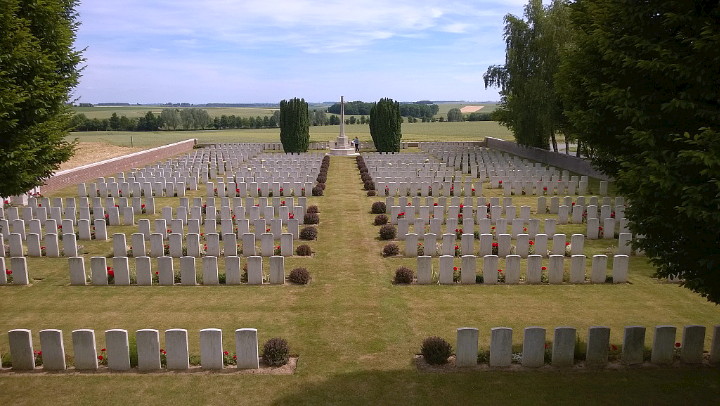
Queens Cemetery, Bucquay, France, was begun in March 1917, when 23
men of the 2nd Queen’s were buried in what is now Plot II, Row A.
Thirteen graves of April-August 1918 were added (Plot II, Row B) in
September 1918 by the 5th Division Burial Officer. The
remainder of the cemetery was made after the Armistice by the
concentration of British and French graves and one American from the
battlefields of the Ancre and from small cemeteries in the
neighbourhood. These included, at Puisieux, the River Trench
Cemetery (containing the graves of 117 officers and men) and the
Swan Trench Cemetery (containing the graves of 27 officers and men),
in both cases mostly of men of the Royal Naval Division who fell in
February 1917.
――――♦――――
FREDERICK
KEMPSTER
Rifleman, 7th Royal Irish Rifles, service no. 41863.
Born in Tring. Husband of Rose Kempster, 76 Akeman Street,
Tring.
Enlisted at Tring, formerly with the Essex Regiment.
Killed in action on the 2nd October 1917 aged 29.
Buried in Cojeul British Cemetery, St. Martin-sur-Cojeul, France,
grave ref. 1. F. 6.
The 7th (Service) [Note] Battalion
Royal Irish Rifles was formed at Belfast in September 1914 as part
of K2, [Note] coming under the command of
48th Brigade in 16th (Irish) Division. [Note]
After training in Ireland and in England, in December 1915 the
battalion moved to France for service on the Western Front, [Note] where
they remained for the rest of the war.
The division was introduced to trench warfare at the battle of Loos
and suffered greatly during the action at Hulluch (27th–29th April
1916). Just before dawn on the 27th April, the 16th Division
and part of the 15th Division were subjected to a German gas attack
at Hulluch, a French village north of Loos. The gas cloud and
artillery bombardment were followed by raiding parties that made
temporary lodgements in the British lines. Two days later the
Germans began another gas attack, but the wind turned and blew the
gas back over the German lines. A large number of German
casualties were caused by the change in the wind direction and the
decision to go ahead with the attack against protests by local
officers, and casualties were increased by British troops firing on
German soldiers as they fled in the open. However, the German
gas − a mixture of chlorine and phosgene − was of sufficient
concentration to penetrate the primitive British PH gas helmets [Note]
and the 16th (Irish) Division was unjustly blamed for poor
gas discipline. Production of the Small Box Respirator, [Note]
which had worked well during the attack, was accelerated.
On 27th April, the 16th (Irish) Division lost 442 men, while
the total British casualties from the 27th to the 29th April were
1,980, of whom 1,260 were gas casualties, 338 being killed. In
the Loos sector, between January and the end of May 1916, out of a
total of 10,845 men, the 16th (Irish) Division lost 3,491
including heavy casualties from bombardment and the gas attack at
Hullach in April. Losses of this order were fatal to the
Division’s character, for they could only be replaced by drafts from
England.
The Division was next involved during 1916 in the Battle of the
Somme, in particular in the battles of Guillemont (3rd–6th
September) and of Ginchy (9th September) in which they suffered
heavy casualties − in these actions the Division had 224
officers and 4090 men killed or wounded.
%20Division%20going%20back%20for%20a%20rest%20after%20taking%20Guillemont,%203rd%20September%201916.jpg)
Men of the 16th (Irish) Division
returning for a rest after taking Guillemont,
3rd September 1916.
In 1917 the 16th (Irish) Division was moved to Flanders,
where it took up position beside the 36th (Ulster) Division
below the Messines Ridge. On the 7th June, the two Divisions
took part in the successful assault on the Ridge, but another
severe blow was struck at the Battle of Langemarck (16th-18th
August, part of The Third Battle of Ypres) when the Division was
hurled against strong German defences. By mid August it had
suffered over 4,200 casualties while the 36th Division suffered
almost 3,600, or more than 50% of its numbers. Daily
Telegraph journalist Philip Gibbs, who witnessed this conflict,
later wrote the following account. Many of his comments are
acerbic, especially when analysing “the atrocious Staff work,
tragic in its consequences”:
“The story of the two Irish Divisions, the
36th Ulster and 16th (Nationalist), in their fighting on August
16th, is black in tragedy. They were left in the line for
sixteen days before the battle, and were shelled and gassed
incessantly as they crouched in wet ditches. Every day groups
of men were blown to bits, until the ditches were bloody and the
living lay by the corpses of their comrades. Every day scores
of wounded crawled jback through the bogs, if they had the strength
to crawl. Before the attack on August 16th the Ulster Division
had lost nearly 2,000 men. Then they attacked and lost 2,000
more and over 100 officers. The 16th Division lost as many men
before the attack and more officers. The 8th Dublins had been
annihilated in holding the line. On the night before the
battle hundreds of men were gassed. Then their comrades
attacked and lost over 2,000 more and 162 officers. All the
ground below two knolls of earth called Hill 35 and Hill 37, which
were defended by German pill-boxes, called Pond Farm and Gallipoli,
Beck House and Borry Farm, became an Irish shambles. In spite
of their dreadful losses the survivors in the Irish battalions went
forward to the assault with desperate valour on the morning of
August 16th, surrounded the ‘pill-boxes,’ stormed them through
blasts of machine-gun fire, and towards the end of the day small
bodies of these men had gained a footing on the objectives which
they had been asked to capture, but were then too weak to resist
German counter-attacks. The 7th and 8th Royal Irish Fusiliers
had been almost exterminated in their efforts to dislodge the enemy
from Hill 37. They lost 17 officers out of 21, and 64 per
cent, of their men. One company of 4 officers and 100 men
ordered to capture the concrete fort known as Borry Farm, at all
cost, lost 4 officers and 70 men. The 9th Dublins lost 15
officers out of 17, and 66 per cent, of their men.
The two Irish Divisions were broken to bits, and their brigadiers
called it murder. They were violent in their denunciation of
the Fifth Army for having put their men into the attack after those
thirteen days of heavy shelling, and, after the battle, they
complained that they were cast aside like old shoes, no care being
taken for the comfort of the men who had survived. No
motor-lorries were sent to meet them and to bring them down, but
they had to tramp back, exhausted and dazed. The remnants of
the 16th Division, the poor, despairing remnants, were sent, without
rest or baths, straight into the line again, down south.
I found a general opinion among officers and men, not only of the
Irish Division, under the command of the Fifth Army, that they had
been the victims of atrocious Staff work, tragic in its
consequences. From what I saw of some of the Fifth Army
staff-officers I was of the same opinion. Some of these young
gentlemen, and some of the elderly officers, were arrogant and
supercilious, without revealing any symptoms of intelligence.
If they had wisdom it was deeply camouflaged by an air of
inefficiency. If they had knowledge they hid it as a secret of their
own. General Gough, commanding the Fifth Army in Flanders, and
afterwards north and south of St. Quentin, where the enemy broke
through, was extremely courteous, of most amiable character, with a
high sense of duty. But in Flanders, if not personally
responsible for many tragic happenings, he was badly served by some
of his subordinates; and battalion officers, and divisional staffs,
raged against the whole of the Fifth Army organization, or lack of
organization, with an extreme passion of speech.
‘You must be glad to leave Flanders,’ I said to a group of officers
trekking towards the Cambrai Salient. One of them
answered violently: ‘God be thanked we are leaving the Fifth Army
area!’”
From Realities of War, by
Philip Gibb (1920).
By the spring of 1918, 5th Army’s commander, Hubert Gough, was
undergoing serious criticism of his conduct and was regarded as
perhaps the least-talented or able of Sir Douglas Haig’s generals.
He had also become very unpopular with his troops. Following
the reverses suffered by the 5th Army during the German Spring
Offensive, [Note] on the 4th April
1918 Haig received a telegram from Lord Derby (Secretary of State
for War) ordering that Gough be dismissed on the grounds of “having
lost the confidence of his troops”.
Following the Langemarck action, the 16th (Irish) Division was not
involved in a further major action until the Battle of Cambrai
commenced on 20th November, by which time Rifleman Kempster was
dead. How he met his end is not known. this from the Bucks Herald 20th October 1917:
ROLL OF HONOUR.
− We have this week to announce with deep regret the loss of two men
of the town, both of whom have been killed in action . . . .
Rifleman F. Kempster, Royal Irish Rifles, killed in action October
2, leaves a wife and two children. His home was in
King-street, and previous to the war he was employed as carter by
Mr. William Lockhart, coal merchant. He was well known as a
member of the local corps of the Salvation Army, and an
instrumentalist in the band. The deepest sympathy is felt with
the bereaved families.
From the Parish Magazine, November 1917:
“Frederick Kempster, Rifleman, Royal Irish
Rifles, was killed in action on October 2, 1917. Several of
his friends sent a joint letter to his wife. They wrote ‘He
was a good soldier and was well liked by his comrades. He died
like a soldier, and his body now has a soldier’s grave somewhere in
France’.
Frederick Kempster joined the Army in July 1916 and went to France
in March 1917. He was a good fellow, and a consistent member
of the Salvation Army, where for many years, he was a tenor player.”
Frederick Kempster was born in Tring on the 27th February 1890. In
April 1912 he married Rose Barber in Berkhamstead, and she gave
birth to their son Alfred Frederick on 26th October of that year.
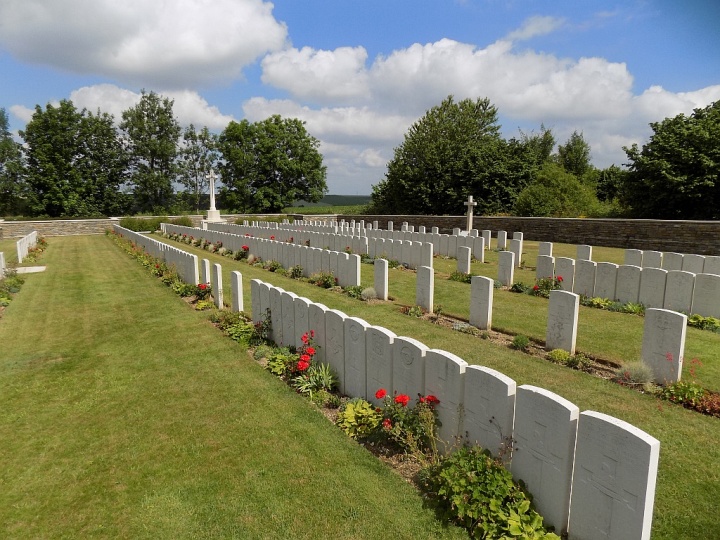
Cojeul British Cemetery was begun by the 21st Division Burial
Officer in April 1917, and used by fighting units until the
following October. It was very severely damaged in later
fighting. The cemetery contains 349 burials and commemorations, 35 of the burials
being unidentified while 31
graves destroyed by shell fire are represented by special memorials.
――――♦――――
ERNEST KING
Private, 4th North Staffordshire Regiment, service no. 42586.
Son of Susannah of 9 Myrtle Cottages, Bulbourne, Tring.
Formerly employed at Apsley Mills.
Died of wounds (sustained in France) at Coombe Lodge Auxiliary Military Hospital,
Essex,
on the 13th February 1919, aged 19.
Buried in Tring Cemetery, grave ref. Row F Grave 64.
Although its roots can be traced back to the 18th century, The North
Staffordshire (infantry) Regiment grew out of the Childers Reforms [Note]
in 1881. The Regiment then served all over the Empire in times
of both peace and war, elements of which took part in many conflicts
such as the Second Sudanese War (1895), the Second Boer War
(1899-1902), the Anglo-Irish War (1919-22) and the Third
Anglo-Afghan War (1919).
At the outbreak of the First World War, the 4th Battalion was
serving as the garrison in Guernsey. In 1916 it returned to
the United Kingdom and in the following year arrived in France
where it served on the Western Front [Note] for the remainder of the war.
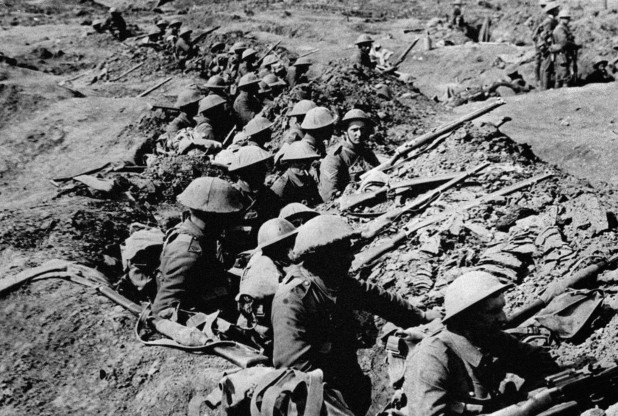
Trench warefare.
On the 3rd of February 1918 the 4th Battalion North Staffs joined
the 105th Brigade in the 35th Division. In 1918
they fought in the First Battle of Bapaume (24th–25th March) and the Final Advance in
Flanders, including The Battle of Courtrai and The action of Tieghem.
They crossed the River Scheldt near Berchem on the 9th of November
and by the Armistice they had entered Grammont. They moved
back to Eperlecques and many of the miners in the Regiment were
demobilised in December. In January 1919, units of the
Division were sent to Calais to quell rioting in the transit camps.
The last of the Division were demobilised in April 1919.
The brief obituary published in the Tring Church Parish Magazine
(below) states that Private King arrived in France on the 31st March 1918.
Thus, with the exception of the First Battle of Bapaume (24th-25th
March), it is
possible that he was involved in one or both the actions in which the
Battalion was engaged in 1918 – The Battle of Courtrai
(14th-19th October); The Action of Tieghem (31st October) – but when he received his wound is
not known.
Private King died at Coombe Lodge Auxiliary Military Hospital, Essex.
The hospital, which operated from the 6th November 1914 to the 19th
March 1919, was located in a large country house donated by Evelyn
Heseltine, a successful stockbroker. Shortly before the outbreak of war his daughter,
Muriel, married Brigadier General Cecil Henry De Rougemont.
Whilst her husband was abroad fighting for king and country, Muriel
worked as Commandant of the VAD [Note] Red Cross unit at Coombe Lodge, and
for her services she was awarded an OBE.
Before the war began, the British Red Cross searched for suitable
properties that could be used as temporary hospitals if war broke
out. This meant that as soon as wounded men began to arrive
from abroad, hospitals were largely available for their use, with
staff and equipment in place. Such ‘auxiliary military
hospitals’ were usually staffed by:
a Commandant, who was in charge of the hospital’s administration,
but not its medical
and nursing services;
a Quartermaster, who was responsible for the receipt, custody and
issue of articles in the
provision store;
a Matron, who directed the nursing staff;
members of the local Voluntary Aid Detachment who were trained in
first aid and home
nursing.
Both the reports below state that Ernest died of pneumonia, which,
at this date, suggests that Spanish Influenza might have been the
primary cause of death. [Note]
This from the Bucks Herald, 1st March 1919:
“ROLL OF HONOUR.
− We regret to hear that the Roll of Honour of Tring men who have
given their lives in the war has passed 100. It is our sad
duty this week to record the deaths of yet two more local men. −
Ernest King, North Staffordshire Regiment, had done 12 months
service, joining up when he was 18 years of age, and was quickly
sent over to France. He was badly wounded, was brought home to
England, and for a period had been in hospital. It was hoped
he would make a full recovery, but pneumonia supervened, and he died
on Feb 13. His remains were brought to Tring and laid to rest
in the new cemetery, military honours being accorded by a party from
Halton Camp. The last service was conducted by the Vicar (Rev.
H. Francis).”
From the Parish Magazine, Holy Week, 1919:
“Ernest King, North Staffordshire Regt,
joined twelve months ago, and crossed for France on Easter Day 1918. [31st
March]
He was soon in action, and later on was badly wounded. He was
brought to England and received every care and attention at Combe
Lodge, Great Warley, Near Brentwood in Essex, and great hopes were
entertained for his recovery, but pneumonia carried him off on 13
February.
His body was brought to Tring and laid to rest in our cemetery with
Military honours on 20 February.”
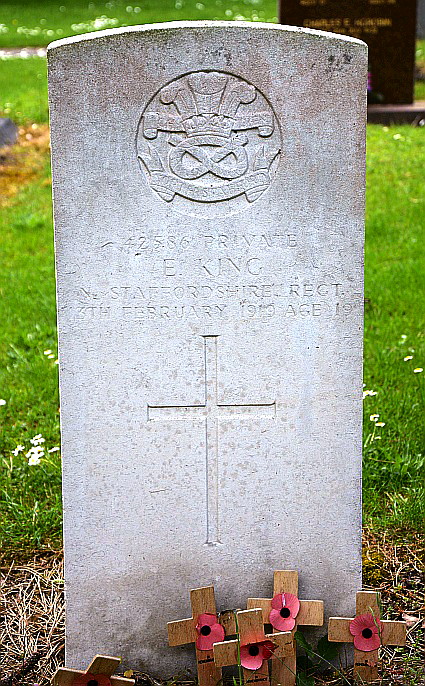
Ernest King’s grave in Tring Cemetery.
――――♦――――
BERTIE LOVEGROVE
Private, “D” Coy, 9th East Surrey Regiment, service number 3012.
Born in Tring. Joseph and Annie Lovegrove, 14 Frogmore Street,
Tring.
Enlisted at Watford. Killed in action on the 25th February
1916.
Buried in Menin Road South Military Cemetery, Ypres, Belgium, grave
ref. I. A. 17.
The East Surrey (infantry) Regiment was formed under the Childers
Reforms, [Note] from the
amalgamation of the 31st (Huntingdonshire) Regiment (which became
its 1st Battalion) and the 70th (Surrey) Regiment (which became its
2nd Battalion). The Regiment contributed greatly to the First
World War, raising 18 battalions. Included in this were seven
service battalions raised as part of Kitchener’s New Army. The
10th and 11th battalions were used for auxiliary purposes and
recruiting, but the 7th, 8th, 9th, 12th and 13th went to France.
Overall, 6000 men were lost and seven Victoria Crosses won.
The 9th (Service) [Note] Battalion
was formed at Kingston-upon-Thames in September 1914 as part of K3.
[Note] Following training, the
Battalion landed at Boulogne on the 1st September 1915 for service
on the Western Front [Note] as part of the 72nd Brigade in the
24th Division. On the 4th September the Division
concentrated in the area between Etaples and St Pol, and a few days
later marched across France into the reserve for the British assault
at Loos, going into action on the 26th of September and suffering
heavy losses.

|
One of the most famous
incidents to occur during the carnage of the first day
of the Battle of the Somme (1st July 1916) was the 8th
Battalion East Surrey Regiment’s famous ‘football’
charge towards the German trenches at Montauban. |
In 1916 the 9th Battalion suffered in the German gas attack
at Wulverghem (30th April and the 17th June) and then moved to The
Somme, seeing action in the battles of Delville Wood (15th July–3rd
September) and of Guillemont (3rd–6th September).
The haunting drama Journey’s End (1928) is a well-known play
about the Great War. Its author, R. C. Sherriff, saw all his
front line service with 9th Battalion. The entire story
plays out in the officers’ dugout over four days from the 18th to
the 21st March 1918, during the run-up to the real-life events of
Operation Michael. [Note]
Bertie Lovegrove was born in the 3rd quarter of 1891. In the
1901 Census he is recorded living at 14 Frogmore Street with his
parents Joseph (a gardener, aged 46) and Annie (aged 50), together
with his Aunt Bessie (aged 39, a straw plait worker) and cousin Lily
(aged 20, a wood box maker). Ten years later the family remain at 14
Frogmore Street, but besides Bertie (aged 20, an ostler, looking
after the horses at the Black Horse, Frogmore Street), the household
has now reduced to Joseph (general labourer), Annie and a boarder
named Betsey Coughfrey (aged 48, charwoman) whose surname suggests
she is related to Annie.
Private Lovegrove was killed in action on the night of the 25th February 1916.
According to its War Diary [Note] entry for that day, the 9th
Battalion was at the village of Zillebeke (scene of the
infamous Battle of Hill 60, 17th April-7th May 1915), about 1½ miles
south-east of Ypres. The single entry states simply: “Furnished
various working parties for work in trenches 2 killed & 10
wounded.” It thus seems likely that Bertie was one of
the two fatalities referred to, possibly falling victim to shellfire
or to a nocturnal raiding party:
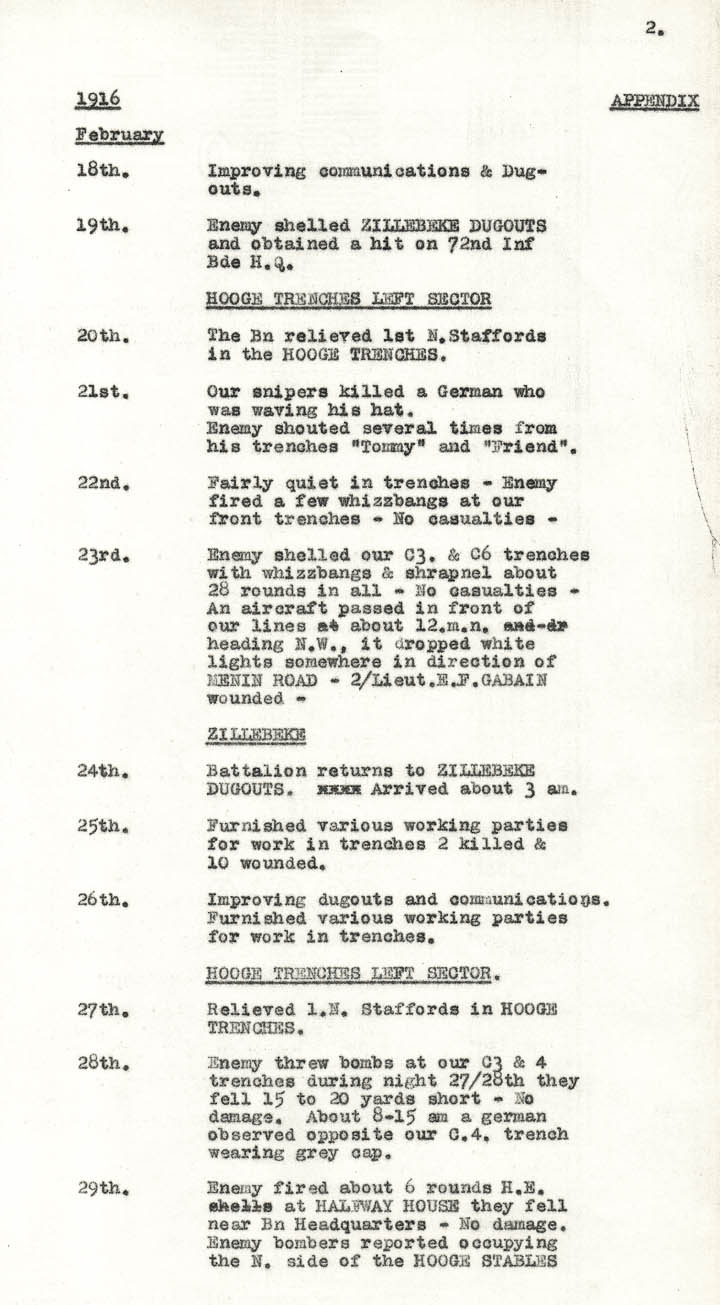
From the Parish Magazine, April 1916:
“Bertie Lovegrove, Private in ‘D’ Company
9th Bn East Surrey Regt was killed in action on 25 February 1916.
The sergeant Major of ‘D’ Company writes, in a letter to his
parents:
‘I have sorrowful news for you; your son who was in my company was
killed in action on the night of February 25th. I must tell
you, he died a hero, for his country. He will be missed by all
of his comrades in the company.
For myself, his loss will be great, for he was a good soldier and a
brave lade. He seemed to have a presentiment that he was going
to die, but for the last three days in action, he was the brightest
of boys, trying to cheer everybody up. We all feel for you in
your distress.’”
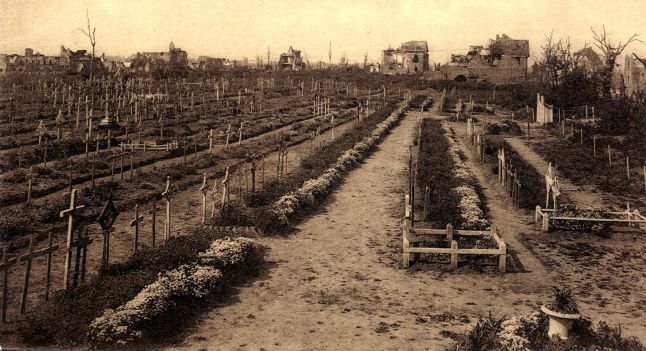
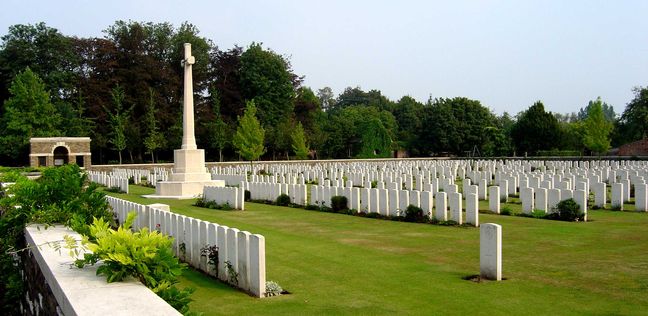
The Menin Road ran east and a little south from Ypres to a front
line which varied only a few kilometres during the greater part of
the war. The position of this cemetery was always within the
Allied lines. It was first used in January 1916 by the 8th
South Staffords and the 9th East Surreys, and it continued to
be used by units and Field Ambulances until the summer of 1918.
The cemetery was increased after the Armistice when graves were
brought in from isolated positions on the battlefields.
There are now 1,657 servicemen buried or commemorated in this
cemetery. 118 of the burials are unidentified but special
memorials are erected to 24 casualties known or believed to be
buried among them. In addition, there are special memorials to
54 casualties who were buried in Menin Road North Military Cemetery,
whose graves were probably destroyed by shell fire and could not be
found.
――――♦――――
ARTHUR LOVELL
Private, 54th (East Anglian) Infantry Division, Machine Gun Company, service no. 50477.
Son of Alfred and Mary of 7 Bunstrux Hill, Tring.
Died of
Malaria [Note] in the Lebanon on the 16th November 1918 aged 26.
Buried in Beirut War Cemetery, Lebanon, grave ref. 123.
The 54th (East Anglian) Division [Note]
was a formation of the Territorial Force, [Note]
formed as a result of the Haldane reforms of 1908. As such it
was one of 14 Divisions of the peacetime TF.
On the 8th July 1915, the Division was ordered to refit for service
at Gallipoli. Leaving the artillery and train behind, the rest
of the Division sailed from Liverpool and Devonport, the first ships
reaching Lemnos on the 6th August. On the 10th August units
landed at Suvla Bay, Gallipoli, as part of IX Corps and took part in
operations in the Sulva area before being evacuated from Gallipoli
in December (only 240 officers and 4480 men strong).
Private Lovell joined the Bedford Regiment in June, 1915, and
was later transferred to the Norfolk Regiment, joining the
54th Division Machine Gun Company. This Company was formed
in April and May 1916 from a merger of the 54th Division’s three
existing Brigade − i.e. the 161st (Essex) Brigade, 162nd
(East Midland) Brigade, and 163rd (Norfolk & Suffolk) Brigade −
machine gun companies.
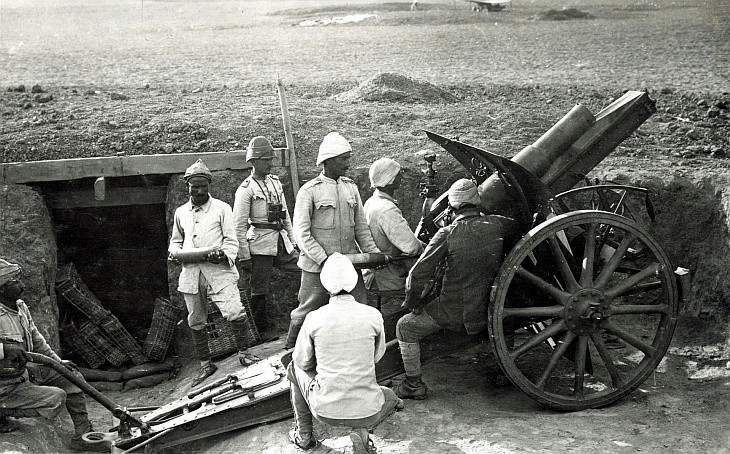
Ottoman artillerymen at Hareira in 1917
before the Southern Palestine offensive.
During 1916, the 54th Division formed part of the Suez Canal
defences, and in the following two years took part in the Gaza and
Southern Palestine offensives. [Note] On the date of the Armistice
with Turkey (31st October 1918) the Division was concentrated at
Beirut, where Private Lovell died from malaria.
From the Parish Magazine December 1918:
“Just as we go to press, we hear that
Arthur Lovell, Machine Gun Corps (Norfolk Regt) has died of malarial
fever at Alexandria [but see below].
He has been in the Army for the last three and a half years, for the
greater part of this time, with the Egyptian Expeditionary Force.
He was a great favourite with all who knew him. His parents,
who have now lost two sons, have our deepest Sympathy. R.I.P.”
From the Parish Magazine, January 1919:
“Of Arthur Lovell, whose death was recorded
in our last number Major Culme Seymore writing to his parents , says
‘Your son was only two days in hospital at Beyrouth,
[French for Beriut] having been admitted
there on 14th November, so his death was sudden.
It may be of some consolation to you to know he was spared a
lingering illness. He has served with me since the Machine Gun
Corps was formed in 1916. You will be pleased to know, that he
was a good soldier and did his work well, both in action and when
out of the front line.
I send you my deepest sympathy. He was buried at Beyrouth on
Sunday 17th November.’
A letter from one of his mates says:
‘Jerry, as we used to call your son, was a good soldier and a great
mate, and I assure you will be greatly missed by us all. He
was always merry and bright, and tried to live a godly life.
This letter conveys to you and yours, the deepest sympathy of myself
and all the boys in A section.’”
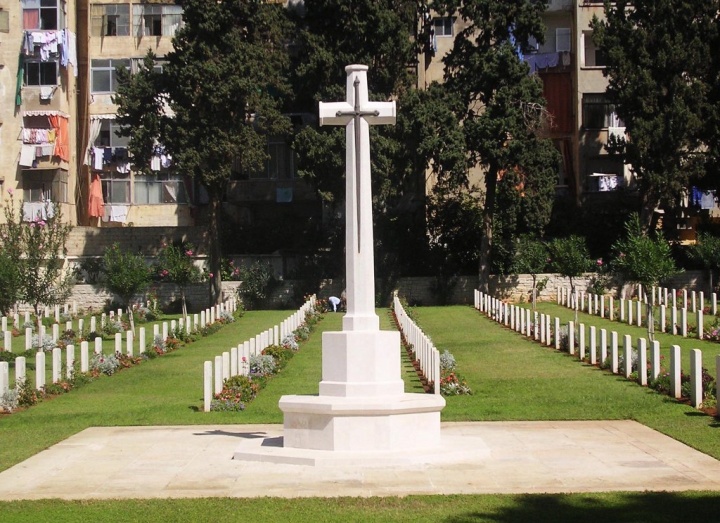
Lebanon was taken from the Turks in 1918 by Commonwealth forces with
small French and Arab detachments. Beirut was occupied on the
8th October 1918, and the 32nd and 15th Combined Clearing Hospitals
were sent to the town.
The Beirut War Cemetery was begun in October 1918 and was later
enlarged when graves were brought in from other burial grounds in
the area. Commonwealth burials and commemorations now total
628 for the First World War and 531 for the Second World War.
The cemetery also contains a number of war graves of other
nationalities, many of them Greek and Turkish.
――――♦――――
FREDERICK LOVELL
Private, 13th Essex Regiment, enlisted at East Ham, Essex, service
no. 17199.
Born in Tring. Son of Mr. and Mrs A. Lovell of Akeman Street, Tring.
Husband of Mrs. E. E. Stocker (formerly Lovell) of 1 Pinewood
Cottages, Pinewood Road, Ash, Surrey.
Killed in action the 2nd August 1916 aged 28.
Buried in Dantzig Alley British Cemetery, Mametz, France, grave ref.
VIII. C. 8.
There is some confusion over both Frederick’s rank and his unit,
with different burial documents stating Lance Corporal and Private,
and the 13th Essex and the 15th Essex respectively. Rank is unimportant in
this context, but unit is, so I have selected the Commonwealth War
Grave Commission information, which places him in the 13th Battalion
(West Ham) Essex Regiment, ‘The West Ham Pals’.
The Essex Regiment was a line infantry regiment formed in 1881 under
the Childers Reforms [Note] by the
amalgamation of the 44th (East Essex) Regiment of Foot and the 56th
(West Essex) Regiment of Foot, which then became the 1st and 2nd
battalions of the new regiment. During the First World War,
the Essex Regiment provided 30 infantry battalions to the British
Army. In 1914, three service [Note]
battalions (9th, 10th and 11th) and one reserve battalion (12th)
were formed from volunteers as part of Kitchener’s Army. [Note]
A further service battalion, the 13th West Ham, was raised by the
Mayor and Borough of West Ham. Initially recruits came from
West/East Ham, Forest Gate, Custom House, Barking and Stratford but
others from abroad joined the regiment. Overall, some 9000
officers and men of the Essex Regiment died in the 1914-18 War, many
having no known grave.
In November 1915, the 1200 strong West Ham Battalion landed in
Boulogne after which they saw action in most of the major battles on
the Western Front. [Note] Initially
under orders from the 100th Brigade in the 33rd Division, on the
22nd December 1915 the 13th Battalion was transferred to the 6th
Brigade in the 2nd Division, as part of which they were involved in
major actions including, in:
1916, The Battle of Delville Wood, The Battle of the Ancre and
Operations on the Ancre;
1917, The German retreat to the Hindenburg Line, The First Battle of
the Scarpe, The Battle of Arleux, The Second Battle of the Scarpe,
The Battle of Cambrai.
Frederick Lovell was killed in action on the 2nd August, 1916 where,
between the 29th July and the 4th August, his unit was in the front
line in Delville Wood.
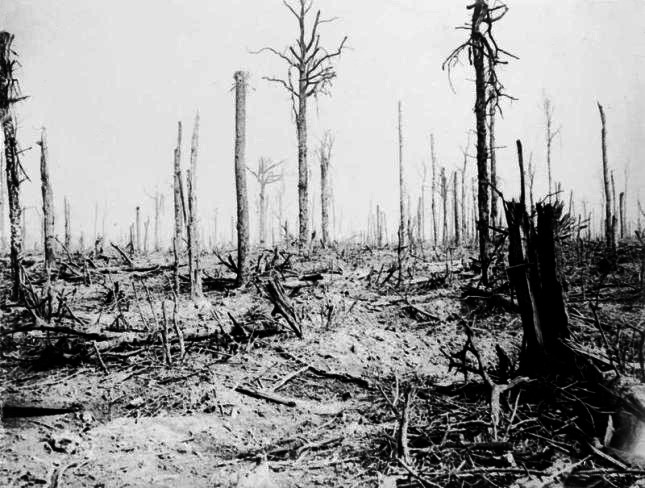
Delville Wood, 20th September 1916.
Following the successful dawn attack of the 14th July, the newly won
British line formed a salient, the right side of which was
threatened by German positions in Delville Wood. The wood
needed to be taken, a task fell to the South African Brigade.
During the attack the South Africans came under withering German
artillery fire that almost completely destroyed both the wood and
their battalions. The Brigade had gone into battle with a
strength of 121 officers and 3,032 other ranks − at roll call on
21st July they numbered a mere 29 officers and 751 other ranks.
Mud and rainwater covered the bodies of South Africans and Germans
alike, many of whom remain in the wood today.
Vicious fighting for Delville Wood continued for another six weeks,
the advantage continuously changing from one side to the other.
On the 27th July the 2nd Division renewed the assault, followed on
the 4th August by the 17th Division, but the wood was only
completely cleared of Germans following the fall of Ginchy (Northern
France) on the 9th September.
From the Bucks Herald 19th August 1916:
“Lance-Corporal F. Lovell, 15th Essex
Regiment, was the son of Mr. and Mrs. Lovell, Akeman-street, and had
been in France for ten months; he was a first class bomb thrower.
His friends have as yet to received official intimation of his
death, but the news came through in a letter from a comrade, who
also forwarded seven letters which Lance-Corporal Lovell had
written, but had not posted. Up to the time he enlisted he was
employed by Messrs. Rothschild’s refinery in the City, and his
parents have received a letter of sympathy and condolence from the
firm of N. M. Rothschild. Sydney Lovell, who was in the Bucks
Territorials, was wounded on July 21, and is now in Tring. He
arrived home the same day that his parents received the news that
Frederick had been killed in action. A third son [Arthur]
is serving with the Army in Egypt.”
From the Parish Magazine September 1916:
“Frederick Lovell was a Lance Corporal in
the 15th Essex Regiment and had been in France this last ten months.
He had gained distinction as a first class bomb thrower. No
particulars of his death have been received, except that it occurred
on the 1st of August and was instantaneous. He had evidently
proved himself a very gallant soldier and has left amongst those who
knew him best, very pleasant memories. May he have the reward
of faithful service. Rest in Peace.”
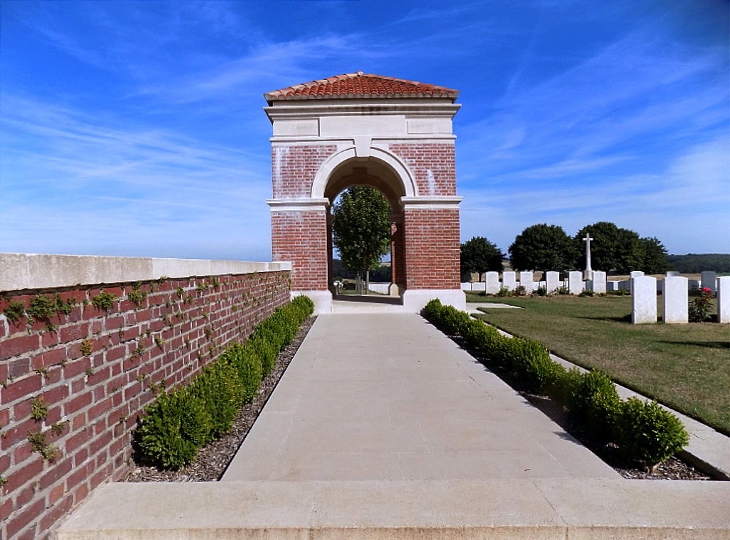
The village of Mametz was carried by the 7th Division on the
1st July 1916, the first day of the Battle of the Somme, after very
hard fighting at Dantzig Alley (a German trench) and other points.
The Dantzig Alley British Cemetery was begun later in the same month and was used by field
ambulances and fighting units until the following November.
The ground was lost during the great German advance in March 1918
but regained in August, and a few graves were added to the cemetery
in August and September 1918. At the Armistice, the cemetery
consisted of 183 graves, now in Plot I, but it was then very greatly
increased by graves (almost all of 1916) brought in from the
battlefields north and east of Mametz and from certain smaller
burial grounds.
Dantzig Alley British Cemetery now contains 2,053 burials and
commemorations of the First World War. 518 of the burials are
unidentified but there are special memorials to 17 casualties known
or believed to be buried among them. Other special memorials
record the names of 71 casualties buried in other cemeteries, whose
graves were destroyed by shell fire.
――――♦――――
FRANK EDGAR
MARCHAM
Enlisted at Hertford. Private, 1st Hertfordshire Regiment,
service no. 2780.
Born in Tring. Son of Mr. and Mrs. F. W. Marcham of ‘Oakleigh,’
Western Road.
Killed by a shell whilst resting in billet in France on the 29th
March 1915 aged 22.
Buried in the Guards Cemetery, Windy Corner, France, grave ref I. E. 16.
The 1st Battalion Hertfordshire Regiment served on the Western Front
[Note] from November 1914 until the
Armistice, in which time they engaged in all the major actions
including the three battles of Ypres, Loos, The Somme, Passchendaele
and the German Spring Offensive [Note]
of March 1918.
The Battalion was the only infantry unit from the county to see
overseas service. It landed at Le Havre in the early hours of the
6th November 1914 and first entered the trenches in the Ypres
Salient.
Typically each company and section of the Regiment were recruited
from the same area of the county, making it possible to identify
which company a serviceman was with based upon their original
enlistment location. As of January 1915, the composition of
the 1st Battalion was:
No 1 Company – Hertford, Hatfield, Waltham Cross, Cheshunt, Wormley
& Hoddesdon.
No 2 Company – St Albans, Hemel Hempstead, Berkhamsted, Tring
& Ashridge.
No 3 Company – Bishop’s Stortford, Ware, Widford, the Hadhams,
Braughing & Watford.
No 4 Company – Royston, Hitchin, Letchworth, Baldock, Stevenage &
Whitwell.
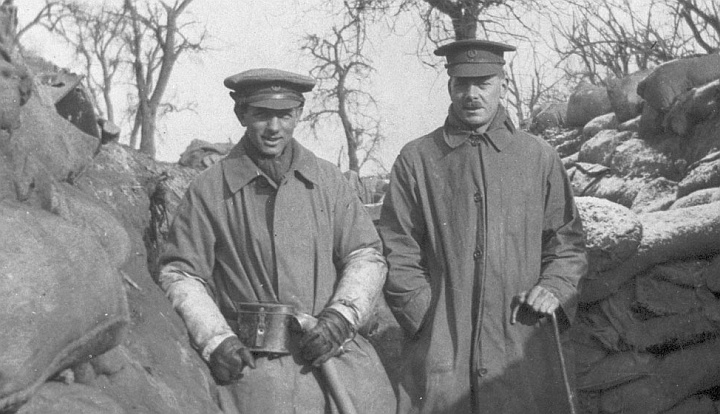
Hertfordshire Regiment soldiers in a
trench on the Western Front.
From the Hertfordshire Regiment War Diary [Note] for March 1915:
“1-3-15. Battalion in Corps Reserve at School in BETHUNE.
2-3-15. Two Companies vacated billets and marched to VENDIN.
5-3-15. Remaining two companies joined up with the battalion
at VENDIN.
6 to 9-3-15. Bn in Corps Reserve at VENDIN.
10-3-15. Battalion moved to St. PREOL in support on CANAL
BANK and in the evening returned to billets at BETHUNE.
11-3-15. At 5am we again moved up to the same position at St.
PREOL, remained in support all day and in the evening relieved the
1st Bn Kings Royal Rifles at GIVENCHY, two companies going into the
trenches, 2 in billets in reserve.
12-3-15. Two Companies in trenches, 2 in support. Casualties
- 6 wounded of which 3 only slight. In the evening engaged in
digging.
13-3-15. Ditto. Digging in the evening.
Casualties 4 wounded (C.S.M. Raven left trenches and went out and
brought in Cpl Beaver of the 1st Bn Kings Royal Rifles who had been
wounded 2 days previously).
14-3-15. The Brigadier congratulated the Bn on the excellent
work and intelligent reports of the patrols that went out on the
previous evening and especially congratulated C.S.M. Raven on his
gallant conduct in saving the life of Cpl Beaver of the 1st Bn Kings
Royal Rifle Corps. Casualties 2 wounded.
16-3-15. One Coy digging in the evening. 2 killed, 2 wounded.
17-3-15. The GOC 2nd Division congratulated the Bn on the
fine progress made on the new trench. In the evening 4
platoons of the 7th Bn Kings Liverpool Regiment (TF) (one platoon of
which lost its way and did not arrive) were engaged in digging
trench. Our casualties, 5 wounded, 1 dying of wounds in
hospital at BETHUNE
18-3-15. Heavy artillery fire.
19 to 31-3-15. Nothing of importance happened.
27-3-15. Notification received to the effect that CSM Raven
had been awarded the Distinguished Conduct Medal.
31-3-15. One Coy of the 8th City of London (Post Office
Rifles) took over NEW CUT TRENCH, GIVENCHY. No.2 Coy marched
into billets at School in BETHUNE.”
[On 29-3-15 Acting L/Cpl 4523 William George GREE died of
wounds, Privates 2076 Francis John Barr LAUGHTON and 2780 Frank
Edgar MARCHAM were both killed in action.]
The following extract is from a letter written by Private J.
Harrowell, the son of Mr. and Mrs. W. Harrowell, of Clarence Road
Berkhamstead:
“I daresay you
have heard by now that two of our lads, and one from Tring, were
killed by a shell, also three wounded (two of the wounded were Lees
and Ballam, of Berkhamsted). The shell dropped plumb in our
billet, behind the firing line as we were just thinking about
getting ready to go up to the ditches. I was just outside, and
did not get touched, except by a few lumps of dirt, etc. I
heard it coming, just in time to get behind a wagon, and it dropped
on the hard paving stones in the doorway, otherwise it would not
have done so much damage. It blew part of the 18 inch wall
away, and the damage naturally dismayed us that day, but it has made
us set our teeth, and we were glad to get up to the trenches at
night. We buried our three comrades in a little soldier’s
cemetery, close by where they were killed. We are back out of
range for a few days rest
(censored)
up here, but I daresay we gave them as good as they sent. Jim
(Harrowell).”
From the Bucks Herald 10th April 1915:
The stern realities of war have been
brought home with startling force this week. At the end of
last week news reached Tring of some severe casualties amongst the
Herts Territorials, in which several Tring men were involved.
Frank Marcham, son of Mr. Fred Marcham of Western-road, was reported
killed, and Fred Rodwell, son of Mr. W. J. Rodwell of the Tring
Brewery, badly wounded. Later particulars are that Marcham,
Rodwell, Bruce, and Barber, all of Tring, were with others in a
stable. Some of the men were chopping up wood to take back to
the trenches when a shell, probably intended for the Battalion
Headquarters, fell just inside the doorway and exploded on striking
the ground. Marcham and three others were killed instantly,
and fragments of the shell struck Rodwell, with the result that he
has lost one eye and sustained other injuries. Barber is
thought to have escaped injury as he was able to help Rodwell to the
hospital, but there is some uncertainty as to what happened to
Bruce. Private Rodwell was later sent home and is now in the
military hospital, St. Gabriel’s College, Camberwell. The
doctors, happily, feel no anxiety at all about his ultimate
recovery.
Private Marcham was buried in the well-kept little cemetery near the
base, the funeral being conducted by one of the Chaplains. Every
care is bestowed on the last resting-place of the dead heroes. Each
man’s name is painted on a cross above his head and flowers are
placed on the graves. Archibald Bishop, son of Mr. Harry Bishop, is
also reported wounded.
From the Parish Magazine, May 1915:
“Frank Marcham, 1st Battalion,
Hertfordshire Regiment who was hit by a shell on the 29th March 1915
and died at once. Very soon after the outbreak of war Marcham
obeyed the call of King and Country and in due course was sent to
the front. His Commanding Officer, Captain. A.F. Smeathman,
conveying to his parents and friends the deep sympathy of the
officers and men of his company. They speak of him as being at
all times cheerful, and said that ‘his death is much felt by
everyone that knew him’.
He was buried by a clergyman in a grave that was properly marked and
can easily be recognised when the war is over.”
Frank Marcham was the only son of Mr. and Mrs. Frederick Marcham, of
Western Road, Tring. Before joining up, Frank was employed by Messrs Wright and Wright,
a coach-building firm also of Western Road. According to the
1911 Census, Frank’s occupation was that of ‘coach painter’ and he
was living with his parents and three younger sisters at the family
home in Western Road.
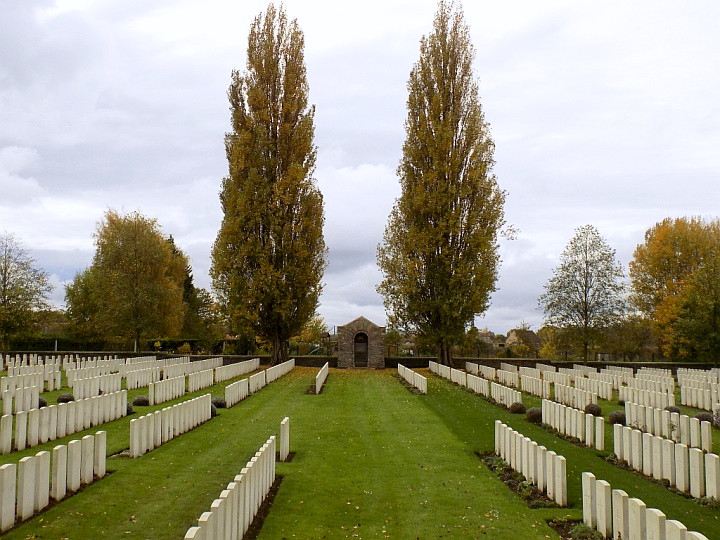
A little west of the crossroads known to the army as ‘Windy
Corner’ was a house used as a battalion headquarters and dressing
station, which the cemetery grew up beside.
The original Guards Cemetery was begun by the 2nd Division in
January 1915, and used extensively by the 4th (Guards) Brigade in
and after February. It was closed at the end of May 1916 when
it contained 681 graves. After the Armistice the cemetery was
increased when more than 2,700 graves were brought in from the
neighbouring battlefields − in particular the battlefields of
Neuve-Chapelle, the Aubers Ridge and Festubert − and from certain
smaller cemeteries.
The Guards Cemetery now contains 3,445 burials and commemorations of
the First World War. 2,198 of the burials are unidentified but
there are special memorials to 36 casualties known or believed to be
buried among them. Other special memorials commemorate six
casualties buried in Indian Village North Cemetery, whose graves
were destroyed by shell fire, and five Indian soldiers originally
buried in the Guards Cemetery but afterwards cremated in accordance
with the requirements of their faith.
――――♦――――
CHARLES MILLER
Private Charles Miller, 2nd (?) Oxfordshire and Buckinghamshire Light Infantry, service no.
8430.
Born in Berkhamsted, second eldest son of John Thomas and
Sophia Elizabeth
of
5 New Cottages, Brook Street, Tring.
Died in Tring of rheumatic fever (possibly contracted at Ypres) on 17th August 1916 aged 25 years
having being invalided out of
the army on 5th October 1915.
Buried in New Mill Baptist Cemetery, Tring, grave ref. No. 5, Tier
J, South Plot (unmarked grave)
and commemorated on the Tring War Memorial.
Charles Miller signed up as a reservist with the Ox & Bucks
Light Infantry at Aylesbury on the 25th March 1913. According
to his enlistment papers he was then aged
17 years and 11 months, but as he was baptised on the 4th May 1892,
his admitted age is incorrect and should have been at least 20 years.
The fact is that Charles didn’t know his date of birth, for army
pension records show his year of birth as being “abt. 1896”.
Private Miller’s army records show that he
arrived in France with the British Expeditionary Force (BEF) [Note]
on the 12th September 1914. On the 5th October 1915 he was
discharged from Cambridge Barracks, Portsmouth, as being medically
unfit for service. His discharge papers state that he was at
that time attached to the 3rd Battalion (Special Reserve) [Note]
of the Ox & Bucks L.I. However, this battalion was assigned to
home defence and training duties for the duration of the war, and as
the 1st Battalion served throughout the war in the Middle East, it
seems likely that Private Miller served with the Regiment’s 2nd
Battalion in France, which is where he contracted a severe form of rheumatic fever
(i.e. seriously affecting his heart) [Note] through “exposure in the trenches” (see medical discharge
form below).
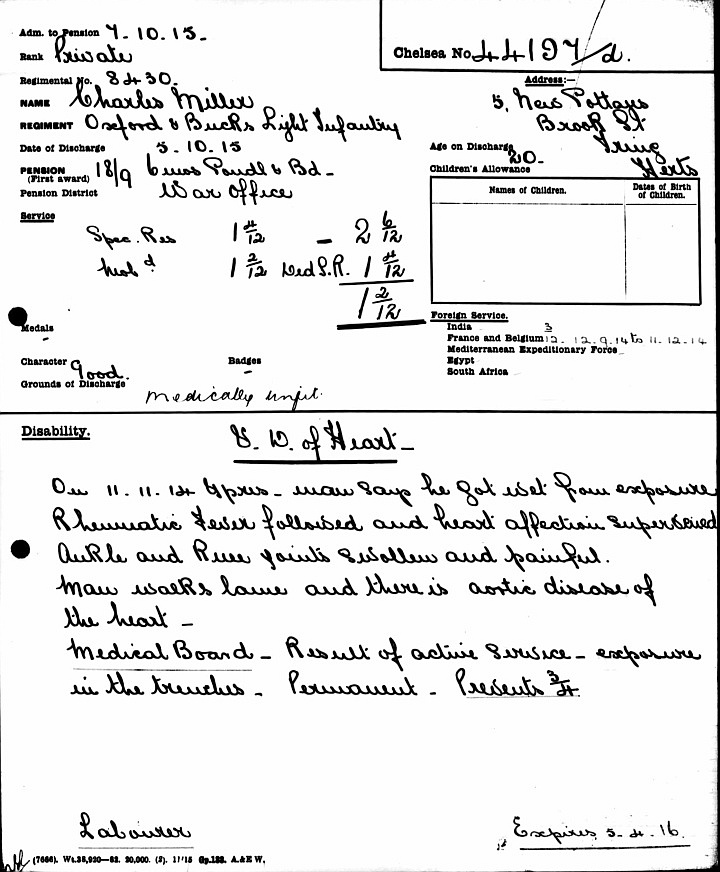
Discharged on medical grounds due to
rheumatic fever, 5th October 1915.
Rheumatic fever is an inflammatory
disease that can effect the heart, joints, skin, and brain.
|
“On 11.11.14 Ypres − man says
he got wet from exposure. Rheumatic Fever followed
and heart affection supervened. Ankle and knee
joints swollen and painful. Man walks lame and
there is aortic disease of the heart.” |
In August 1914, the 2nd Ox and Bucks arrived on the Western Front [Note]
as part of the 5th Infantry Brigade, 2nd Division, I Corps, [Note]
the 2nd Division being one of the first divisions of the B.E.F. [Note]
to arrive in France.
The battalion took part in the first British battle of the war, at
Mons. On the 23rd August 1914 the British stopped the
advancing German forces. However, a combination of German
numerical advantage and the French fifth Army’s retreat led
subsequently to the battalion taking part in the 220 mile retreat
(in exceptionally hot weather) that began on the following day.
The Allies did not stop until reaching the eastern outskirts of
Paris where they halted the German advance at the First Battle of
the Marne (5th–9th September).
The 2nd Ox and Bucks later took part in The 1st Battle of the Aisne
and in the subsidiary battles
of The 1st Battle of Ypres (19th October – 22nd November), which
saw the old Regular Army sustain some 54,000 casualties. At
Ypres, their first engagement
with the enemy was on the 20th October in an attack on the Passchendaele ridge (a
location that gained greater notoriety in 1917) in which the
battalion suffered heavy casualties, with 4 officers killed, 5
wounded and 143 other ranks killed or wounded.
On the 31st October the Germans launched a large scale attack
against I Corps in the area of Ypres, which commenced with a
heavy bombardment followed by a mass infantry attack − 2 companies
of the 2nd Ox and Bucks took part in the defence and subsequent
counter-attack, which forced the enemy back to their front line.
On the 11th November the Germans made a further attempt to capture
Ypres using the élite Prussian Guard. The 2nd Battalion
counter-attacked at Nonne Bosschen wood (11th November 1914)
preventing their advance and routing them.
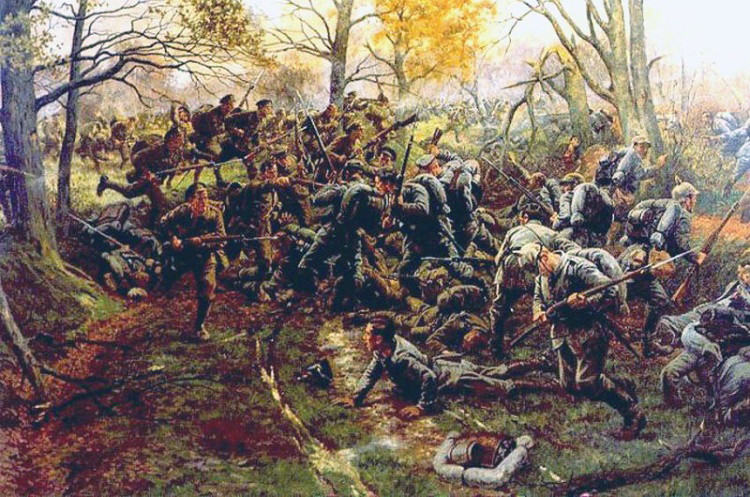
The 2nd Ox and Bucks defeating the
Prussian Guard at Nonne Bosschen.
Painting by William Barnes Wollen (1857–1936).
Judging from the 2nd Battalion’s engagements in 1914 and from his
service record (with the BEF between
12.9.14 and 11.12.14), it seems
likely that Private Miller contracted rheumatic fever during the
later period of The 1st Battle of Ypres (19th October–30th November
1914). From the 12th
November, the weather became much colder with rain, snow and night
frosts. Cases of frostbite appeared and the physical strain
increased among troops having to occupy trenches half-full of
freezing water. “On 11.11.14 Ypres −
man says he got wet from exposure. Rheumatic fever followed .
. . . ” Miller’s medical discharge papers give his
military character as
“Good - a sober well behaved man of nice
appearance”. His disability was assessed as ‘¾’
and ‘permanent’.
From the Parish Magazine (repeated in the Bucks Herald),
September 1916:
“PRIVATE CHARLES MILLER. − On August 17th
there passed away, at his home in Tring, one who, although invalided
out of the Army twelve months ago, and whose name therefore cannot
technically be placed on our Roll of Honour, really gave his life
for his country.
Charles Miller, of the Oxford Light
Infantry, was wounded early in the war, and, through constant
exposure, contracted rheumatic fever, which was the ultimate cause
of his death. He did his bit cheerfully and bravely. May he rest in
peace.”
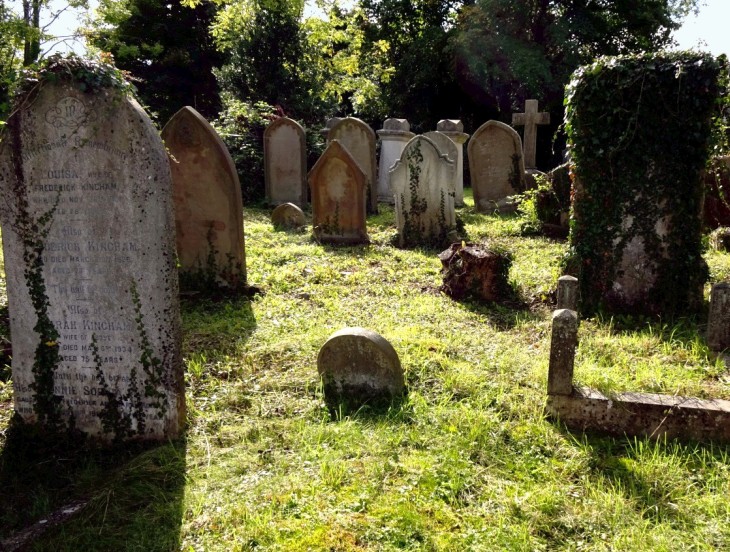
New Mill Baptist Chapel Cemetery, Tring.
Charles Miller was the second eldest of John and Sophia’s four sons,
his brothers being William, George and Stanley; he also had three
younger sisters, Elizabeth, Beatrice and Nelly. In the 1911 Census
his occupation − and that of his father − is given as ‘labourer’
(his recruitment papers state ‘agricultural labourer’) and the
family’s address was then 21 Wingrave Road, Tring. At the time
of his death Charles was resident in Brook Street, nearer the centre
of Tring. His death certificate states that his occupation was
then ‘house decorator/journeyman’
and
that his mother was with him when he died.
Although his name appears on the Tring War Memorial and the Church
Roll of Honour, Charles did not receive a military burial; indeed,
where he was buried remained a mystery until the Minister of New
Mill Baptist Chapel discovered that Charles had been laid to rest in
an unmarked grave in what is now an overgrown area of the Chapel’s
beautiful cemetery. It seems that Charles was medically
certified as having died from tuberculosis, which was not the same
condition (rheumatic fever) for which he was discharged from the
Army. Thus, officialdom would not have considered his
death attributable to ‘war
experience’ – hence no military headstone – but in selecting
names to appear on their War Memorial the citizens of Tring
believed otherwise.
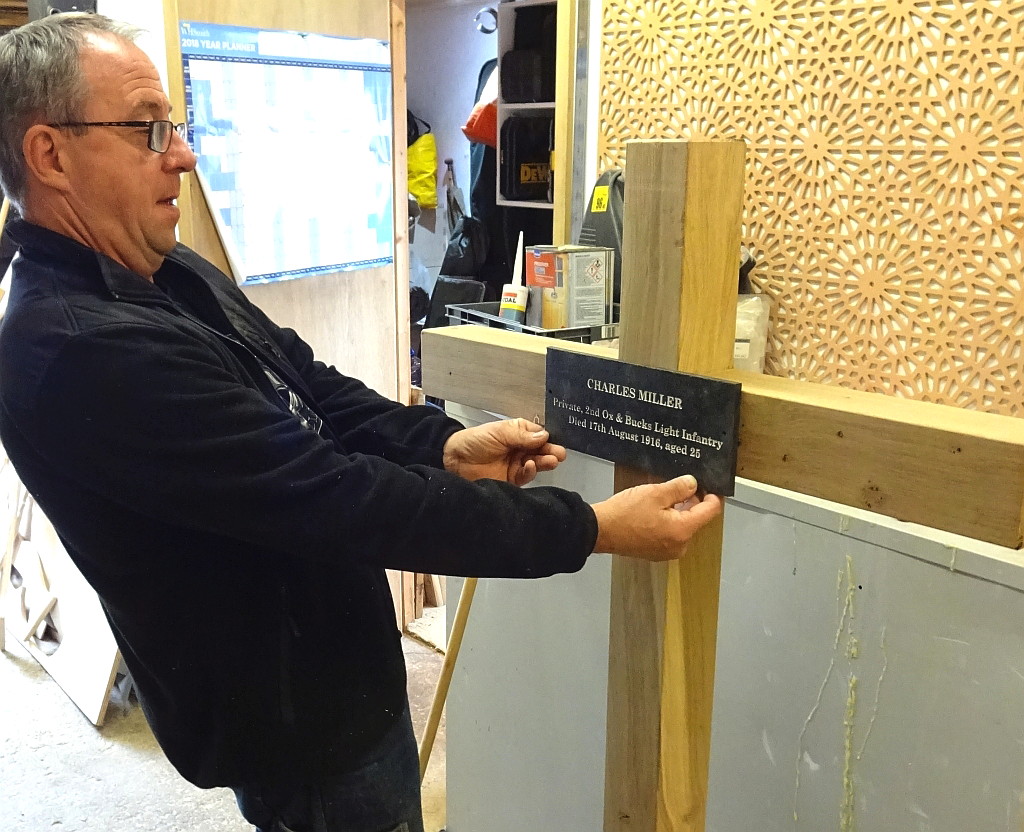
Artist/Craftsman
Alan Ball was commissioned to make a cross to mark Private Miller’s
grave. The cross is of local seasoned oak, the plaque of black
Cornish slate.
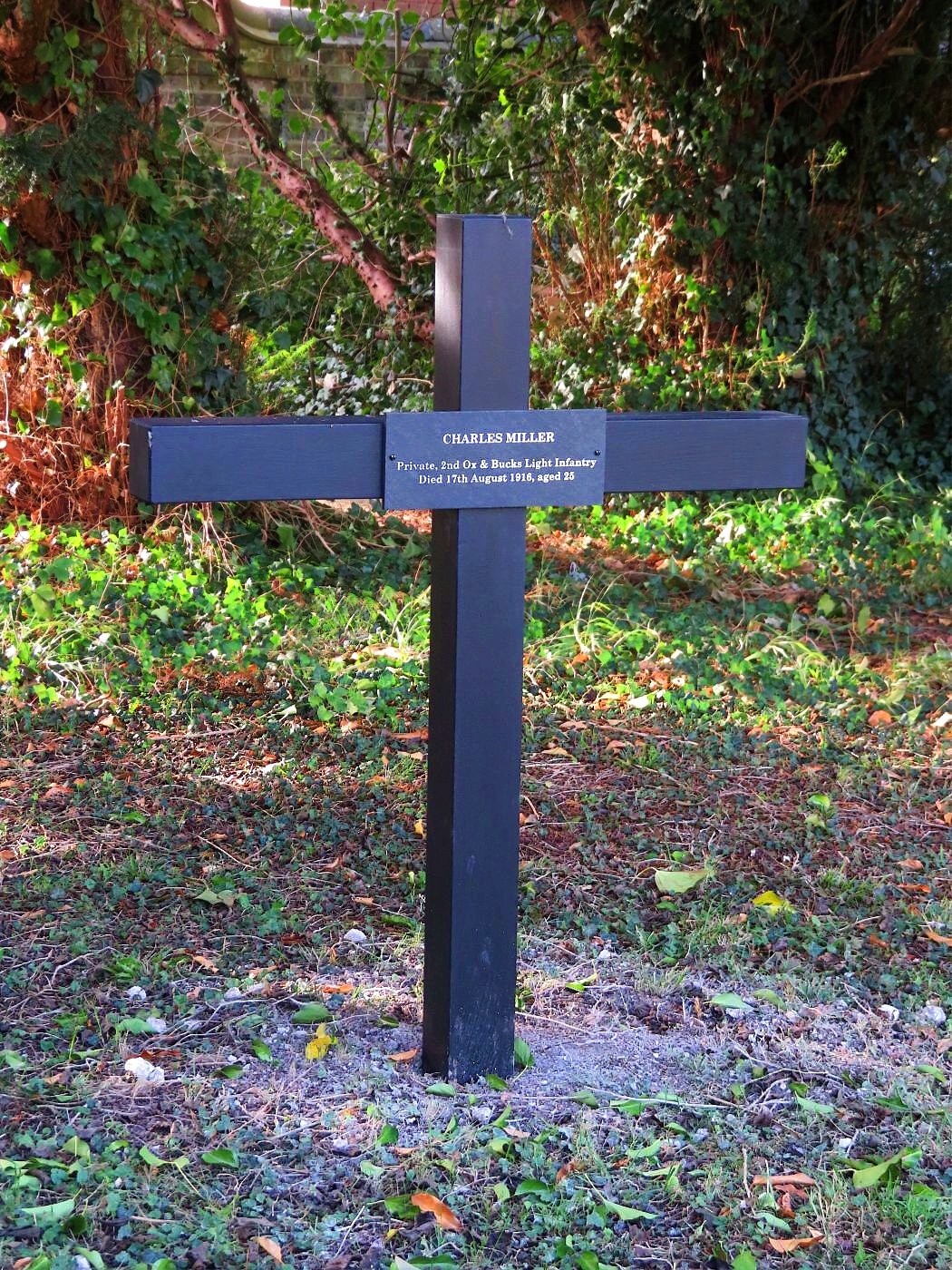
――――♦――――
STANLEY MILLER
Enlisted at Aylesbury. Corporal, 1st/1st Royal Buckinghamshire
Hussars, service no. 205215
Born in Tring. Son of Hannah of 41 Charles Street Tring and
the late Charles Miller.
Died of wounds in Palestine on the 2nd June 1917 aged 29.
Buried in Kantara War Memorial Cemetery, Egypt, grave ref 353.
Historically, a hussar was a soldier in a ‘light cavalry’
regiment, one whose main role was to perform reconnaissance,
scouting and screening, whereas the role of ‘medium cavalry’ was
attack and the defence of specific locations, while ‘heavy cavalry’
undertook shock action on the battlefield. However, in the
British army colonial warfare gradually led to a blurring of these
distinctions.
The early weeks of World War I saw light cavalry attempting to
continue its long established function of being the “eyes and ears”
of the army, but despite some early success the advent of trench
warfare and aerial reconnaissance quickly rendered the role
obsolete, except to an extent in the Middle East. [Note]
After horse cavalry became obsolete, hussar units generally
converted to armoured units while retaining their traditional titles
and, on ceremonial occasions, their dated but picturesque uniforms.
The roots of the Royal Bucks Hussars go back to the French
Revolutionary Wars, its title then being the ‘Mid Bucks Regiment of
Yeomanry’, the Regiment later receiving its ‘Royal’ title from Queen
Victoria. In 1889 the Regiment became the ‘Royal Bucks
Hussars’, some of its men serving in the South African War as part
of the Imperial Yeomanry. The Yeomanry became the mounted arm
of the Territorial Force [Note]
in 1908, and during the First World War the the 1st Royal Bucks
Hussars served at Gallipoli and in Palestine. [Note]
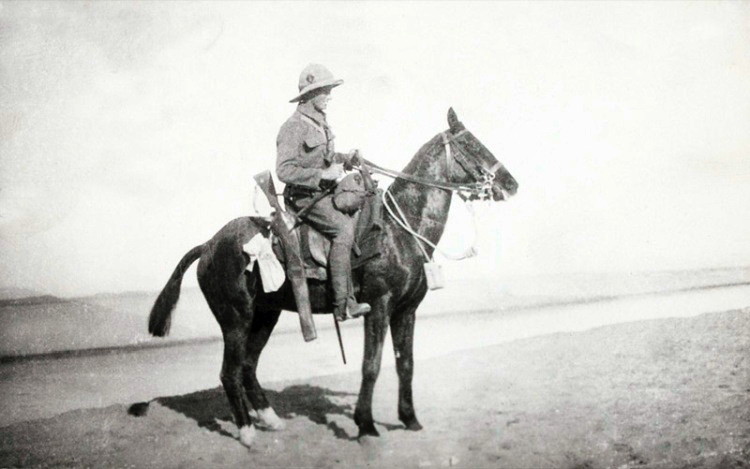
A Royal Bucks Hussars in the Middle
East, 1915.
From the Bucks Herald 16th June 1917:
“ROLL OF HONOUR.
− Another name has to be added to the roll of honour of this town,
news having been received from the War Office of the death from
wounds of Stanley Miller, son of Mr. and Mrs. Charles Miller of
Charles-street. The sad intimation was conveyed in a telegram
received on Friday last, which simply stated that Sergt. Stanley
Miller was wounded in action, and admitted to No. 3 Australian
Stationary Hospital at El Arish, where he died on the following day.
One of the first to answer the call in his
country, Stanley Miller joined the Royal Bucks Hussars, and with the
first Regiment went abroad early in the spring of 1915, going
through all the terrible Dardanelles campaign and eventually
returning with his regiment to Egypt. Here he saw much active
service, which culminated in his death practically in action some
ten days ago. The deepest sympathy is felt with his father and
mother and his relatives in their sad bereavement, and his loss will
be mourned by the many friends he left in Tring.
Before joining the Colours, Miller was in the employ of the Hon.
Walter Rothschild, the present Lord Rothschild, and was held in the
highest respect as a steady and conscientious worker in the stables.
He was 29 years of age and single.”
From the Parish Magazine July 1917:
“Stanley Miller was severely wounded in
action with the Palestine Expeditionary Force, on May 31st, and died
on the following day in the 3rd Australian Stationary Hospital.
He enlisted in the Royal Bucks Hussars on August 10th 1914, and went
to Egypt in February 1915. He became a Sergeant and went all
through the Gallipoli campaign. Except for a bout of ague,
never had a day’s sickness. He has not been back in England
since he left in 1915. No further particulars have been as yet
received, but that he has died and been buried in the Holy Land.
He left behind him a memory of splendid service to his country’s
cause. As a boy, he sang in our Parish Church Choir and was
confirmed here.
Since writing the above, a letter has been received from Sergeant
Miller’s Lieutenant, from which we take the following extract: ‘Your
son was liked and respected by all ranks, and his death was a great
blow to us all, for he was a good soldier and a gentleman.
Your son was wounded on May 31st in the leg by a piece of bomb
dropped by an enemy aeroplane. The bombs were dropped on the
camp, so luckily the wounded had every attention almost immediately.
His leg had an ugly wound, but he never complained as he was carried
to the hospital. On arrival at the hospital it was found
necessary to amputate the leg. He never recovered from the
operation. Your son was buried by the Chaplain at El Arish
[North Sinai], a camp near the
hospital.’”
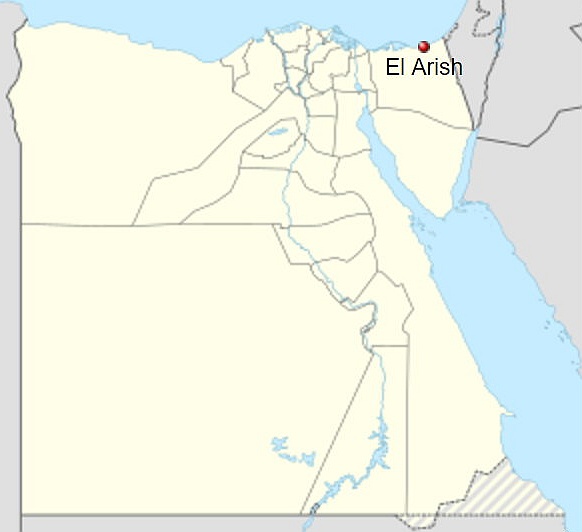
According to the 1891 Census, Stanley Miller, then aged 4, had
two brothers − Herbert (18, a maltster) and
William (7) − and two
sisters, Alice (12) and Gertrude (1). The children lived with their
parents Charles (53, groom and domestic servant) and Hannah (42) at
5 Charles Street, Tring. Twenty years later the Census records
the family still resident in Charles Street, but only William (a
carriage and motor builder) and Gertrude (a school teacher) were at
home on Census night.
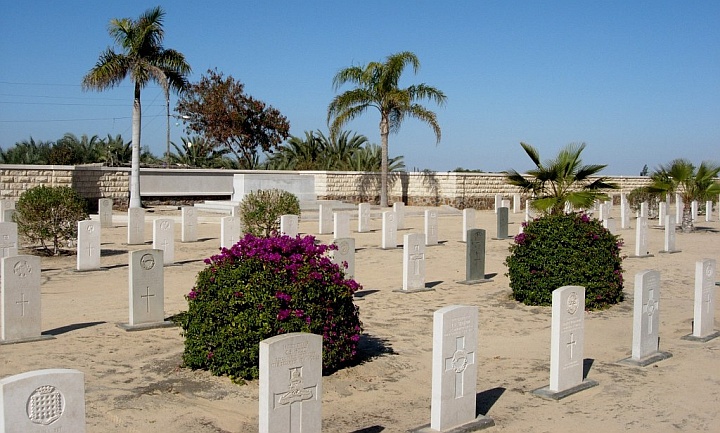
Kantara War Memorial Cemetery.
In the early part of the First World War, Kantara was an
important point in the defence of Suez against Turkish attacks and
marked the starting point of the new railway east towards Sinai and
Palestine, begun in January 1916. Kantara developed into a major
base and hospital centre and the cemetery was begun in February 1916
for burials from the various hospitals, continuing in use until late
1920. After the Armistice, the cemetery was more than doubled in
size when graves were brought in from other cemeteries and desert
battlefields.
Kantara War Memorial Cemetery now contains 1,562 Commonwealth
burials of the First World War. Near the entrance to the cemetery is
the Kantara Memorial bearing the names of 16 New Zealand servicemen
of the First World War who died in actions at Rumani and Rafa, and
who have no known grave.
――――♦――――
WILLIAM JOHN MILLER
Private, 118th Company,
Royal Army Ordnance Corps, service no. 023941.
Son of Hannah and the late Charles Miller, of 41 Charles Street,
Tring.
Husband of Violet M. Miller of 41 Charles St., Tring.
Died of pneumonia following influenza on the 3rd March 1919 aged 33.
Buried in the Abbeville Communal Extension Cemetery, France, grave ref. V.
G. 14.
Private Miller served in the Royal Army Ordnance Corps (RAOC), a corps of the British Army
that dealt with the supply and maintenance of weaponry, munitions
and other military equipment.
The RAOC was formed in 1918 from a
merger of the Army Ordnance Department and the Army Ordnance Corps,
which between them traced their roots back through a long and
complex history to the 15th century and the Board of Ordnance.
Ordnance units served in all the British Army’s campaigns and
created a well-developed system of stores dumps and repair
facilities, often along extended lines-of-communication. They
were organised in two broad divisions: a static organisation of
depots and other installations, and field units that provided close
support to military operations.

An Army Service Corps supply convoy,
Western Front, c1916 (the prefix ‘Royal’ was acquired in 1918).
A reorganisation of Army Logistics in 1964 resulted in the RAOC
absorbing petroleum, rations and accommodation stores functions from
the Royal Army Service Corps as well as the Army Fire Service,
barrack services, sponsorship of the NAAFI and the management of
staff clerks from the same Corps. In 1993, the RAOC was one of
the corps that amalgamated to form The Royal Logistic Corps − the
largest Corps in the British Army − which maintains the Army’s operational
capability in peace and in war by providing whatever is required, in the required quantity
and at the required place and time.
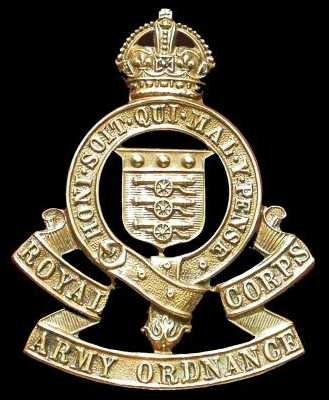
Private Miller did not die in combat, but as a result of another
more deadly killer, ‘Spanish Flue’. In the period January 1918
to December 1920 Spanish flue wreaked more havoc worldwide than
all the battles of the First World War. [Note]
From the Parish Magazine:
“William John Miller R.A.O.C. joined the
Army in October of 1916 and went to France in December of the same
year and except for occasional leave was there until the time of his
death. From such accounts as have been received, he was a
victim of Broncho Pneumonia, following influenza. He was taken
to No 1 South African General Hospital where everything that could
be done, was done for him, but he died on the 3rd March 1919 and was
buried on the 5th in the Military Cemetery at Abbeville. He
had been expecting to be de-mobilised shortly so his death comes as
a heavier blow to his friends who were eagerly looking forward to
his return. He leaves behind him the memory of a good name and
a kind friend. As a Boy, we sang in our choir.”
According to the 1891 Census, William, then aged 4, had
two brothers − Herbert (18, a maltster) and
Stanley (4) − and two
sisters, Alice (12) and Gertrude (1). The children lived with their
parents Charles (53, groom and domestic servant) and Hannah (42) at
5 Charles Street, Tring. Twenty years later the Census records
the family still resident in Charles Street, but only William (a
carriage and motor builder) and Gertrude (a school teacher) were at
home on Census night.
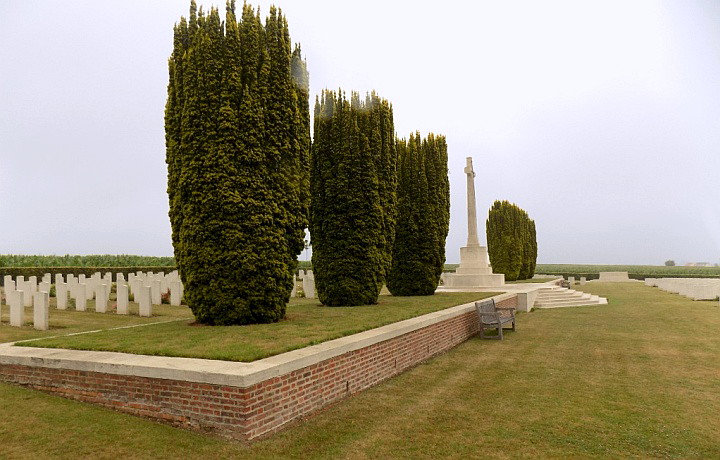
For much of the First World War, Abbeville was headquarters of
the Commonwealth lines of communication and No.3 BRCS, No.5 and No.2
Stationary Hospitals were stationed there variously from October
1914 to January 1920.
Abbeville Communal Cemetery was used for burials from November 1914
to September 1916, the earliest being made among the French military
graves. It now contains 774 Commonwealth burials from the
First World War and 30 from the Second. The Extension Cemetery
contains 1,754 First World War burials and 348 from the Second.
――――♦――――
GEORGE MILLS
Private, 112th Machine Gun Corps, service no. 84586.
Enlisted at Aylesbury, formerly with the RASC.
Born in Long Marston. Son of Mrs. Lucy Mills of 2 Tring Ford,
Tring.
Died of wounds on the 28th April 1917 aged 22.
Buried in Point-Du-Jour Military Cemetery, France, grave ref. I. C. 5..
The 112th Machine Gun Corps (MGC) [Note],
to which Private Mills was attached, was formed at Grantham.
In March 1916 it moved to France where it joined the 112th
Infantry Brigade in the 37th Division.
The 37th Division [Note]
was first formed as the 44th Infantry Division in March 1915, but in
May it was renumbered the 37th. Following training, the
Division crossed the Channel to Saint-Omer in France where it formed
part of VII Corps of the Third Army. The Division was to
remain on the Western Front [Note]
for the remainder of the war.
Although the actions in which the 112th MGC were involved
around the time of Private Mills’s death are documented, the
available information available doesn’t state when he received his
ultimately fatal wound, although it seems it was probably during the
fighting in the first half of the Arras campaign (9th April – 16th
May 1917) described below. |
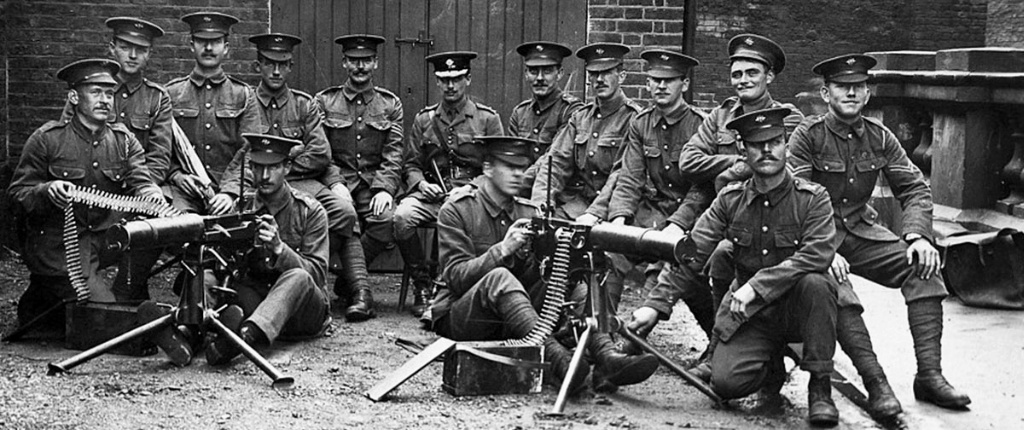
A machine gun section in 1914.
On the 9th April 1917 the 37th division moved to the Arras area
where it was to mount an attack on the fortified village of Monchy
Le Preux on the road from Arras to Cambrai. The objective of
the 112th Infantry Brigade supported by the 112th MGC was to
seize the spurs South of the village and to occupy village of
Guemappe.
At 2pm on the 10th April the machine guns opened fire on the German
lines around Guemappe. On the following day the attack resumed
at 5am with the German artillery pounding the MGC sections south of
the Arras-Cambrai road followed by German infantry attacks.
The MGC sections supported by the British artillery [Note] managed to drive
the enemy back to Guemappe but the attack had taken its toll.
Thus, on the 12th April, the 112th MGC was withdrawn and sent
to billets in Arras whilst some of the infantry of the 112th Brigade
supported its comrades in the 111th as they helped to take Monchy Le
Preux, but with heavy casualties.
On the 23rd April, during the Second Battle of the Scarpe (23rd-24th
April, a battle in the Arras campaign), the 112th Infantry Brigade
supported by the MGC sections attacked Greenland Hill north of the
fortified village of Roeux, which was a constant thorn in the side
of the British army throughout the Arras campaign. This from
the War Diary [Note] of the 112th MGC:
“22/4: 4.30pm Sections moved off at intervals for the Point Du
Jour where they were in support.
23/4: 4.45am Nos. 1 and 3 sections commenced barrage
according to programme. This barrage was kept up for 46
minutes. Some 30,000 rounds were fired.
10.15am No. 4 section
took up position and opened fire on large parties of enemy on
Greenland hill firing 20,000 rounds when they dispersed.
5.45pm The three
remaining battalions formed up with No. 2 section in Hurray trench
preparatory to an attack on Greenland Hill.
6pm The 112th Bde
had reached the Rouex – Garelle Road and were occupying it. No. 2
section was in position protecting the front.
11pm No. 1 sect and 2 guns of No. 3
sect into position for the attack next morning (which was cancelled)
24/4: No. 1 section throughout the day fired on parties
of the enemy on Greenland Hill.
25/4: 7.30am Both the enemy’s and our signals went up on the
right in the direction of Rouex. No. 1 section opened barrage
fire on South side of Greenland Hill and kept on until about 4.30pm
firing some 12,000 rounds.
26/4: During the day no. of parties of the enemy appeared.
No.1 sect fired at enemy’s aeroplanes whenever they appeared.
On one occasion plane appeared to be hit.
27/4: 4.45 am Barrage fire opened and Bde began to advance .
28/4: 12 noon During the day No. 3 section moved 2 guns
to communication trench firing on the railway embankment and on
enemy machine guns on our right flank throughout the day.
12 midnight. From
midnight the brigade was relieved with the exception of the Machine
Gun Coy.
29/4: The Coy was relieved during the night 29/30 April and
arrived in bivouacs by 2pm 30th April.
30/4: Moved by motor bus to billets in Denier.”
Although the Arras campaign continued into the summer, the 112th MGC
company took no further part after being withdrawn on the 29th/30th
April. In keeping with the role of the MGC companies
throughout the remainder of 1917 and into early 1918, the 112th was
used to harass the enemy lines, firing up to 35,000 rounds per day.
From the Parish Magazine June 1917:
“George Mills joined the A.S.C. a year
before the war broke out, and was a member of the first wonderful
expeditionary force which saved the situation in France in those
earlier and darker days of the German on rush. Later he
returned to England to be trained in the machine gun corps, and had
only been back at the front in his new capacity for three weeks,
when he was severely wounded and died on 28th April. His
Lieutenant, writing about his death, says ‘’he did his duty well and
bravely during the days of the attack, and I cannot tell you how
sorry we are to lose him. We did all we could for him and had
him carried down on a stretcher by our own men’”.
In the 1911 Census, George Mills (a butcher’s assistant, then aged
15) is recorded living with his parents, George (aged 45, cowman)
and Lucy (aged 44), at No. 1 Tring Ford. Also at the address
on Census night were George’s four brothers, Percy (aged 20,
carter), Albert (aged 15, farm labourer), John (aged 13, scholar)
and Arthur (aged 7, scholar). George Snr was born in Wilstone,
all the other family members in Long Marston.
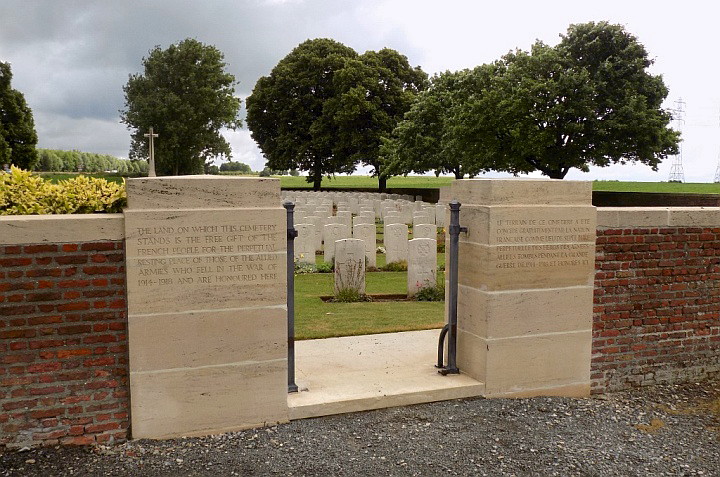
Athies was captured by the 9th (Scottish) Division, which included
the South African Brigade, on 9 April 1917 and remained in Allied
hands until the end of the war. Point-Du-Jour was a house on
the road from St. Laurent-Blangy to Gavrelle and by 1917 it had
become a German redoubt, captured by the 34th Division on 9 April.
Two cemeteries were made on the right of the road from St. Laurent-Blangy
to Point-du-Jour, No.1 Cemetery becoming the present Point-Du-Jour
Military Cemetery. It was used from April to November 1917,
and again in May 1918, and contained at the Armistice 82 graves (now
part of Plot I). It was then enlarged when over 650 graves
were brought in from the battlefields and small cemeteries north,
east and south of Arras.
There are now 794 Commonwealth servicemen of the First World War
buried or commemorated in this cemetery. 401 of the burials
are unidentified but special memorials commemorate 22 casualties
known or believed to be buried among them. Other special
memorials record the names of six casualties buried in other
cemeteries, whose graves were destroyed by shell fire. There
are also two memorials in the vicinity, one of which commemorates
the 9th Division, whilst the other commemorates the service of seven
Battalions of the Seaforth Highlanders in the neighbourhood.
――――♦――――
WILLIAM EDWARD NORWOOD
Driver, 54th Battalion, Machine Gun Corps,* service no. 50483.
*Until 19th April 1918 the 163rd Machine Gun Company, Machine Gun
Corps.
Son of Joseph and Sarah of 21 Akeman Street, Tring.
Died of malaria [Note] on the 4th December 1918, aged 23.
Buried in the Alexandria (Hadra) War Memorial Cemetery, Egypt, grave ref.
H. 23.
Private Norwood first enlisted in the Bedfordshire Regiment, but was
later transferred to the the 163rd Machine Gun Company,
Machine Gun Corps. [Note] This
unit, formed in May 1916 as part of the 163rd (Norfolk and
Suffolk) Infantry Brigade, was to see extensive active service
at Gallipoli and in the Middle Eastern Theatre as part of the
54th (East Anglian) Division. [Note]
No doubt Private Norwood saw much action against the Ottomans during
the Palestine Campaign, [Note] in which he was wounded, so it is
particularly sad that he was to succumb to malaria in Egypt shortly
before he was due to return home.
From the Bucks Herald 22nd February 1919 (also reported in
the Parish Magazine):
“News has been received of the death in
Egypt on Dec. 4 of Driver W. E. Norwood, son of Mr. Joseph Norwood,
Akeman-street, Tring, after an attack of malaria. Driver
Norwood, who was 23 years of age, joined the Bedford Regiment about
four years ago, and was afterwards transferred to the Norfolk
Regiment and posted to the Machine Gun Company on going to Egypt
three years ago. He was wounded in the arm in April, 1917, but made
a speedy recovery, and soon returned to duty.
Major Culme Seymour, commanding 54th M. G. Batt., writing to the
father, says: ‘It may be a pleasure to you to know that while he was
with us your son was always looked upon as a hard working,
industrious and reliable soldier, popular with his comrades.
He was buried on Dec. 5 in the new Military Cemetery at Alexandria.
I should like to offer you my sincere sympathy in your loss.’
Before joining, Norwood was employed at Pendley stables, and was
held in the highest esteem by Mr. and Mrs. Williams, as well as by
his fellow workers. Much sympathy is felt for his father and
relatives in their sad loss.”
.jpg)
Alexandria (Hadra) War Memorial
Cemetery.
In March 1915, the base of the Mediterranean Expeditionary Force was
transferred to Alexandria from Mudros and the city became a camp and
hospital centre for Commonwealth and French troops. Among the
medical units established there were the 17th, 19th, 21st, 78th and
87th General Hospitals and No 5 Indian Hospital. After the
Gallipoli campaign of 1915, Alexandria remained an important
hospital centre during later operations in Egypt and Palestine and
the port was much used by hospital ships and troop transports
bringing reinforcements and carrying the sick and wounded out of the
theatres of war.
This cemetery was begun in April 1916 when it was realised that the
cemetery at Chatby would not be large enough. Most of the
burials were made from the Alexandria hospitals, but a number of
graves of December 1917 were due to the loss of the troop transports
Aragon and Osmanieh which were sunk by torpedo and
mine as they entered the port. The cemetery continued in use
until December 1919 but later, some graves were brought in from
small burial grounds in the western desert, Maadia and Rosetta.
There are now 1700 First World War burials in the cemetery.
――――♦――――
GEORGE OAKLEY
Private, 12th (Service) Battalion Northumberland Fusiliers, service no.
267018.
Born at Wilstone, Herts. Son of Mrs. Sarah Oakley of 64 Akeman Street,
Tring.
Enlisted at Halton Park, formerly with the Hertfordshire
Regiment.
Killed in action on the 25th October 1917 aged 20.
No known grave. Commemorated on Tyne Cot Memorial, Belgium,
panels 19 to 23
and 162.
The 12th (Service) Battalion The Northumberland Fusiliers was
formed at Newcastle in September 1914 as part of Kitchener’s Third
New Army (K3) [Note] forming part of the
62nd Brigade, 21st Division. [Note]
The Division concentrated in the Tring area, training at Halton Park
[Note] before winter necessitated a move into local billets in Tring,
Aylesbury, Leighton Buzzard, High Wycombe and Maidenhead. The
artillery was at High Wycombe and Berkhamsted, Royal Engineers at
Chesham, and Army Service Corps at Dunstable.
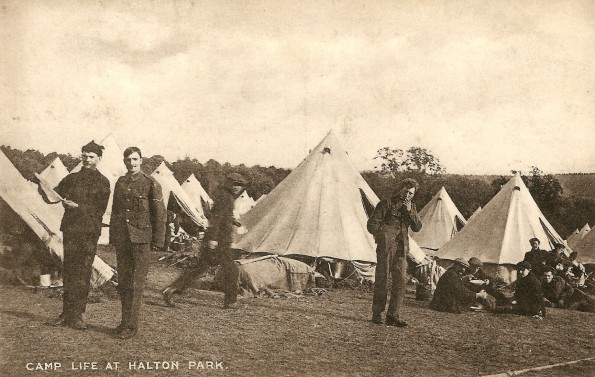
In May 1915 the infantry moved to huts at Halton Park, whilst the
artillery moved to Aston Clinton with one brigade staying at
Berkhamsted and the Royal Engineers to Wendover. On the 9th
August they moved to Witely Camp, a temporary army camp set up on
Witley Common, Surrey, during both World Wars. They proceeded
to France during the first week of September.
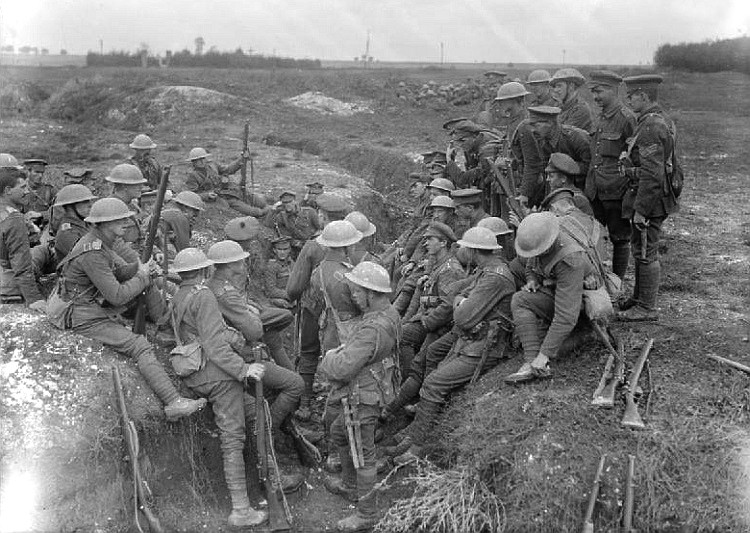
Northumberland Fusiliers at Thiepval,
September 1916.
The 12th and 13th Battalions were amalgamated in August 1917 as the
12th/13th (Service) Battalion, and as such remained in the
62nd Brigade, 21st Division on the Western Front for the rest of the
war, engaging in various actions including:
1915: The Battle of Loos, in which the Division suffered over
3,800 casualties for little gain and took the rest of the year to
rebuild.
1916: The Battle of Albert, The Battle of Bazentin Ridge, The
Battle of Flers-Courcelette, The Battle of Morval, The Battle of Le
Transloy.
1917: The German retreat to the Hindenburg Line, The First
Battle of the Scarpe, The Third Battle of the Scarpe, The flanking
operations around Bullecourt, The Battle of Polygon Wood, The Battle
of Broodseinde, The Second Battle of Passchendaele, The Cambrai
Operations.
1918: The Battle of St Quentin, The First Battle of Bapaume,
The Battle of Messines, The Second Battle of Kemmel, The Battle of
the Aisne 1918, The Battle of Albert, The Second Battle of Bapaume,
The Battle of Epehy, The Battle of the St Quentin Canal, The Battle
of Cambrai 1918, The Battle of the Selle.
The Battalion ended the war near Berlaimont in France.
From the Bucks Herald, 24th November 1917:
“Pte. George Oakley was the only son of
Mrs. Oakley, a widow residing in Akeman-street. He joined the
Northumberland Fusiliers on attaining the age of 18 years some two
years ago. Sent to France, he remained there for seven months
before being invalided home with trench feet. [Note] Making a rapid
recovery, he returned to the scene of hostilities some six months
ago, and took part in many of the actions of the past summer and
autumn. His mother has now been officially informed that he
was killed in action early in the present month, and has been buried
in France.
Before joining up Oakley was employed on the Tring Park Estate and
by Mr. J. Timberlake, Hastoe, who speaks highly of his character.
Oakley was a member of the local branch of the Y.M.C.A., and as a
members of the gymnastics team was most enthusiastic in the many
excellent displays given. There are no more sincere mourners
at his loss than the present members of the team, many of whom are
serving in the Forces, while some, alas! have laid down their lives
in the great cause. The utmost sympathy is felt for Mrs.
Oakley in the loss of her son.”
Private Oakley was reported killed on the 25th October 1917 during
the third Battle of Ypres (Passchendaele). His Battalion was
then at Zillebeke, about 1½ miles south-east of Ypres.
However, the 12/13th Battalion War Diary [Note] carries no report of
fatalities on the 25th October or in the immediately adjoining days.
After heavy fighting on the 4th October (Battle of Broodseinde), the 12/13 Bn.
War Diary states
that on the 6th October the Battalion arrived Zillebeke Lake at 3 a.m.
“and went into dugouts” − it reports 7 officers killed and 12
wounded; with 44 other ranks killed and 320 wounded, but does not
state the circumstances in which these casualties arose.
On the 28th October, 2nd Lieut. E. S. Milne was killed − again the
circumstances are not given − whilst Brigadier C. S. Rawling
(Brigade commander) was killed by German shellfire whilst chatting
to friends outside his headquarters at Hooge Crater (a massive
crater left after a mine was blown by the 175th Tunnelling Company
on the 19th July 1915). No other fatalities
are recorded in October.
Whereas the Commonwealth War Graves Commission give
Oakley’s date of death as 25th October, the brief obituary
that appeared in the 24th November edition of the Bucks Herald states “that
he was killed in action early in the present month.”
It is possible therefore that the official date of death is wrong,
and that Private Oakley was killed on 6/7th November when B Coy of
the Battalion were subjected to heavy shelling and “2 O.R.”
(other ranks) were killed.
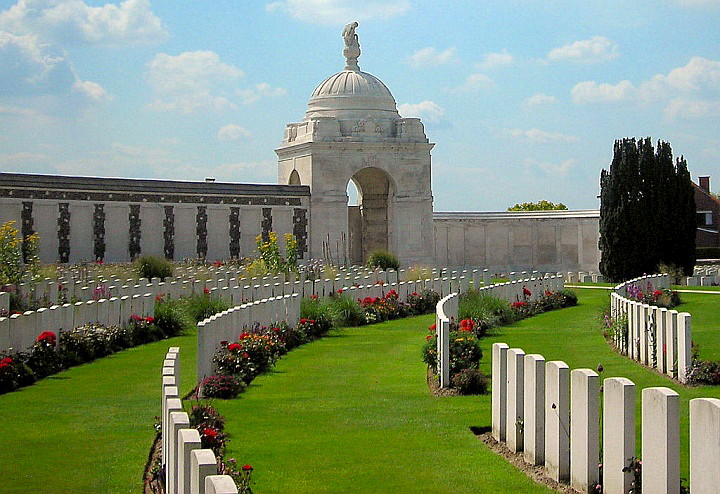
The Tyne Cot Memorial is one of four memorials to the missing in
Belgian Flanders which cover the area known as the Ypres Salient. Broadly speaking, the Salient stretched from Langemarck in the north
to the northern edge in Ploegsteert Wood in the south, but it varied
in area and shape throughout the war.
The Salient was formed during the First Battle of Ypres in October
and November 1914, when a small British Expeditionary Force
succeeded in securing the town before the onset of winter, pushing
the German forces back to the Passchendaele Ridge. The Second Battle
of Ypres began in April 1915 when the Germans released poison gas
into the Allied lines north of Ypres. This was the first time gas
had been used by either side and the violence of the attack forced
an Allied withdrawal and a shortening of the line of defence.
There was little more significant activity on this front until 1917,
when in the Third Battle of Ypres an offensive was mounted by
Commonwealth forces to divert German attention from a weakened
French front further south. The initial attempt in June to dislodge
the Germans from the Messines Ridge was a complete success, but the
main assault north-eastward, which began at the end of July, quickly
became a dogged struggle against determined opposition and the
rapidly deteriorating weather. The campaign finally came to a close
in November with the capture of Passchendaele.
The Tyne Cot Memorial (not to be confused with the Tyne Cot
Cemetery) now bears the names of almost 35,000 officers and men
whose graves are not known.
――――♦――――
WILLIAM OAKLEY
Private William Edwin Oakley, 7th (Service) Battalion, Royal Sussex
Regiment, service no. G/4828
Son of Mr. Edwin Richard and Mrs. Ruth Oakley of 3 New Town, New
Mill, Tring.
Killed in action on the 1st August 1916.
No known grave. Commemorated on the Thiepval Memorial, France,
pier
and face 7C.
The 7th (Service) Battalion, [Note]
Royal Sussex Regiment, was formed at Chichester on 12 August 1914 as
part of the First New Army (K1) [Note]
and allocated to 36th Brigade, 12th (Eastern) Division with
which it served throughout the war. The Battalion landed in
France on 1st June 1915 and remained on the Western Front,
distinguishing itself in many battles, including Loos, Hohenzollern
Craters, the Somme, Arras, Cambrai and the final advance.
Private Oakley is recorded as having been killed in action on the 1st August 1916.
The Battalion War Diary [Note]
suggests that this was during the Battle of Pozières, an action that
took place around that village during the Battle of the Somme.
However, the War Diary records no incidents
on that particular day that would account for Private Oakley’s death, but
fatalities did occur on both the preceding and following days, while earlier in
July the War Diary entry for the 8th reads “Casualties
on 7 July 1916 and 8 July 1916 were 20 officers and 508 other ranks
(estimated)”− even the Battalion appear unsure of
their losses − although this entry gives no indication of the number of
deaths within these figures.
The following entries are from the War Diary around the date
(according to the Commonwealth War Graves Commission) of Private
Oakley’s death:
“TRENCHES, LA BOISSELLE OVILLERS LINE,
29 July: Supplied party of 100 to carry bombs to
11th Middlesex Regiment in front line and 50 to carry water.
Commanding Officer and Company Commanders reconnoitred trenches in
morning. Casualties 1 other rank wounded.
TRENCHES, LA BOISSELLE OVILLERS LINE, 30 July: At
11:00 AM received orders from Brigade to relieve 11th Middlesex
Regiment in front line west of POZIÈRES, relief complete by 4:15 PM.
At 4:30 PM orders were received that in conjunction with the 11th
Middlesex Regiment an attack was to be made against a strong point
and 100 yards of enemy trench on the left flank. Lieutenant
Colonel PARGITER 11th Middlesex Regiment was in charge of the
operations. A party of 50 Middlesex Regiment made a frontal
attack from the south whilst 50 of ‘D’ Company 7th Royal Sussex
Regiment in bombing formation made a demonstration on the northern
flank to divert the enemy’s attention. The frontal attack lost
direction and entered our own trench 150 yards north of where they
started from, the attack was therefore a failure. Casualties
other ranks 4 killed, 1 missing, 24 wounded.
TRENCHES WEST OF POZIÈRES, 31 July: At 1:00 PM
orders were received from Brigade that that the attack which failed
last night on German strong point was to be resumed again tonight at
10:30 PM. The preparations were the same with the exception
that in the event of the Middlesex Regiment attack failing a strong
bombing party of 7th Royal Sussex Regiment were to work down the gap
as far as possible and try to gain the objective. The
Middlesex Regiment attack was discovered as soon as it started and
they were prevented reaching the German Trench by machine gun and
rifle fire. Our bombing party then worked down the gap and
captured and consolidated 50 yards. Beyond this they were held
up by a machine gun in a straight piece of trench. A second
attack was launched by the Middlesex Regiment to try to get behind
the machine gun. This attack also failed. We completed
consolidation and held the captured 50 yards. Casualties 7
other ranks killed, 19 wounded.
TRENCHES, POZIÈRES, 1 August: Fairly heavy
shelling of communication and support trenches during day and night.
TRENCHES, POZIÈRES, 2 August: Usual shelling day
and night.”
TRENCHES, POZIÈRES, 3 August: 8th Royal Fusiliers
attacked RATION TRENCH at 9:00 PM after artillery preparation and
captured most of it.
TRENCHES, POZIÈRES, 4 August: At 3:00 AM received
orders to send one Company over to RATION TRENCH to get in touch
with 8th Royal Fusiliers and work up to the right; also one Platoon
to attack strong point on the right, after this had been captured
they were to work down RATION and get in touch with ‘A’ Company.
‘A’ Company went too much to the left but reached RATION TRENCH
finding the Buffs already there. Colonel COPE (Officer
Commanding Buffs) ordered ‘A’ Company to push forward and take the
ridge, which they reached without any difficulty, but were heavily
counter attacked and obliged to fall back to RATION TRENCH.
The Platoon on the right came under heavy machine gun fire and were
not able to capture the strong point. Later in the day orders
were received for two Companies to attack the right of RATION TRENCH
in conjunction with attack of 9th Royal Fusiliers. Two
platoons were again to attack strong point on right from POZIÈRES
TRENCH. ‘B’ and ‘D’ Companies attacked across the open but
lost direction, some however, reached their objective and got in
touch with 9th Royal Fusiliers. The two Platoons of ‘C’
Company were unable to capture strong point owing to heavy machine
gun fire. The result of the operation was that practically the
whole of RATION TRENCH was captured and consolidated.
Casualties during two days. 2nd Lieutenants WOOD, LE DOUX
VEITCH killed. 2nd Lieutenants COOKE, FITZSIMONS, ROLFE
missing. Captain TROWER, 2nd Lieutenants D’ALTON, GLENISTER, HOWE,
BROWNING wounded. Other ranks 18 killed, 25 missing,
109 wounded.
From the Bucks Herald, 26th August 1916:
“Private Oakley Killed. Another name has to
be added to Tring’s Roll of Honour, Private W E Oakley, only son of
Mr and Mrs Oakley of New Town, New Mill, a bright and promising lad
of 21 was killed in action on August 1st. He was with the
Expeditionary Force on the Western Front. He joined the 3rd
Sussex Regiment in January 1915. He was employed at the Grand
Hotel, Brighton.
He joined the 3rd Sussex Regiment in January 1915, and was
afterwards was transferred to another battalion. After
training at Chester, Dover, and Newhaven, he went to France about 9
months ago. During the time he was at the front he had some
terrifying experiences and some narrow escapes. Two or three
times he was buried by shell explosions, and once a bullet passed
through his helmet. He saw his personal chums fall beside him,
before the engagement in which he himself was killed, and there were
none of his friends left to send his parents any particulars of how
he met his death.”
From the Parish Magazine, September 1916:
“William Edwin Oakley was killed on August
1st in the advance on the western front. He enlisted in
January of 1915, and has been in France for the last nine months.
Those who knew him well, speak of him as a good living lad with
earnest religious convictions. When he was in Newhaven, he
took an active lead in the organisation of services for the men
stationed there.”
William Edwin Oakley was born in Birmingham in 1895. The 1901
Census shows the family living in Kings Norton, Worcestershire, the
household then comprising William, his two sisters Lily (aged 4) and
Minnie (aged 3) and their parents Edwin Richard (aged 28, a house
painter) and Ruth née Stratford (aged 27, formerly of New Mill,
Tring). The 1911 Census lists Lily (aged 14, nurse maid) and
her parents, Edwin (aged 39, house painter) and Ruth (37), living at
No. 3 New Town, New Mill, Tring − William (aged 16) is listed
separately under the Station Hotel, Tring, where he was employed as
a house boy.

Located near the village of Thiepval, Picardy, in France, the
Thiepval Memorial to the Missing of the Somme commemorates the
72,246 missing British and South African servicemen who died in the
Battles of the Somme between 1915 and 1918, and who have no known
grave. Designed by Sir Edwin Lutyens, the Thiepval Memorial
ranks among the greatest executed British works of monumental
architecture of the twentieth century.
――――♦――――
HENRY RICHARD PHILB[E]Y
Lance Corporal, 2nd Bedfordshire Regiment, service no. 8785.
Killed in action in Belgium on the 26th July 1917 aged 30.
Born in Bovingdon. Son of Edward
Philby of
Chesham.
Husband of Lillian (Lily) of 11 Bunstux Hill, Tring.
Buried in Dickenbusch New Military Cemetery Extension, Belgium, grave ref.
III F 10.
The 2nd Battalion of the Bedfordshire Regiment was a pre-war regular army
battalion dating back to 1858. At the outbreak of war the
Battalion was stationed at Pretoria, South Africa. On their
return to England in September 1914 they moved to Lyndhurst to join
the 21st Brigade of the 7th Division. [Note]
In the following month they mobilised for war, landing at Zeebrugge.
Thereafter, they served entirely on the Western Front where they engaged in
major actions that included:
1914: the First Battle of Ypres (the Division suffered
huge losses and took the rest of the year to rebuild).
19.12.1915: transferred to the 89th Brigade of the same
Division.
1915: The Battle of Neuve Chapelle, The Battle of
Aubers, The Battle of Festubert, The second action of Givenchy, The
Battle of Loos.
1916: The Battle of Albert, The Battle of Bazentin,
The Battle of Delville Wood, The Battle of Guillemont, Operations on
the Ancre.
1917: The German retreat to the Hindenburg Line, The
Battle of Polygon Wood, The Battle of Broodseinde, The Battle of
Poelcapelle, The Second Battle of Passchendaele.
11.02.1918 Transferred to the 90th Brigade of the 30th Division.
22.05.1918 Transferred to the 54th Brigade of the 18th Division.
1918: The Battle of Albert, The Second Battle of
Bapaume, The Battle of Epehy, The Battle of the St Quentin Canal,
The Battle of the Selle, The Battle of the Sambre.
11.11.1918 Ended the war at Louvignies, France.
It is estimated that over half of the 60,000 c.a. men who served in
the Regiment between 1914 and 1919 became casualties, with at least
7,200 never returning home.
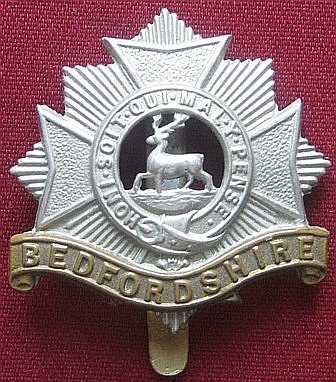
The following entry is from the 2nd Battalion War Diary [Note] covering the day on which Lance-Corpl. Philby
(sometimes spelt Philbey) and others were killed while sheltering
from shellfire. The Battalion were at that time in the line at
Zillebeke, a village 1½ milesouth east of Ypres, an area that saw
much heavy fighting. Although the village remained in British
hands for most of the war, the front lines were never far away:
“26 Jul 1917 Battalion in the Line
at ZILLEBEKE and Reserve at CHATEAU SEGARD. Major R. O. Wynne, D.S.O.
proceeded to 30th Division as Liaison Officer. Lt. Colonel C. H. de
St. P. Bunbury proceeded to Trenches to Command Battalion. At
5 p.m. the 2nd Bn. Yorkshire Regiment and 18th Bn. Manchester
Regiment carried out a raid in front of this Sector with successful
results. No. 8718 Cpl. F. Aveling, 2nd Bn. Bedfordshire Regiment,
awarded the Military Medal for gallantry in this raid.
Casualties; 2nd Lieutenant G. Lenton wounded. Other Ranks: 11
Killed 19 wounded. These included a party under C.S.Major
R. Kirby who were returning to CHATEAU SEGARD (17 Strong) and were
knocked out by a shell near BEDFORD HOUSE, of which 6 were Killed.
5 Died of wounds. 6 Wounded.”
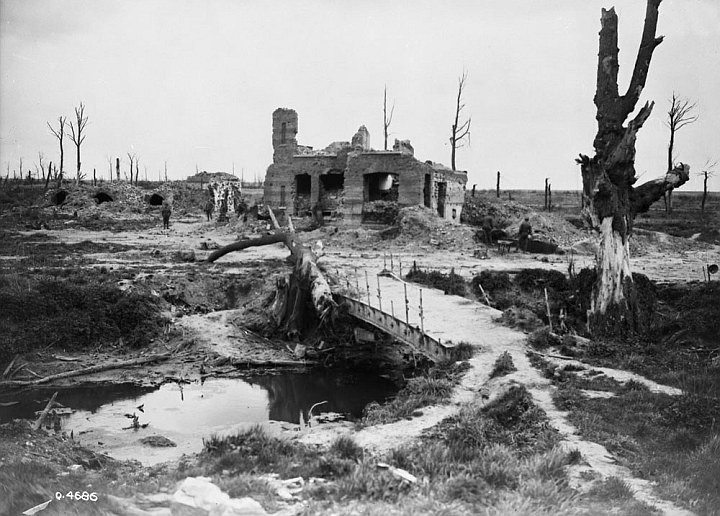
|
Above: before the war this
was the site of the country mansion ‘Chateau
Rosendal’, the ‘Bedford House’ referred to in the War
Diary extract above. Bedford House served as a
dressing station and later as a brigade headquarters.
Much of it was destroyed during the war, but the moat
can still be seen today. Below: the ruins
of
Chateau Segard, also referred to above, in 1916. |
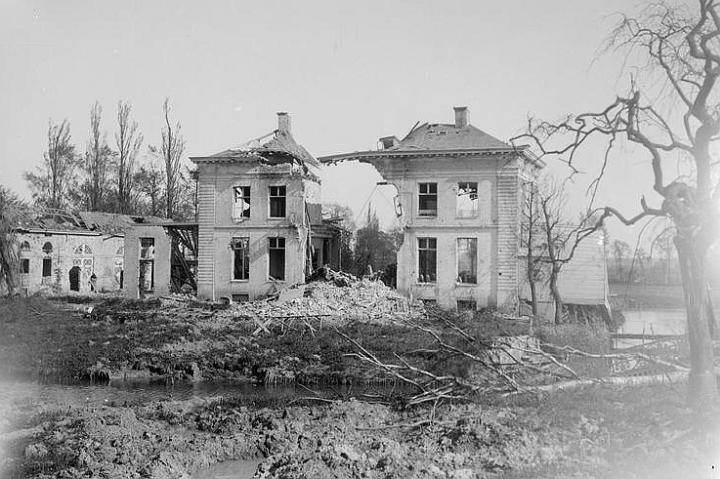
“27 Jul 1917 Battalion in the line at
ZILLEBEKE and Reserve at CHATEAU SEGARD. 2nd Lieutenant E
Lenton died of wounds. Casualties: 1 O.R. Killed. 5 O.R.
wounded.
28 Jul 1917 Enemy reported to be evacuating his Front System
of Trenches North of YPRES. At 12.30 a.m. 2 Strong Patrols
were ordered to go out and reconnoitre Enemy’s Front Line to
ascertain if they were withdrawing on our Front. Patrols from
‘A’ and ‘B’ Companies went out - see attached reports.
CASUALTIES: 2nd Lieut. I. T. M. Collins Missing. 2nd Lieut. P.
A. Page wounded. Other Ranks: Killed 8 Wounded 17 Missing 4
Gassed 18. At about 11 p.m. 2nd Bn. Yorkshire Regiment
commenced to relieve the Battalion in the Trenches. Relief
complete about 4.30 a.m. 29/7/17. The Battalion then withdrew
to CHATEAU SEGARD. The total Casualties during this tour in
the trenches were: 2nd Lieutenant G. Lenton died of Wounds; 2nd
Lieut. I. T. M. Collins missing; 2nd Lieut. P.A. Page wounded. Other
Ranks: Killed 20 Died of Wounds 5 Wounded 43 Missing 4 Gassed 18 =
90. Sick Wastage week ending 28th 3 O.R.”

A platoon of the Bedfordshire Regiment
marching to the front before the start of the Somme, 1916.
From the Bucks Herald, 4th August 1917:
“We have to record with regret the death of
Lance-Corpl. Henry Philby, Bedfordshire Regiment, who met his death
in France on July 27. The sad news was conveyed to his wife on
Thursday morning in letters from the Chaplain and his Platoon
Sergeant, from which it appears that a shell penetrated the
shelter in which Philby and several comrades were sitting, killing
him instantly.
The unfortunate young fellow has seen army service previous to the
war, and was called up as a Reservist, being one of the first to
land in France after the commencement of hostilities. He was
wounded in the following November, and after a long time in England
returned to France some 12 months ago, since when he has been
carrying out the responsible duties of regimental cook. A sad
coincidence is that Philby was killed in the same district in which
his brother, Charles Philby, of the same regiment, met his death
early in the war.
He was well known in Tring, chiefly as attendant and door keeper at
the Gem Picture House. Amongst his comrades he was most
popular, and was respected by all. He was married, his wife
being a daughter of Mr. James Butler of Frogmore-street, and leaves
her and a little boy to mourn their loss. The deepest sympathy
is felt for them in the sad circumstances. The remains were
buried in Dickenbusch Cemetery, near to the Church, on July 28.”
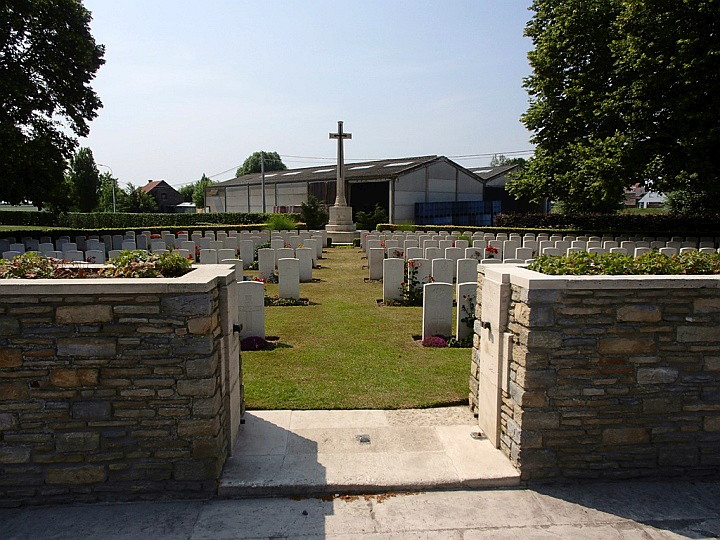
The Dickenbusch New Military Cemetery Extension was begun in February 1915 and was used
until May 1917 by fighting units and field ambulances, with a few
further burials taking place in March and April 1918. The Extension
was used from May 1917 to January 1918. The New Military Cemetery
contains 624 First World War burials, including 8 unidentified, the
Extension contains 547 including 5 unidentified.
――――♦――――
HAROLD EDWARD POPE, M.C. and Bar
Acting Captain, 1st/2nd Lancashire Heavy Battery, Royal Garrison
Artillery.
Son of the Rev. A. F. Pope of Tring and Catherine I. E. Pope (née
Rose) of Kilravock, Scotland.
Educated at Winchester and New College, Oxford.
Killed in action on the 24th August 1918 aged 36.
Buried in Heath Cemetery, Harbonniers, France, grave ref. III. E. 8.
In 1914 the British army possessed little heavy artillery, but in
the course of the war the Royal Garrison Artillery (RGA) [Note] grew
into a large component of the British forces. In his White
Heat – the new warfare 1914-18, John Terraine says that “The
war of 1914-18 was an artillery war: artillery was the
battle-winner, artillery was what caused the greatest loss of life,
the most dreadful wounds, and the deepest fear”.
As British artillery tactics developed, the heavy batteries of the
RGA were usually employed in destroying or neutralising enemy
artillery as well as putting destructive fire down on strongpoints,
dumps, store, roads and railways behind enemy lines. They were
usually equipped with 60 pounder (5 inch) guns positioned well
behind the infantry battle line, firing at unseen targets using map
co-ordinates calculated with geometry and mathematics. Later
in the war the RGA was supported by the Royal Flying Corps who
devised a system whereby pilots could use wireless telegraphy to
help the artillery hit specific targets.
At the time of his death on the 24th August 1918, Captain Pope was
acting as Heavy Artillery Liaison Officer of the 32nd Division.
He was killed at Bayon-Villers near Amiens by a bomb dropped by an
enemy aircraft − the explosion also killed Major L. H. Amory and
wounded a number of other personnel. |
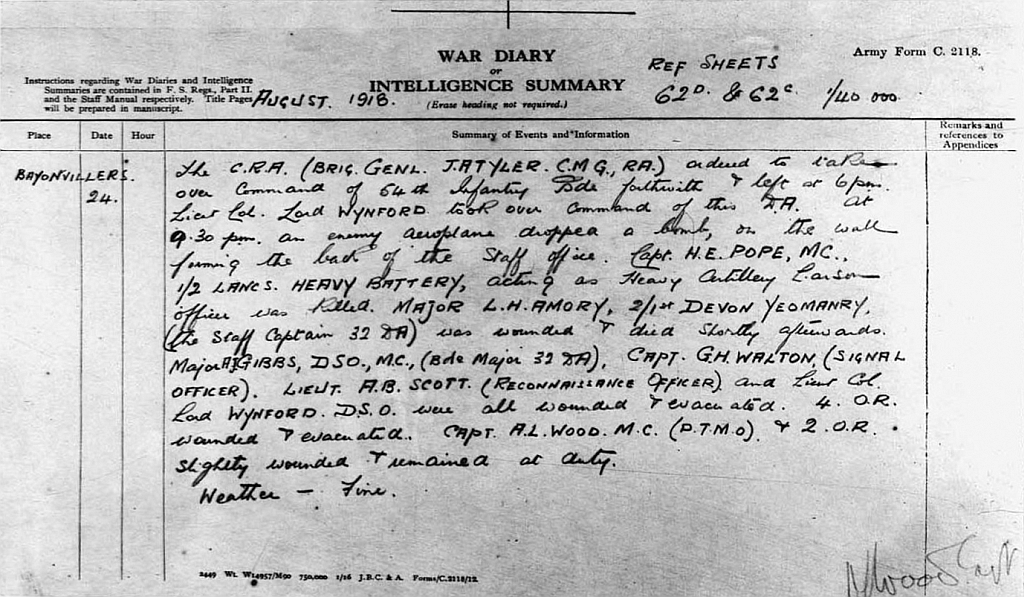
Extract from the War Diary [Note] of the 32nd Division,
Royal Field Artillery, covering 24th August 1918.
|
From the Parish Magazine, October 1918:
“Harold Edward Pope, at the outbreak of
war, when the news of hostilities reached him in Sumarta and Java at
once resigned from a very good position and returned home to take
part in this struggle for our existence as a nation. He joined
the Inns of Court O.T.C, as a trooper, and on the completion of his
training, was immediately given a commission in the Royal Garrison
Artillery. In June of 1915, he crossed with the 118th Heavy
Battery to France, but owing to a reorganisation was transferred to
1st/2nd Lancashire Heavy Battery.
For over three years he served continuously in France, and assisted
in practically every large operation that has taken place on the
western front during that period. He was awarded The Military
Cross on the 16th August 1917 for an act of great bravery. The
official description of which is as follows: ‘He showed the greatest
personal courage and presence of mind in combing on the top of a
blazing gun pit and extinguishing a fire which was threatening to
blow up the whole of the ammunition at any moment. There were
thirty rounds of high explosive shells in the blasting pit whilst he
was standing on the top.’ For another act of equal gallantry,
on 5th February 1918 he won a Bar to his Military Cross at Gouzeaucourt, a village, between Peronne and Cambrai. The
incident is thus described in the London Gazette: ‘He kept
his battery in action under direct machine gun fire and sniper fire
and checked the enemy’s advance. He did not cease fire till
the enemy was within two hundred yards and the infantry had
withdrawn through the position. He then personally
superintended the dismantling of his guns’.
A brother officer of his thus writes of him: ‘To the battery his
death is the greatest blow it has yet received in France. Our
good name was due so greatly to his bravery, hard work, and great
example. He can fitly be described as a very gallant officer
and a gentleman, and as such he was beloved and trusted by all
ranks. There is not a man who does not feel his loss.’”
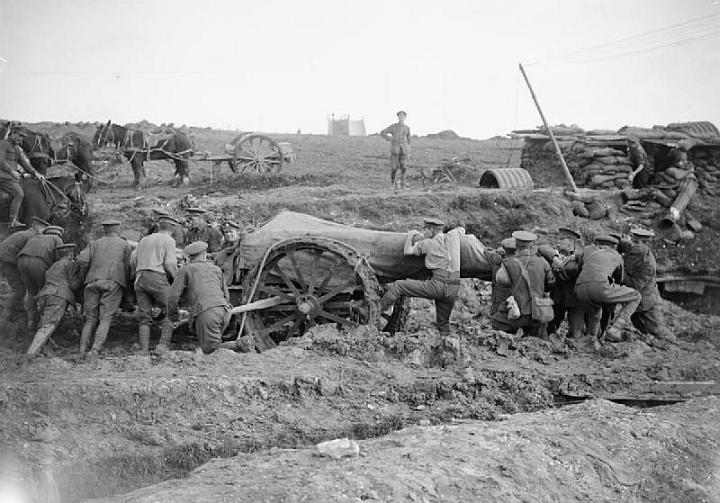
Manhandling a 60 pounder on the Somme,
1916.
Harold Edward Pope was the son of the Reverend Arthur Frederick Pope
of Tring; his mother was Catherine Isabella Ellen Pope, daughter of
Major James Rose, of Nairn in Scotland. He went up to Winchester
College, Oxford, from Mr. T. H. Mason’s school at Rottingdean.
Always a keen student of natural sciences he gained a First in the
Natural Science School in 1904. His chosen career was as a
mining engineer, and after a course at the Royal School of Mines,
South Kensington, went to Borneo in the service of the Borneo
Company, and subsequently joined a large gold and oil company in
Sumatra as a geologist.
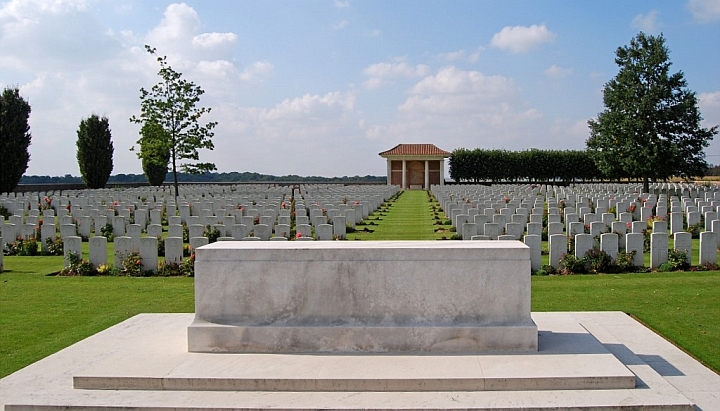
Heath Cemetery, Harbonnieres, so called from the wide expanse of
open country on which it stands, was made after the Armistice, next
to a French Military Cemetery now removed, when graves were brought
in from the battlefields between Bray and Harbonnieres and from
other burial grounds in the area. The earliest date of death
is September 1915, the latest October 1918, but the majority died in
March or August 1918. There are now 1,860 Commonwealth
servicemen of the First World War buried or commemorated in this
cemetery. 369 of the burials are unidentified but there are special
memorials to 26 casualties known or believed to be buried among
them. Other special memorials record the names of 21
casualties buried in other cemeteries, whose graves could not be
found.
――――♦――――
HARRY POULTON
Private, 2nd Bn. Highland Light Infantry, service no. 9386,
Born in Tring. Married Clara Fountain in 1913.
Enlisted in London. Killed in action on the 20th September
1914 aged 28.
No known grave. Commemorated on La Ferte-Sous-Jouarre
Memorial, France.
The Highland Light Infantry was formed in the 1881 Army reforms by
merging the 71st (Highland) Regiment of Foot (Light Infantry) and
the 74th (Highland) Regiment of Foot, which became its 1st and 2nd
Battalions respectively. Both the earlier regiments were
highland units, but because the new regiment recruited in Glasgow it
became the only highland regiment given the lowland uniform of trews
(trousers).
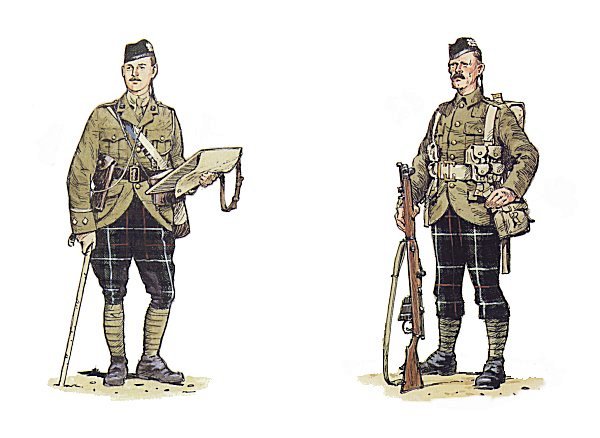
At the outbreak of war the 2nd Battalion was stationed at Aldershot
where it formed part of the 5th Brigade in the 2nd
Division. [Note]
Mobilised for war, the Battalion landed at Boulogne on the 14th
August 1914, thereafter engaging in various actions on the Western
Front [Note] including:
During 1914: The Battle of Mons and the subsequent retreat, The
Battle of the Marne, The First Battle of the Aisne, The First Battle
of Ypres.
During 1915: Winter Operations 1914-15, The Battle of Festubert, The
Battle of Loos.
During 1916: The Battle of Delville Wood, The Battle of the Ancre,
Operations on the Ancre.
During 1917: The German retreat to the Hindenburg Line, The First
and Second Battle of the Scarpe, The Battle of Arleux, The Battle of
Cambrai.
During 1918: The Battle of St Quentin, The Battle of Bapaume, The
First Battle of Arras 1918, The Battle of Albert, The Second Battle
of Bapaume, The Battle of Havrincourt, The Battle of the Canal du
Nord, The Battle of Cambrai 1918, The Battle of the Selle.
Armistice: the battalion was at Villers Pol in France. |
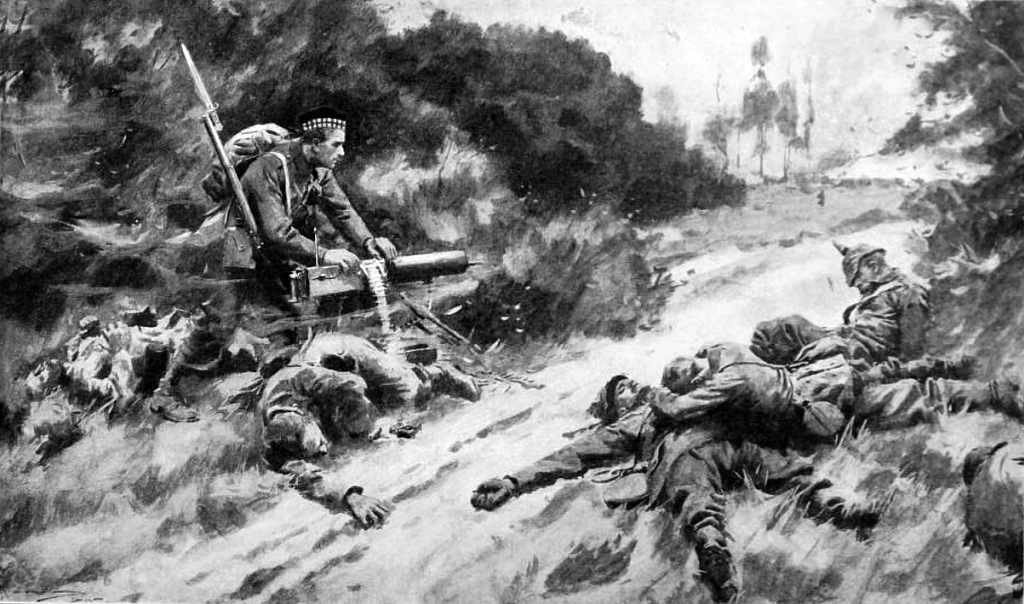
|
Private George Wilson, VC. 2nd Bn.
Highland Light Infantry.
For most conspicuous gallantry on the 14th of September near
Verneuil, in attacking a hostile Machine Gun, accompanied by
only one man. When the latter was killed, he went on
alone, shot the Officer and six Men working the Gun, which he
captured. |
|
Private Poulton appears to have been killed in fighting that took
place during the later stages of the First Battle of the Aisne.
This battle was a follow-up offensive by the Allied forces against
the right wing of the German First and Second armies, who were in
retreat following the First Battle of the Marne. The Germans,
by then joined by the new Seventh Army, halted their retreat at the
River Aisne where they entrenched themselves along the north bank.
On the evening of the 12th September the Allied offensive began.
It was met by effective German machine gun and heavy artillery fire,
and the small advances that the Allies achieved could not be
consolidated.
Fighting was finally abandoned by the Allies on the 28th September,
by when it had become clear that neither side − in particular the
Allies − would be able to mount successful frontal attacks upon the
well-entrenched positions of their adversary. Instead, both
forces began attempts to out-manoeuvre the other in what became a
progression of northward movements, the so-called ‘Race to the Sea’.
[Note]
Although Private Poulton was killed on the 20th September, his wife
was not informed until the following January, which suggests that he
might at first have been considered ‘missing’ in the casualties
recorded in the 2nd Highland Light Infantry War Diary [Note]
entry for the 20th September:
“13th Sept: 4.00pm Paraded and crossed River Aisne at
Pont Arcy by repaired bridge and position Brigade. Shelled
whole company crossing, but no damage done. Battalion took up
outpost position at Verneuil.
14th Sept: Ordered to reinforce troops holding the top
of Verneuil bridge at 12noon. Enemy driven back. After dark advanced
with Brigade as far as Chemin des Dames. Brigade not supported on
right or left, so returned to Verneuil. During the day part of ‘D’
company under Sir A. C. Gibson Craig charged the enemy and killed a
large number.
15th Sept: Returned to Verneuil ridge at daybreak and dug in.
Heavy shelling all day.
16th Sept: Germans attacked about 10.00am, but it was not
pushed home. Very heavy shelling all day.
17th Sept: Battalion remained in trenches on the ridge
all day subjected to very heavy shell fire. The Worcester Regiment
took over trenches at night and the Battalion withdrew to billets in
Verneuil at night.
13th−17th: Killed: Sir A. C. Gibson Craig Best, 2nd Lte R. C. H.
Powell, 10 NCO’s and men. Wounded: Captain C. T. Martin, Lte J. Mc.
D. Latham, 2nd Lte R. Whister, 79 NCO’s and men. Missing: 14 NCO’s
and men.
18th Sept: Battalion all day in village of Verneuil.
Returned to trenches on hill at night.
1 man wounded.
19th Sept: In trenches on Verneuil ridge all day.
Continued shelling. 2 men wounded.
20th Sept: Heavy rifle fire at 6.00am. Attack repulsed.
Germans noticed to be entrenching themselves about 300yards from our
advanced trenches. 2 platoons under Lte Lilburn (‘B’ company)
with two companies of Worcester regiment made a gallant, but
unsuccessful attack on German trenches. Killed: 2nd Lte J. A.
Fergussson, C. L. MacKenzie, E. R. H. K. McDonald, J. O’Connor (RAMC),
15 NCO and men. Wounded: Captain A. W. D. Gausson, Lte R.
Lilburn, 69 NCO’s and men. Missing: 15 NCO’s and men.
21st Sept: In trenches all day. At 7.00pm trenches taken over
by 1st Battalion Black Watch. Battalion marches to Dhuizel
about 6 miles.”
From the Bucks Herald, 30th January 1915:
“To the names of those from Tring who have
given their lives for their country, we have to add that of Harry
Poulton. Although he was killed on Sept. 20th, his wife has only now
received news of his death. For some years Poulton was in India with
the First Battalion of the Highland Light Infantry. But 18 months ago
he came home to England, and married and settled down to work in
Tring. He took an active part in last summer’s carnival, and trained
one of the teams in the tug-of-war. He was called out at the
beginning of the war, and went with the second battalion of the
Highland Light Infantry to France. We offer his wife our very
sincere sympathy.”
It is sad to say that during his earlier service in the Army,
Private Poulton’s Regimental Conduct Sheet lists numerous fines for
drunkenness and unruly conduct. Perhaps marriage reformed him.
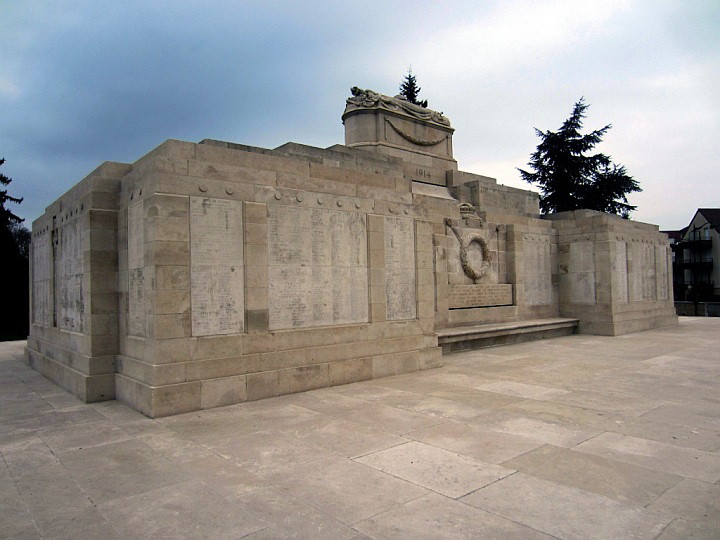
The La Ferté-sous-Jouarre Memorial commemorates 3,740 officers and
men of the British Expeditionary Force [Note]
who fell at the battles of Mons, Le Cateau, the Marne and the Aisne
between the end of August and early October 1914, and who have no
known graves.
――――♦――――
JOSEPH POULTON
Private, 1st Bedfordshire Regiment. Service no. 7677.
Born in Tring.
Son
of James and Eliza, husband of Alice Rose (formerly Final).
Father of Joseph James, born 28th September 1910.
Died of head wounds sustained at Mons, Belgium, at a Military
Hospital in Glasgow
on the 31st October
1914, aged 28.
Buried in Lambhill Cemetery, Glasgow. Grave reference L.1146A
Joseph Poulton was born on October 23rd 1886, the son of James and
Eliza Poulton. The 1891 census lists him as living in Brook
Street, Tring, a four year old with his two younger brothers,
William, 3, and John,1. Ten years later his father was a
widower and he was a 15 year old “cowboy on farm”.
In 1903 Joseph joined the army and served in the Bedfordshire
Regiment, 16th Foot. In 1908 he married Alice Rose Final at
Berkhamstead, and on September 28th 1910 their son Joseph James was
born. In the 1911 census Joseph was based at Maida Barracks,
Aldershot, and his wife and baby were living at 8 Western Road,
Tring, with James and four of his sons. As Joseph Poulton was
already a trained soldier he would have been called up at the start
of the war.
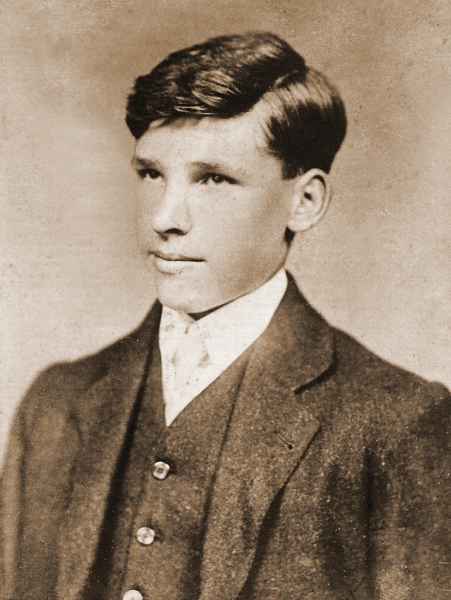
The 1st Battalion was a ‘Regular Army’ battalion, who were based at
Mullingar in Ireland, at the outbreak of war. On mobilisation they
left Ireland as part of 15th Infantry Brigade [Note] in the 5th Division.
The original soldiers of the 1st and 2nd Battalions were amongst the
‘Old Contemptibles’, [Note] the title proudly adopted by the men of the
original British Expeditionary Force (B.E.F.) [Note] who saw active service
before 22nd November 1914. They were the professional soldiers of
the British army, almost all of whom were regular soldiers or
reservists. They took their honourable title from the famous ‘Order
of the Day’ allegedly given by Kaiser Wilhelm II [Note] at his headquarters
in Aix-la-Chapelle on the 19th August, 1914:
“It is my Royal and Imperial Command that
you concentrate your energies, for the immediate present upon one
single purpose, and that is that you address all your skill and all
the valour of my soldiers to exterminate first the treacherous
English; walk over General French’s contemptible little Army.”
No documentary evidence appears to have survived verifying the
Kaiser’s order so whether the phrase was the result of propaganda or
not is open to debate.
The 5th Division landed in France on 16th August 1914 as a part of
Haig’s II Corps [Note] and fought in the early engagements of the war.
They were engaged at the Battle of Mons – where Private Poulton was
wounded – in August and fought during the stand at Le Cateau, where
five Victoria Crosses were won by their division. After
service during the battles of the Marne and the Aisne, the Division
was rushed north to Flanders where they were involved in the battles
of La Bassee followed by the First Battle of Ypres. By the end
of November the division had suffered 5,000 casualties
The Battle of Mons (23rd August 1914) was an action between
British and Germany forces on the French/Belgian borders and was the
first major action fought by the B.E.F.
in the First World War. During the action the British
attempted to hold the line of the Mons–Condé Canal against the
advancing German 1st Army. [Note] Although the British fought well
and inflicted disproportionate casualties on the numerically
superior Germans, they were forced to retreat due to the greater
strength of the Germans and the sudden retreat of the French Fifth
Army, which exposed the British right flank, leaving the Mons canal
line in German hands.
During the action the German infantry suffered heavy casualties when
attacking the British positions. The rude shock received by
the British Army in the Boer War (1899-1901) had caused it to
remodel its training, placing an emphasis on the importance of small
arms marksmanship and weapon handling. Regular musketry
courses brought skills to a level where British infantrymen were
capable of firing up to 30 rounds a minute of aimed rifle
fire (compared to the standard of 12 rounds a minute). Their
rate of fire at Mons gave the Germans the impression that
the British were armed with many more machine guns than they
actually possessed.
Total British casualties from the fighting along the Mons Canal Line
were around 1,500 killed wounded and missing, while the equivalent German
casualties are thought to have been around 5,000. But these losses were to prove insignificant
compared with the casualties sustained by both sides in later battles of the war.
The following extract is from the 1st Bedfordshire’s War Diary: [Note]
23 Aug 1914 - [The Battle of
Mons] Wasmes/Paturage About midday ordered to go with 1/2
Battn. to WASMES to select & dig trenches. No immediate
fighting expected. Started trenches. Men unexpectedly
shelled; enemy attacked in afternoon & we had a few casualties.
C.O. Recalled personally & sent with remainder of Battn. to take up
line between Dorsets & next Division near PATURAGE. 1/2 Bn. at
WASMES to join Hd Qrs of Bn. Reached Paturage after dark.
No trace of Division on right. Enemy reported by inhabitants
approaching in force on road on right flank. Sent out officers
patrol & located enemy temporarily halted; next Division’s left
found nearly 2 miles to right rear. Reported situation by
breaking into railway Station & using telegraph & telephone.
Gen. HAKING [Note] sent up with 3 Battns. to fill up gap on our right.
Also gap between Dorsets on our left, & ourselves: this gap
eventually lightly held by parties from each of the two Regts., 2
Companies Bedfords at WASMES were unable to disengage from enemy
until after dark, when they moved to join Hd Quarters at PATURAGE,
arriving there before daybreak. Enemy attacked soon after
daylight, ‘C’ Company holding houses & bridges on railway line first
to be engaged, eventually driven back slowly as houses knocked down
by shells.
24 Aug 1914 - 2 miles west of Bavay Enemy
attacked strongly on our right which rested on high heap of slag
(this mound was occupied by other units under Gen. HAKING), which
shut out all view to that flank. Found about 11 a.m. that the
Battns under Gen. HAKING had either withdrawn or retired leaving our
right in the air, with enemy in close proximity. Reported
situation to Brigadier 15th Bde. Battn commenced retirement
westward in 3 columns, covered by small rear guard. Then moved
S.W. to .... A considerable portion of the Battn. detached in action
not yet rejoined. Our casualties Capt. Millery [John McMaster
MILLING], Lt. Shearman [Charles Edward Gowran SHEARMAN] wounded about
66 other ranks killed, wounded & missing. On arrival at ATHIS
with rather more than half Battn. (men very tired & footsore) at once
called upon as escort to Artillery moved about 2 miles with guns
preceded by Cavalry towards wood. Extended men over open
cornfields. Guns at once moved; again moved men. R.A.
officer galloped up & said guns unable to remain as cavalry had
passed. Left in air without orders. Retired slowly &
formed up under cover. Proceeded towards Bavay & found rest of
Battn. holding road. Moved south & rejoined remainder of 15th
Brigade 2 miles W. of BAVAY. Left bivouac about 3.30 a.m.
25 Aug 1914 - le Cateau [The Retreat to Paris]. Retired to Le Cateau: troops very tired. On
arrival Battn. set to work to improve existing trenches.
Brigade with main body & out of touch with enemy.
From the Bucks Herald, 7th November 1914:
“Another
Tring man has given his life for his King and country. We regret to
have to announce the death of Private Joseph Poulton of the 1st
Bedfordshire Regiment, who, as announced last week, was wounded at
Mons. He was brought to the Military Hospital at Glasgow, where he
was visited by his father and his wife. He was badly wounded in the
head, and died in the hospital on Saturday last.
Private Poulton, who was only 28 years of age, was the son of Mr.
James Poulton of Western-road, himself an old soldier. He entered
the army when quite young, and at the time he left was a first-class
gymnastic instructor. When he returned to Tring on completion of his
army service, he obtained employment at the Tring Post Office, and
was generally liked for his quiet demeanour and careful discharge of
his duties. He took a great interest in the Y.M.C.A. gymnasium,
where he rendered valuable assistance as an instructor; he also took
a prominent part in the public exhibitions given by the gymnastic
squad. The greatest sympathy is expressed on all hands with his
father, and with his young wife, and their only child.
Private Poulton was buried at Glasgow on Wednesday, at 2 o'clock. At
the time the funeral was taking place a memorial service was held at
Tring Parish Church, and was attended by the deceased’s wife
[Alice Rose], his father, his
brothers, and other relatives. Mr. John Bly represented the Y.M.C.A.
Messrs. A. J. Howlett and F. J. Tomkins (supervisors), Thatcher,
Miss Chuter, and other members of the clerical staff at Tring Post
Office, and several postmen in uniform were also present.
The funeral bell was tolled before the service, and Mr. Lionel
Thornell played some appropriate music. The service commenced with
the hymn ‘Jesu, lover of my soul,’ and the introductory part of the
service was said by the Rev. Guy Beech. The lesson, read by the Rev.
H. E. U. Bull, was followed by the hymn ‘On the Resurrection
morning.’ Some prayers from the Burial Office, and petitions for our
sailors and soldiers, and for those in sorrow and bereavement, were
said by the Vicar. The service was a simple and impressive one, and
many friends and neighbours attended to show their sympathy.”
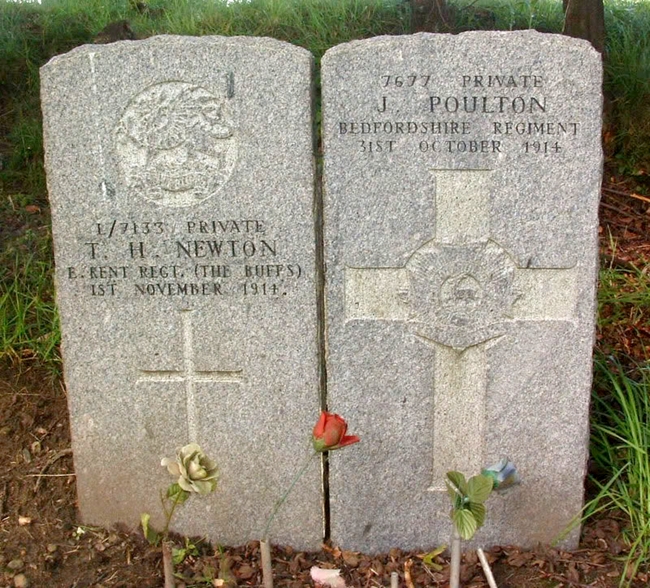
Glasgow was one of the ports of embarkation for the British
Expeditionary Force in 1914 and several military hospitals opened in
the city during the First World War, including the 3rd and 4th
Scottish General (1,200 beds each), and the Merryflats War Hospital
(500 beds). Glasgow (Lambhill) Cemetery contains 114 scattered
burials of the First World War, 123 from the Second World War and
one Norwegian war grave.
――――♦――――
JOSEPH POULTON
Private, 2nd Northamptonshire Regiment. Enlisted at Watford.
Service no. 27365.
Born in Yiewsley, Middlesex, later of Albert Street, Tring.
Husband
of Ethel Allibone, formerly Pouley of Tring.
Died on the 14th November 1917, aged 31(?), after having been
gassed.
Buried in Bailleul Communal Cemetery Extension, Bailleul, France,
grave ref III E 62.
The Northamptonshire Regiment was formed in July 1881 out of the
old 48th (Northamptonshire) Regiment of Foot (which became the
1st Battalion), and the 58th (Rutlandshire) Regiment of Foot
(which became the 2nd Battalion). The 2nd Battalion was in
Egypt when war broke out. On their return home in October
1914 they joined the newly formed 24th Infantry Brigade in
the 8th Division, arriving at Le Havre on the 5th November
1914. Thereafter − except for the period October 1915 to
July 1916 when the brigade [Note]
was exchanged with the 70th Brigade in the 23rd Division
− the Battalion remained in the same brigade throughout the war,
engaging in actions that included:
1915: control of the front line at Ferme Grande
Flamengrie to the Armentieres-Wez Macquart road and at Bois
Grenier.
1916: The German Attack on Vimy Ridge, The Battle
of Albert.
1917: The German retreat to the Hindenburg Line,
The Battle of Pilkem, The Battle of Langemarck.
1918: The Battle of St Quentin, The actions at the
Somme crossings, The Battle of Rosieres, The actions of
Villers-Bretonneux, The Battle of the Aisne 1918, The Battle of
the Scarpe, The Final Advance in Artois.
Armistice: the Battalion ended the war at Bermissart west of
Mons, Belgium.
Private Poulton was reported killed on the 14th November 1917
after having been gassed. According the the 2nd
Northamptonshire War Diary, [Note] the Battalion were at the
time in the line at Warneton, Belgium. There is no report
in the War Diary of a gas attack on the 14th, but gassing
did result in two fatalities on the preceding day.
However, the report in the Bucks Herald (below) – “News
was recently that Poulton has been gassed and was dangerously
ill” – suggests that Private Poulton did not die
immediately, but was the victim of an earlier gas
attack:
“11.11.17: 2 Lt Collier joined
the Battalion – L mist
during the day. Reserve Coy. at Prowse Point heavily shelled
by gas shells at night – no casualties.
12.11.17: Lt Bonfield returned from course. L mist
during day. Coy in La Basseville heavily shelled
with gas at night. Casualties two badly gassed, died the
following day.
13.11.17: Captain A. D. Middleton – 2 Lt Robertson
returned from Brigade School at Canteen Corner. The
battalion were relieved by the 37th Australian Battalion in the
line. Relief complete 1.30 a.m. The Battalion arrived at
Menegate camp at 4.30 a.m.
14.11.17: 2nd Lt A. L. Livesey went with advance party to
take over at Le Trois Firmes. The Battalion paraded for kit
inspection. 2nd Lt Fitzhugh joined the Battalion.”
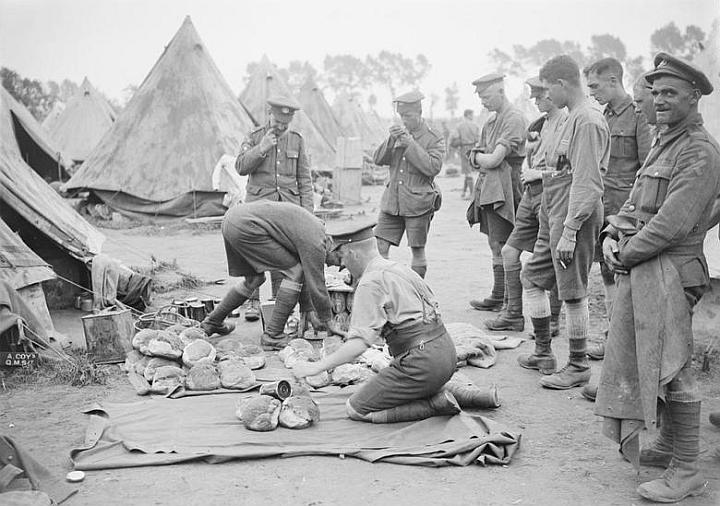
Northamptonshire Regiment troops
withdrawing rations from the Quartermaster’s Store.
From the Bucks Herald 24th November 1917:
“Pte. Joseph Poulton, of Albert-street,
joined the 2nd Northants Regiment in August of last year, and
proceeded to France after a short training. News was
recently that Poulton has been gassed and was dangerously ill,
and on Sunday morning last his wife was officially notified that
he had passed away. [The] Deceased, before the war,
was employed for some two years as assistant at the Tring
Co-operative Stores, and was highly esteemed by the management
and the members alike. He was 31 years of age and leaves a
widow and three children, for whom the deepest sympathy is felt
in their great loss.”
From the Parish Magazine January 1918:
“Joseph Poulton Private
Northamptonshire Regiment, was killed on 14th November 1917. He
enlisted in August 1916. His widow has received a
comforting letter from the Chaplain, who speaks in high terms of
Poulton’s devotion to duty. He was buried in a quiet
cemetery behind the lines. The order for battle for the
attempted offensive in the autumn of 1917 recommends the
preparation of burial space in cemeteries within a 15 mile
radius, to accommodate a possible 10% casualties.
Joseph Poulton lost his life in the area of Langemarke and
Zonnebeke. This area had been heavily fortified with
reinforced concrete bunkers, connected by tunnels. The
Germans were situated on higher ground, while our troops were in
a morass, into which, drainage ditches from the surrounding
higher ground flowed. The two watercourses, the Steenbeek
and Zonnebeke, were not flowing and draining the area, hence the
morass. It was impossible for our troops to dig a defensive
system of trenches. They therefore built revetments from
wattle hurdles and sandbags and connected shell holes.
Although the shell holes were filled with stagnant water they
laid duck boards over the mud, which allowed our troops to move
under reasonable cover. During the ensuing fighting many
of our soldiers drowned and were never seen again if they fell
in the water-filled shell holes.”
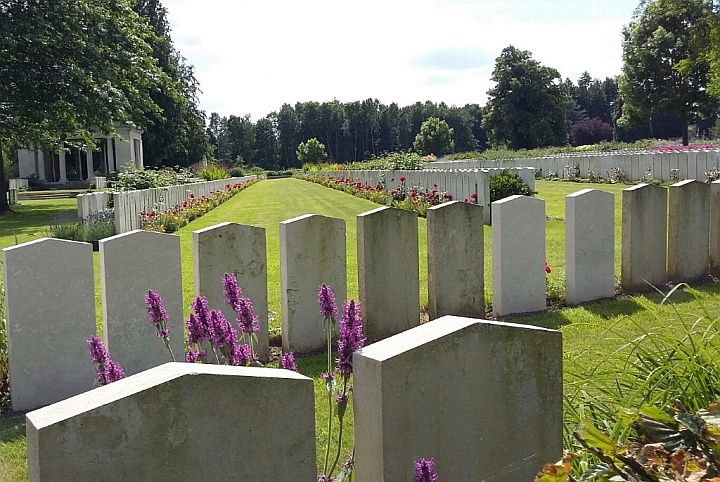
Bailleul was occupied on the 14th October 1914 by the 19th
Brigade and the 4th Division. It became an important
railhead, air depot and hospital centre, with the 2nd, 3rd, 8th,
11th, 53rd, 1st Canadian and 1st Australian Casualty Clearing
Stations quartered in it for considerable periods. It was
a Corps headquarters until July 1917, when it was severely
bombed and shelled, and after the Battle of Bailleul (13th-15th
April 1918), it fell into German hands and was not retaken until
the 30th August 1918.
The earliest Commonwealth burials at Bailleul were made at the
east end of the communal cemetery and in April 1915, when the
space available had been filled, the extension was opened on the
east side of the cemetery. The extension was used until
April 1918, and again in September, and after the Armistice
graves were brought in from the neighbouring battlefields and
burial grounds.
Bailleul Communal Cemetery Extension contains 4,403 Commonwealth
burials of the First World War; 11 of the graves made in April
1918 were destroyed by shell fire and are represented by special
memorials. There are also 17 Commonwealth burials of the Second
World War and 154 German burials from both wars.
――――♦――――
SIDNEY RICHARD PRATT
Private, 53rd Australian Infantry, Australian Imperial Force,
service no. 2641.
Born in Marsworth. Son of Thomas and Annie of ‘Rose Cottage’,
Longfield Road, Tring.
Killed in action at Fromelles on the 19th July 1916 aged 30.
No known grave. Commemorated on VC Corner Australian Cemetery
Memorial,
Fromelles, France, panel 9.
Private Pratt was killed in action in the Battle of Fromelles
(19th–20th July 1916), a military operation on the Western Front
[Note] that became one of the
greatest tragedies suffered by the Australian nation during the
20th century (see also
Harry Prentice). The Germans were forewarned of the attack
and, without the advantage of surprise, the attack turned into a
slaughter.
|
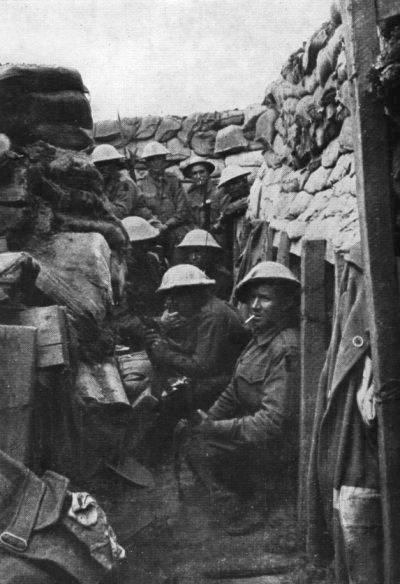 |
|
Soldiers of the 53rd
Battalion, Australian 5th Division, waiting to
attack during the Battle of Fromelles, 19th July,
1916. Only three of the men shown survived the
attack and those three were wounded. |
As planned, the battle aimed to prevent the Germans moving
troops away from the Fromelles sector to the Somme battlefield
fifty miles to the south, possibly forcing the German High
Command to move more troops from the Somme to support those at
Fromelles. It also aimed to eliminate a salient (the
Sugarloaf) occupied by German forces that gave them observation
over no man’s land on either flank. The attack was
masterminded by Lieutenant-General Richard Haking, commander of
the XI Corps, [Note] one
of the few generals to earn a ‘donkey’ reputation while the war
was still in progress rather than after it.
Two divisions of XI Corps of the First Army took part in the
attacks, the British 61st and the Australian 5th. Both had
recently arrived in France and were devoid of combat experience.
Against them was the experienced 16th Bavarian Reserve Division
(whose numbers are believed to have included Corporal Adolf
Hitler). The infantry attacked at 0600 and was immediately
subjected to intense machine gun fire and shelling in a 300
metres-wide section of no man’s land, four waves of which were
mown down in succession. Some Australian soldiers
succeeded in penetrating the German lines, but they were quickly
isolated and subjected to counter-attacks. No man’s land
became filled with the bodies of dead and wounded, some likening
the macabre scene to a giant butcher’s stall.
In spite of the initial failure a second attack was launched at
9 a.m. Totally isolated after a night in the German
trenches, the Australian survivors of the first attack attempted
to regain their lines on the morning of the 20th July, but the
enemy’s machine guns once again took many casualties. In a
period of twenty-four hours the Australians lost 5,533 men and
the British 1,400 with absolutely nothing to show for this loss.
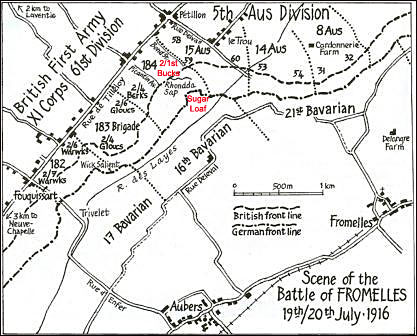
The 53rd Battalion, to which Private Pratt belonged, took part
in the first stages of the attack. It suffered over 600
casualties, including its commanding officer, a total that
equated to around a third of the Battalion’s casualties for the
entire war. Despite these losses the Battalion continued
to man the front in the Fromelles sector for a further two
months.
This disastrous battle was not officially acknowledged in
Britain after the war, such was the level of embarrassment about
it. By the 1920s, when the search for bodies ended, many
Australians were still missing, but in recent years hundreds of
bodies have been located and exhumed around Fromelles. In
some cases, using DNA from descendants, they have been
identified.
From the Bucks Herald 7th October 1916:
“An official intimation has been received
by Mrs. T. Pratt, of Longfield-road, Tring, that her youngest son,
Pts. Sidney R. Pratt, No. 2641, of the Australian Infantry, serving
in France, has been reported missing since July 19. No satisfactory
information of his movements has been received.”
From the Bucks Herald 27th September 1917:
“An intimation has been received by Mrs.
Thomas Pratt, late of Great Farm, Marsworth, and now residing in
Longfield-road, Tring, from the Australian headquarters that her
son, Pte. Sidney Pratt has been missing since July 19, 1916, and
after a court of enquiry it was found reasonable to assume that he
had been killed in action in France on that date, all enquiries
having proved fruitless.
Pte. Pratt was the youngest son of the late Mr. Thomas Pratt of
Marsworth, and his calling was that of a butcher. He at one
time managed a business at High Wycombe for Mr. Evans, of Tring.
He left England for Australia in January, 1913, joined the
Australian Forces in July, 1915, and was sent to Egypt in October,
and from there to Gallipoli in November, where he had a narrow
escape and suffered severely from shell shock. Sent back to
Egypt after the evacuation in December, he was drafted to France in
June 1916.
Mrs. Pratt has been the recipient of a message of condolence from
the King and Queen, besides many enquiries and messages of sympathy
from fiends who knew Pte. Pratt when in England. Mrs. Pratt
has two other sons still serving the Kind. Corpl. Tom Pratt, who is
slowly recovering from severe wounds in hospital in England, and
Pte. Hugh Pratt who is at a base in France doing light duties as a
result of being frostbitten last winter.”
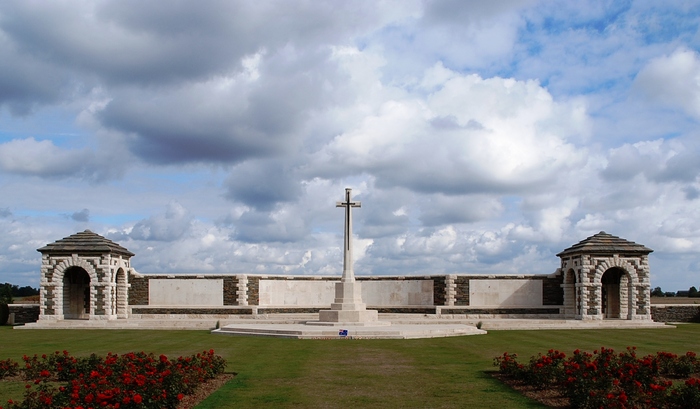
V.C. Corner Australian Cemetery & Memorial, Fromelles, is the
only cemetery on the Western Front in which only Australian
soldiers are interred.
The cemetery was established after the end of the First World
War when the remains of 410 Australian soldiers were brought in
from the surrounding battlefields. At that time none of
these soldiers could be identified except that they were
Australian and believed to have been killed during the Battle of
Fromelles. It was decided to inter these unknown
Australians in this cemetery without headstones. The names
of Australian soldiers missing in action and known to have been
killed during this battle were inscribed on the memorial wall at
the north-eastern end of the cemetery.
In 2010 a new cemetery at nearby Fromelles village was dedicated
at a ceremony on 19th July 2010. This cemetery was
established following the discovery in 2007 of a lost burial
site containing the remains of some 400 Australian and British
soldiers, buried by the German Army after the battle. Of
the re-discovered soldiers buried at Fromelles village, a number
of the missing Australians named on the wall at V.C. Corner
Cemetery have now been identified by DNA processing and reburied
in marked graves at the new Fromelles (Pheasant Wood) Military
Cemetery.
――――♦――――
STANLEY JAMES PRATT
Sergeant (Observer), 48th Sqdn., Royal Air Force, service no.
100029.
Son of Jabez and Rosa Louisa of ‘Woodleigh’, Western Road, Tring.
Killed in action on the 5th July 1918 aged 18.
No known grave. Commemorated on Arras Flying Services
Memorial, France.
No. 48 Squadron of the Royal Flying Corps, [Note]
to which Sergeant Pratt belonged, was formed at Netheravon,
Wiltshire, on the 15th April 1916. The squadron was posted
to France in March 1917 and became the first fighter squadron to
be equipped with the Bristol Fighter, pictured below. [Note]
During the war the Squadron accounted for three hundred and
seventeen kills and possessed no fewer than thirty-two aces.
Topping this list with twenty confirmed kills was their New
Zealand-born commander, Keith Park, then a Major, who later led
No. 11 Group of Fighter Command during the Battle of Britain as
an Air Vice Marshal. The squadron became part of the Royal
Air Force [Note] when the Royal
Flying Corps merged with the Royal Naval Air Service [Note]
in 1918.
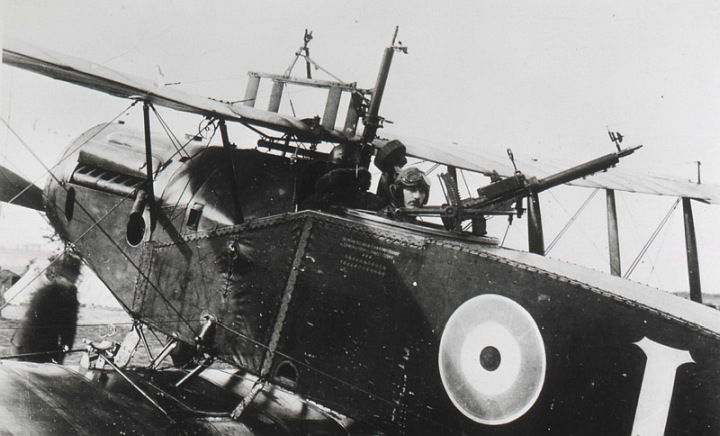
An aircraft of the type in which
Sergeant Pratt was killed. The Observer is in the rear
cockpit.
From the Bucks Herald July 27th 1918:
“Missing. We regret to hear that
Sergeant Stanley Pratt RAF, son of Mr and Mrs Jabez Pratt of
Tring, is reported missing. His Commanding Officer writes
that Sergt. Pratt went on a flight in France in the capacity of
observer on July 5. The machine failed to return, and no
tidings could be obtained of the pilot and observer, so that
doubt still remains as to the safety or otherwise of the gallant
young fellows. There is still the probability that Sergt.
Pratt may be a prisoner in enemy hands. Sincere sympathy is felt
with Mr. and Mrs. Pratt in their period of anxiety and
suspense.”
From the Parish Magazine:
“Stanley James Pratt joined up as a
cadet in the R.A.F on his eighteenth birthday 2nd October 1917
and by the following June was attached as a Sergeant (Observer)
to the 48th SQN. On
the night of 5th July he was sent out on a special night
reconnaissance, and, apparently, he and the Lieutenant Pilot, in
charge of the Bristol fighting plane, [Bristol
Fighter] must have been brought
down by the enemy, for nothing further is known of them except
that they were buried with full military honours by the Germans,
in graves that have been since identified. Extracts from
his last letter, giving an amusing description of a forced
landing in a French village, were published in a recent number
of our magazine. His Major writing to his family, says:
‘Young Pratt, though a mere lad, was a very stout-hearted, brave
observer and would have gone far had he been spared. All
his comrades speak of him as possessing remarkable pluck and
high spirits, and his fellow cadets seemed to have been
impressed by his character and straight life.’ A few days
earlier, his C.O. had informed him that very shortly he would be
sent back to England to take up his commission and would be
promoted to be a pilot.”

The Arras Flying Services Memorial commemorates almost 1,000
airmen of the Royal Naval Air Service, the Royal Flying Corps,
the Australian Flying Corps and the Royal Air Force, either by
attachment from other arms of the forces of the Commonwealth or
by original enlistment, who were killed on the Western Front and
have no known grave.
The memorial was designed by Sir Edwin Lutyens with sculpture by
Sir William Reid Dick. The memorial was unveiled by Lord
Trenchard, Marshal of the Royal Air Force on the 31st July 1932.
――――♦――――
Prentice to Young |
|